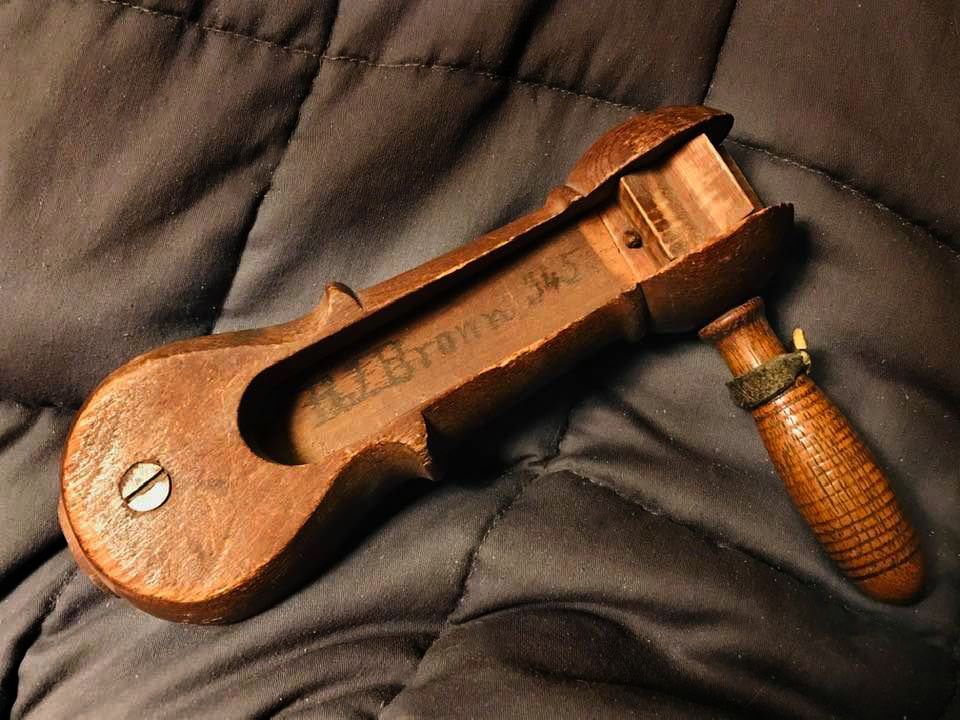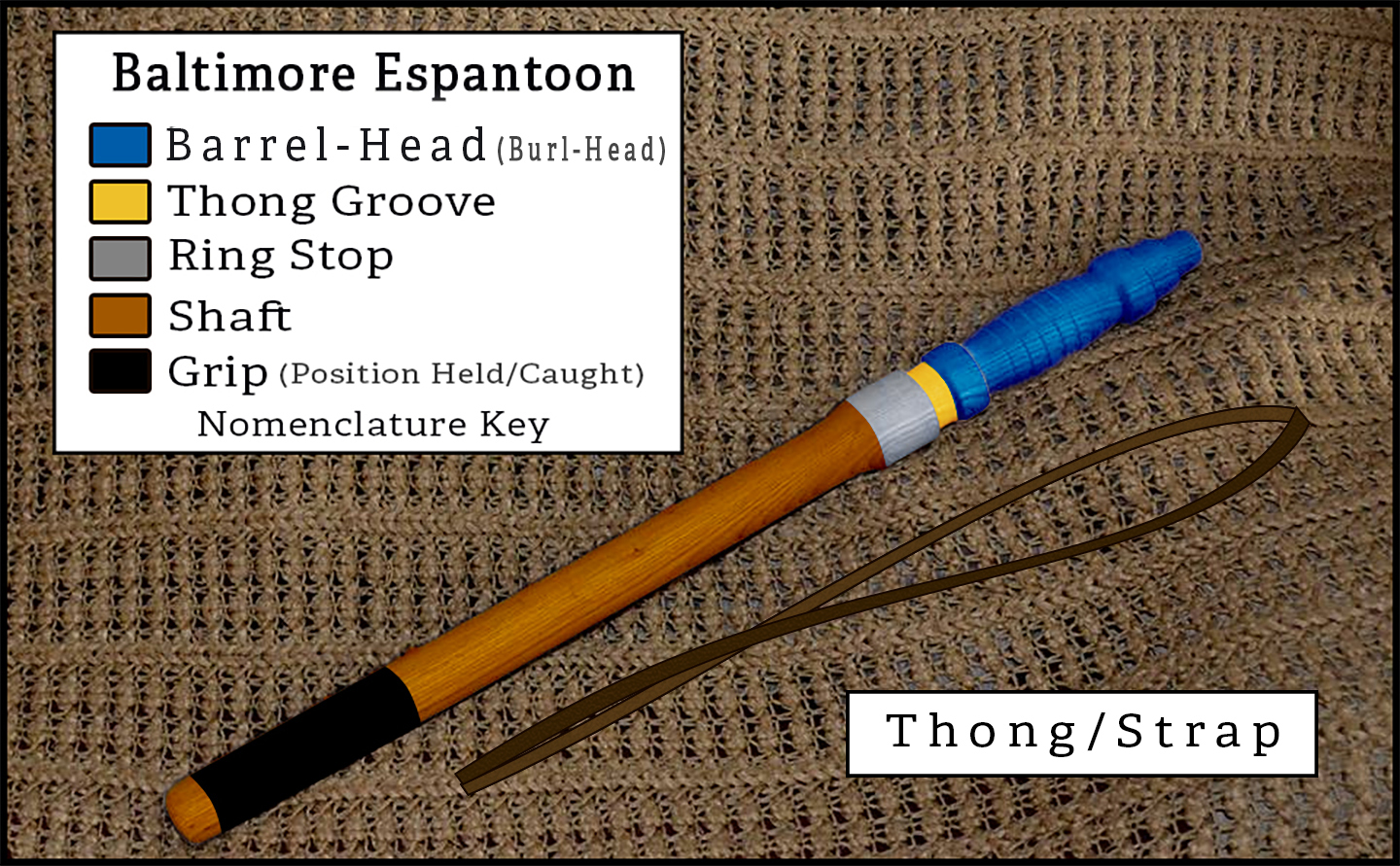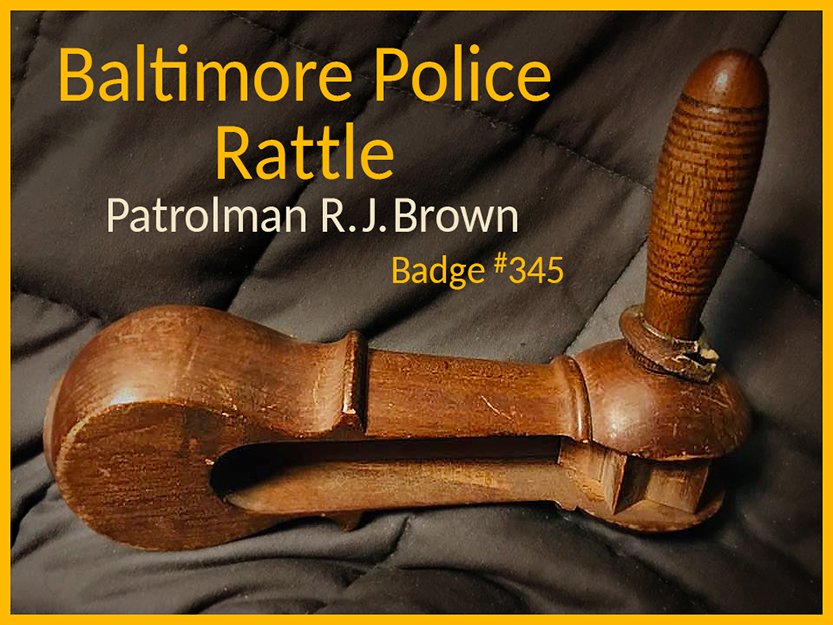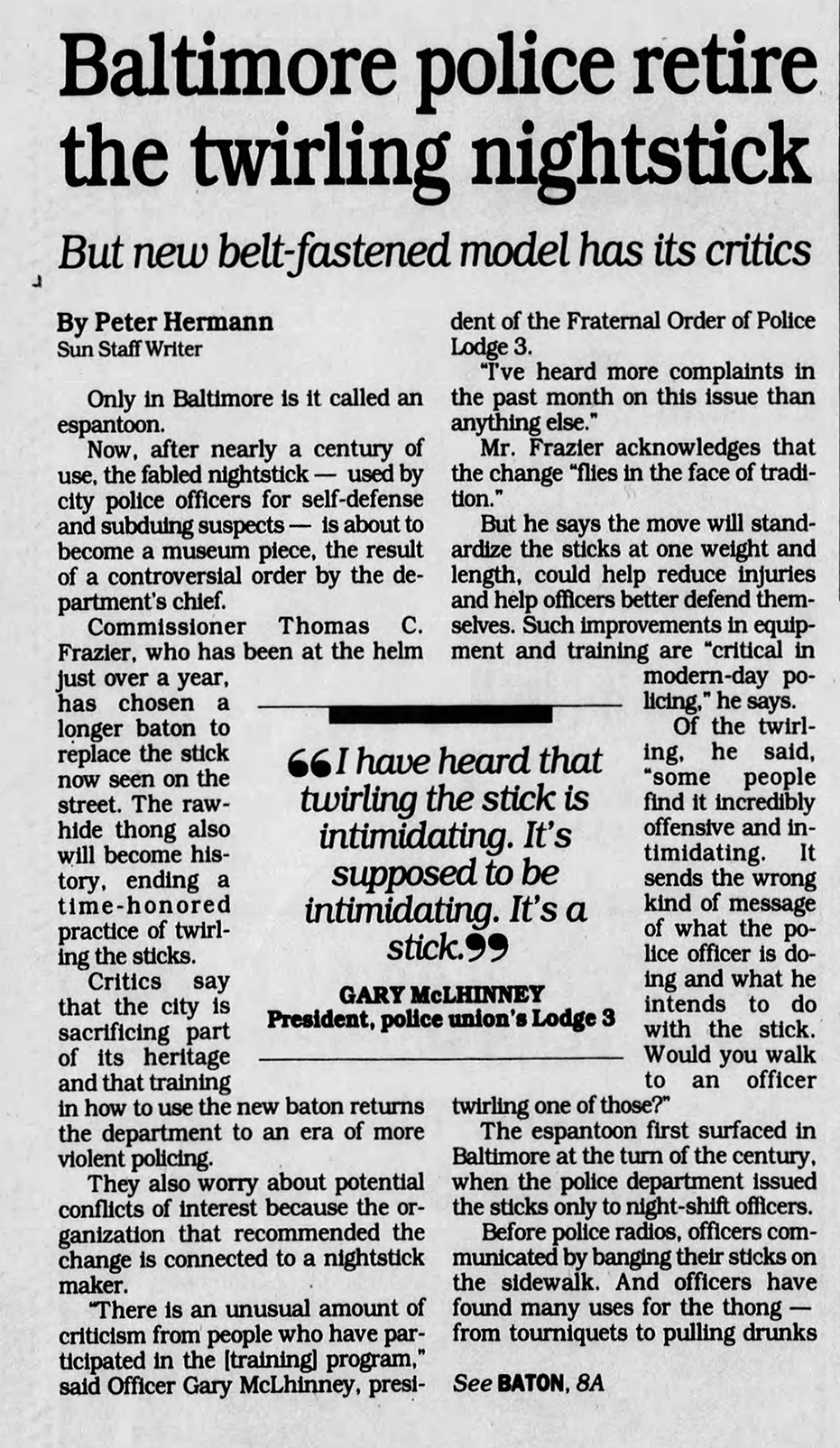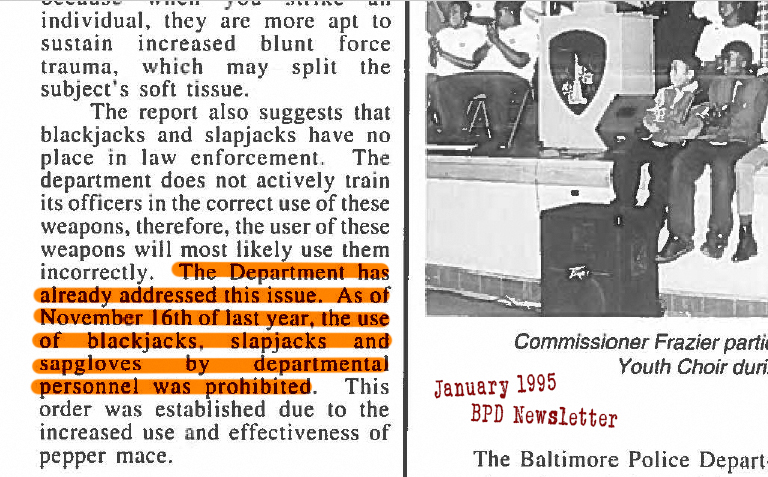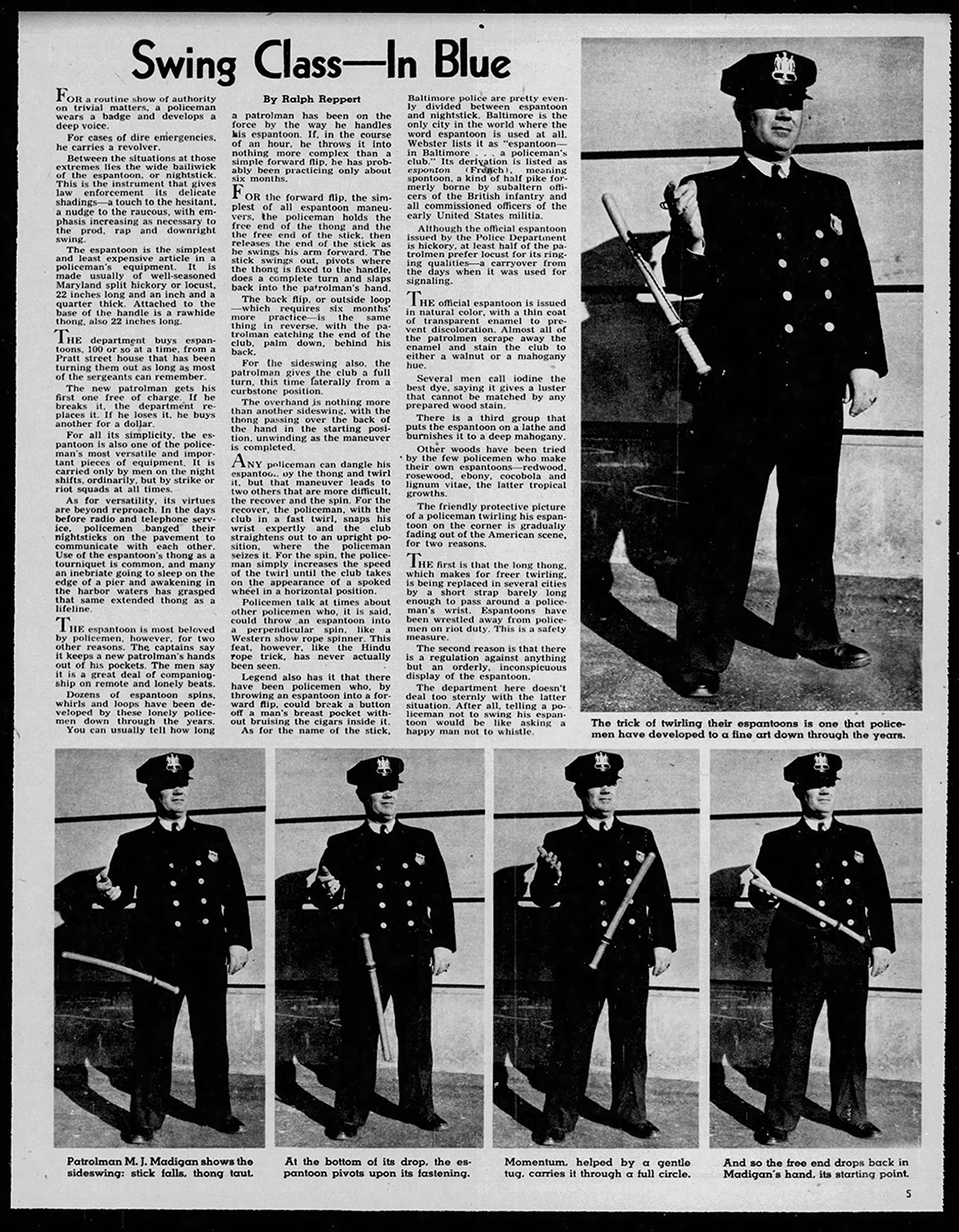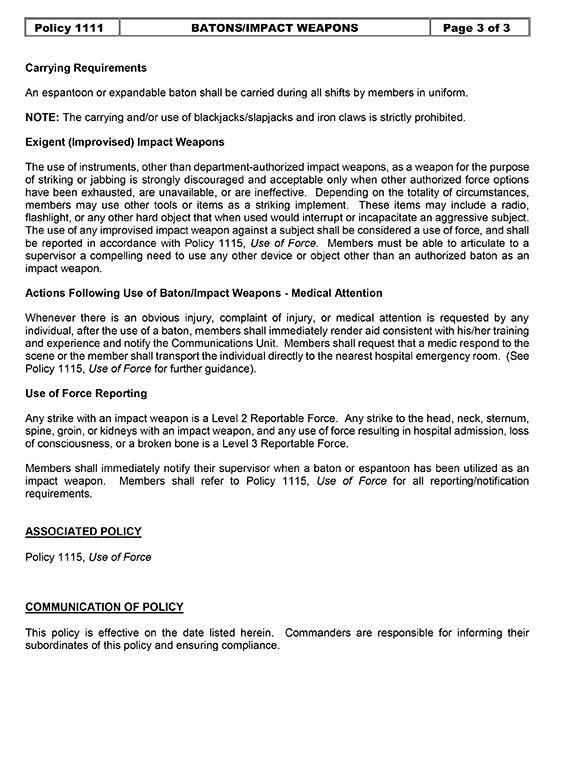Espantoon
 Courtesy Eli Alaman
Courtesy Eli Alaman
22 February 1941: Strike, Baltimore Police
Digital Painting by Ken
Espantoon
Espantoon Info/History
Webster's Third Edition: defines an espantoon as follows: "An espantoon In Baltimore, a policeman's club" We would like to start out by saying we collect nightsticks, espantoons, batons, truncheons, Billy clubs, etc. If you have one for sale or that you would like to donate, please let us know, as we are interested. For what might be obvious reasons, we particularly like the Baltimore espantoon. Aside from their being the stick carried by our brothers and sisters in law enforcement, they also show a progression not just in what we carried or had made, but in what the department had made for us and issued to us. That said, while we like Baltimore sticks, we collect all sticks from any state in the US and from any country in the world.
We have always been serious about the espantoon, and why Baltimore City Police are the only police department in the world that uses an espantoon? Also, why if a Baltimore County Officer and a Baltimore City Officer both have their sticks made by the same guy (let's say Nightstick Joe), why would one guy's stick be a baton or nightstick and the other be an Espantoon? We talked to several old-timers over the years, asking about the nomenclature of our Espantoon. We were told over and over that the part that looks like the handle at the top is actually not the handle and is called the "barrelhead." Next to that or under it is the "Thong Groove," the "Ring Stop," and the "Shaft." The word "barrelhead" might be a mispronunciation that, if correctly pronounced, may have solved this riddle much earlier, but we worked with what we had! For years, we knew the difference; we just couldn't find the words to explain it. That was, up until the night Ken read the reporter's question while reading a newspaper article one night. It was that question that flipped the switch in Ken's mind, and once it was, it was like the old saying, "It couldn't be unseen!" Now it seems we have more ways to describe or answer the question. So what was the 1970's newspaper man's question? He asked, "If a Baltimore City Officer gifts his Espantoon to a Baltimore County Officer, is it still an Espantoon?" The answer in Ken's eyes was, "No," and as odd as it may sound like so many police issues, it all comes down to training. For years, when asked what makes an Espantoon an Espantoon, the satisfactory answer was, "Webster's 3rd edition dictionary says it is!" That has not been acceptable to us, so we dug further, reading every newspaper article, every general order, and every policy. We talked to retired officers, active officers, rookies, and old timers. Doing so gave us what we think is the truest of all answers. Baltimore turns a nightstick into an Espantoon because what looks like a "handle" is the "barrelhead" (most likely originally pronounced "burlhead"), whereas everywhere else in the world the part that looks like a handle is a handle, but in Baltimore City, we turn the stick around, and that handle-looking part as the striking end. If a city and county officers traded sticks, they would each take their new stick and use it according to their departmental guidelines and training, one having a nightstick with a handle and the other having an espantoon with a barrelhead or burlhead. That is what makes a Nightstick an Espantoon.
What follows is some supporting documentation on the subject.
As for the old answer to What makes an espantoon? A name for a nightstick that is only used by the Baltimore police. Here is the old answer from that pages of Webster's 3rd edition:

![]()
Rattles and Billy Clubs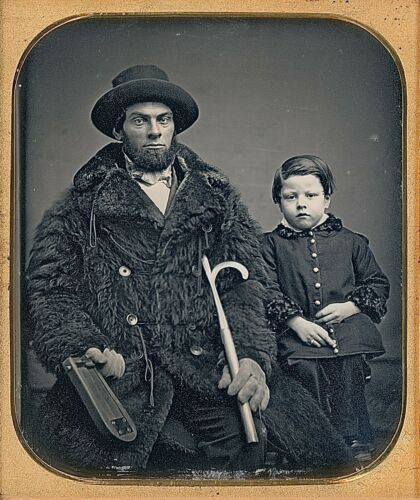
Rattle/Ratchet and a Short Spontoon
Rattle, circa 1862
These rattles were used by police and firefighters to signal coworkers. At the time, they were made by violin makers. Watchmen carried these and a short spontoon.
Rattle/Ratchet and a Short Spontoon
This daguerreotype features a bearded watchman with his wooden Rattle and a Spontoon or Club. He wore a bearskin coat, woolen gloves, and hat to protect himself from the cold nights of patrolling. He is seated next to his young son, who also wore a heavy winter coat.
This is NOT Baltimore, but the use of a Spontoon, could be a start to the origins of Espantoon, perhaps deriving from "A Spontoon" later becoming "A-Spontoon" then to one word "Aspontoon", and eventually spelled "Espantoon." There were newspaper articles with it spelled Aspontoon, Espontoon, and Espantoon.
In an 1844 Sun paper article describing the Line of Duty Death Night Watchman Alexander McIntosh, it says, “McIntosh was struck with a Spontoon, and it was later said, McIntosh lost his Spontoon." That later came to mind when he learned McIntosh was struck with a Spontoon.
Click HERE to Read Article
Click HERE to Read Article
It All Started with a Police Rattle
Click HERE to Learn More
![]()
We had a difficult time explaining what made an espantoon an espantoon until reading that 1970's Sun Paper newspaper article that asked, "If a Baltimore City officer gave his espantoon to a county officer, would it still be an espantoon?" This single question sparked the answer, which we've known for years but had trouble wording our answer into a reasonable explanation. Baltimore Police Department's General Orders, or what today is known as Baltimore Police "Policy," specifically Policy number 1111, the Espantoon is defined as follows: A wooden Baton between 22-25 inches in length, with the striking end of the baton being between 1-1/2 and 1-3/4 inches in diameter and the grip end being 1-3/8 inches in diameter. This means our nightstick has a "Burlhead." But what if the county officer simply turned his baton around? Wouldn't that make it an espantoon? Well, in theory, it would, except that in Baltimore City, this can be done under Policy 1111, and remains within the officer's training; in the county, the officer would be going against his or her training, and therefore, not only would it not be an espantoon, but the officer could be charged and lose his or her job. So part of it not just that we turn it around, it, is that it is within our agencies rules and our training that we use it this way, and that is what makes our baton an espantoon.
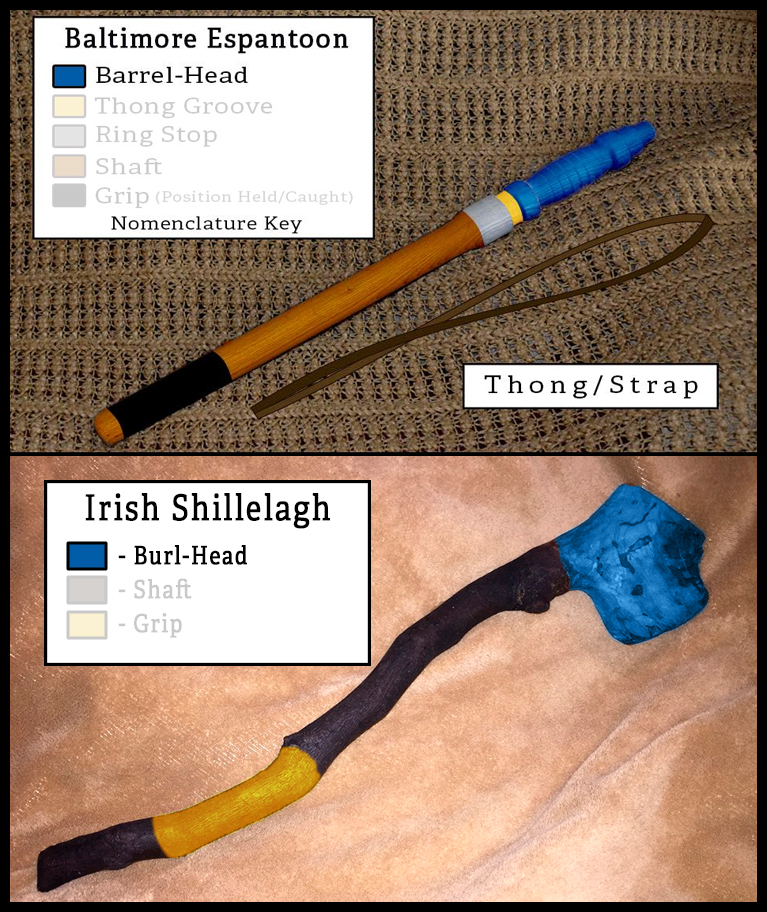 Woodworkers that Turned Baltimore Espantoons
Woodworkers that Turned Baltimore Espantoons
1937 / 2007
1937 / 1957 – Rev W. Gibbs McKenney - Made BPD Issue - Sold to Howard Uniform - 10,000 hickory 2,000 redwood over 20 yrs
1957 / 1977 – Rev. John D. Longenecker - Made BPD Issue - Sold to Howard Uniform - 10,000 hickory 2,000 redwood over 20 yrs
1955 / 1979 – Carl Hagen - Made BPD Issue & his own Stick - Sold to Howard Uniform and Officers - 2.000 various wood types over 24 yrs
1974 / 1977 – Edward Bremer - Made his own Stick – Sold to Officers - 300 various wood types over 3 yrs
1977 / 2007 – P/O Joe Hlafka - Made his own Stick - Sold to Officers and Police Supply Shops - 10,000 various wood types over 30 yrs
![]()
5,500-Year-Old Wooden Clubs Were Deadly Weapons
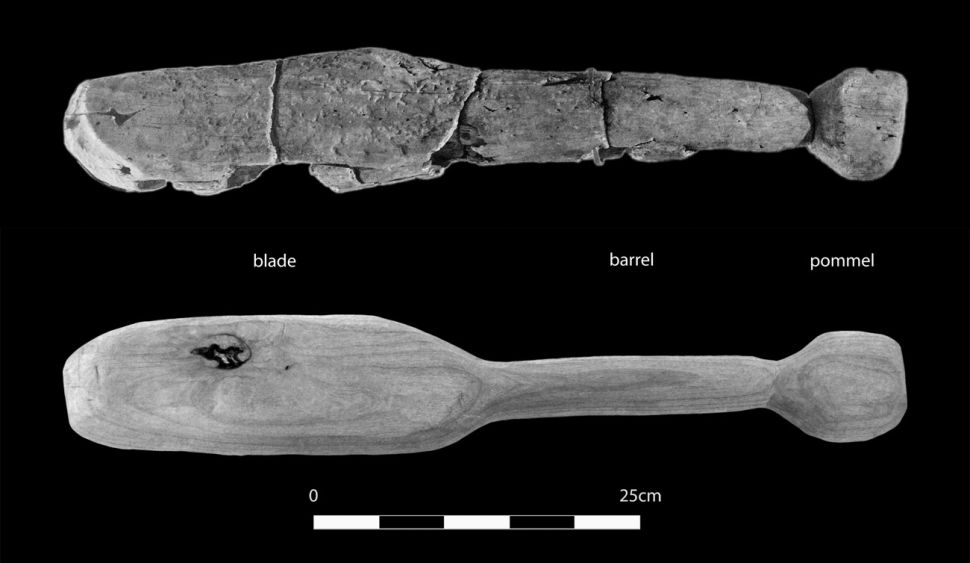 Oldest known Club
Oldest known Club
Carbon dated to 3530-3340 B.C.
Wood typically does not preserve well in the archaeological record, but the Thames beater was pulled out of the waterlogged soil on the north bank of the Thames River in the Chelsea area of London. It has been carbon dated to 3530-3340 B.C. and is now housed HERE in the Museum of London. Dyer described the club as a "Very badly made cricket bat," but much heavier at the tip.
Dyer enlisted a friend, a 30-year-old man in good health, to do the bashing, and told him to swing as hard as he could at the "skulls," as if he were in a battle for his life. The resulting fractures resembled injuries seen in the real Neolithic skulls. One fracture pattern closely matched a skull from the 5200 B.C. massacre site of Asparn Schletz in Austria, where archaeologists had previously speculated that wooden clubs might have been used as weapons. "We didn't go out aiming to replicate a particular injury, and when we got that fracture pattern, we were quite excited," Dyer said. "We knew right away that we had a match there."![]()
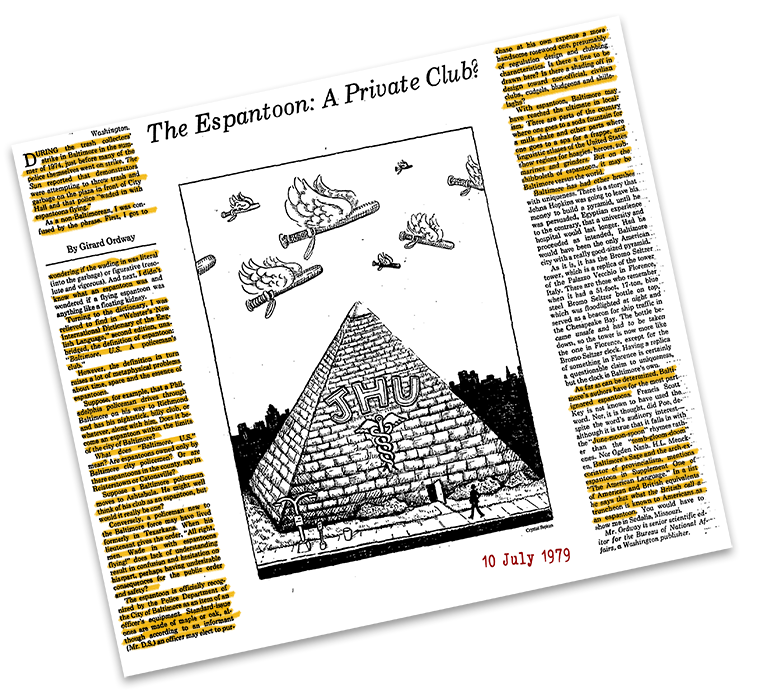
Above is the article that best helped us put our answer into words about what makes an espantoon an espantoon. To read the full article, click on the picture above, and it will take you to the article. You can click on it after it opens if you need to zoom in.
![]()
Do our sticks measure up?
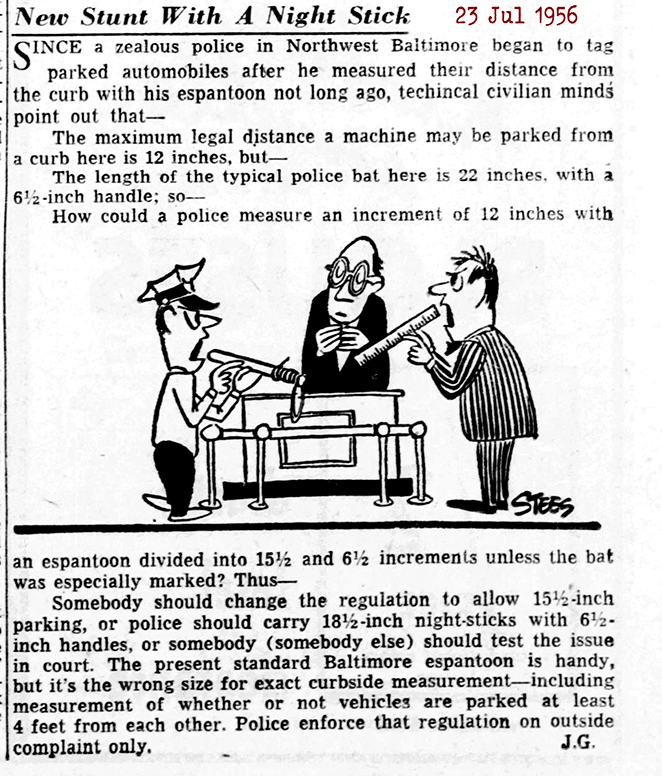
![]()

Baltimore Sun, August 3, 1956 As we know, our police are not striking with the "handle end"; they strike with the "barrel head" per their training, General Orders, or Policy #1111. As you look through the photos on this page, you'll see that, as far back as we could find, officers carried their sticks in a way that would have them holding the handle end of the shaft and swinging the "barrel head," often confused as the stick's "handle end," which demonstrates that this is how Baltimore police have always done this and what makes a nightstick an espantoon.
![]()
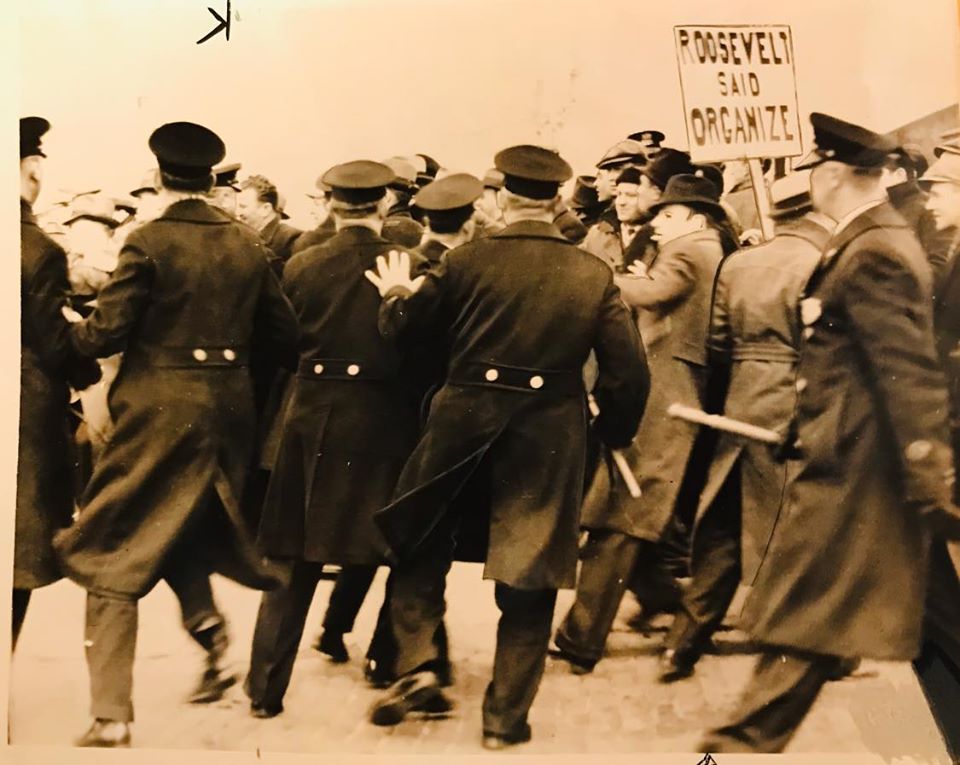
18 February 1937: Taxi Strike
Notice that in both places where we can see the espantoon, the officers are holding the Barrel Head out

Courtesy Robert Oros
Nice espantoon picture showing a nice Baltimore Police Espantoon.
Also notice it is held at the shaft with the Barrel Head / Striking end out ![]()

The blue portion of the espantoon in the above illustration is most often mistaken for the handle of the stick but is actually the striking end. It is called a barrelhead; this most likely comes as the result of an error in pronunciation, as in many blunt force weapons, the striking end is called a "burlhead." As in the Tomahawk and other such weapons, the blunt end can either be added or carved into the weapon. But here in Baltimore, with years of mispronunciation and a slight southern drawl, Burl sounds more like Barrel. So Burlhead became Barrelhead. A funny thing to add to this is that the shape of the Espantoon's burl head is also kind of shaped like a wine barrel, which added to the error. Now, in the same way, the JEEP a military vehicle that also has ties to Baltimore, has a name that was derived from the letters G.P. for General Purpose. G.P. said often enough and fast enough that it took on the sound of JEEP and long before it was manufactured and marketed as the JEEP it became JEEP and would have, with or without the JEEP's we know been forever called a Jeep; likewise, the Burl Head on the striking end of our espantoon will now and forever be called a Barrel Head
![]()
Teaching young officers how to spin the Espantoon
was Sgt Edwin Schillo
In the 1980s, those that went through the police academy were lucky to have an instructor named Sgt. Edwin Schillo. Sgt. Schillo took his own time during lunch breaks to teach any student that wanted to learn the art of spinning their Espantoon. I would bet for every stick Nightstick Joe Hlafka made during those days, Sgt. Schillo showed them not just how to use it to defend themselves but also how to spin it at the end of its leather strap, also known as the thong. So, we give special thanks to Sgt Edwin Schillo for the time he took to keep and the art of spinning the Espantoon to so many young police.
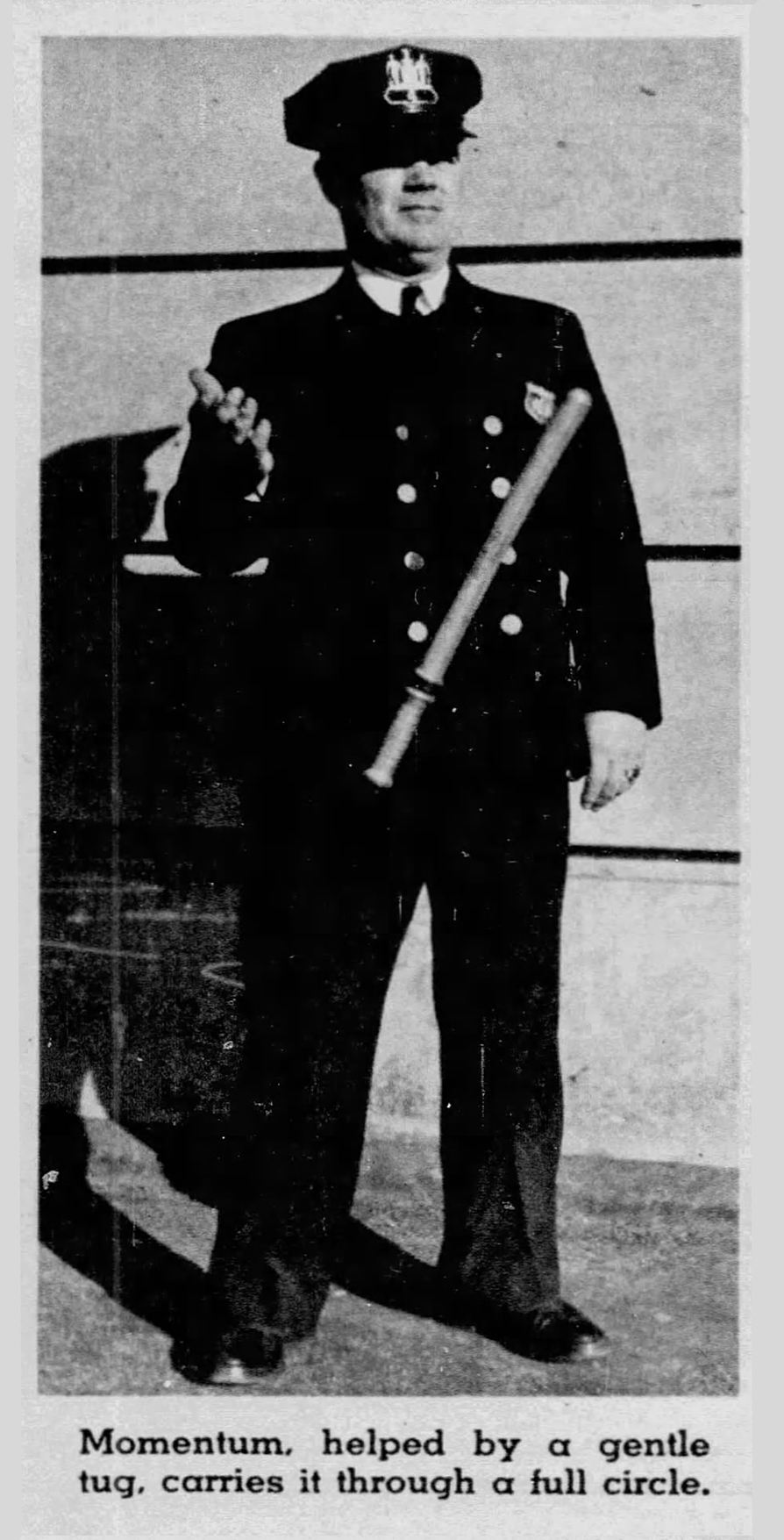
![]()
An illustration with a key shows the often mistaken handle, which is in fact the striking end.
What is an ESPANTOON
Nomenclature of the Espantoon
To be clear about the barrel-head and other parts of the espantoon, we took a Joseph "Nightstick Joe" Hlafka espantoon and painted the various parts using a color key and the nomenclature with a color key. Using BLUE for the barrelhead, or burlhead above, we can see how the barrelhead could be confused for a handle. We can also see how some old-timers might think it resembles a wine barrel and believe it could be why it was so named. When I was a young officer being told the parts, the old-timer actually said, "This is called the barrelhead; if you look, you can see it looks like an old wine barrel." If we look at the part painted YELLOW we see what is known as the "thong groove." This is where we weave a leather thong, and the groove serves to keep the leather strap or thong from slipping off the stick. Under the thong groove, we see a part we have painted GREY. This, aside from being part of the "thong groove," is known as the "ring stop" and is used to prevent the espantoon from sliding through the nightstick ring on an officer's belt. Under the "ring stop" is the "shaft. We left this stained the color of the stick until we reached the "grip. On some sticks, the grip can be turned into the stick, but most often it is just the part of the stick we feel most comfortable catching it at. It could be balanced differently for everyone. In the picture, we can see the thong or strap, which is used differently. For me, I like to loop it over my ring finger. I have seen some look it over their middle finger, others over their entire hand, kind of around all fingers. So we all have to try it different ways to see what is best for us.
Looking at the Pictures below, we can see that by paying attention to what we are doing, we can carry an espantoon in a way that keeps the barrel-head at our ready. Tucked under the weak arm with the grip end extending out toward the officer's back, it leaves the grip end ready for the officer to grab or grip with his or her strong hand in the event that it might be needed. In photo A) we see it is in the officer's strong hand. With the thong over a finger of the strong hand, if needed, he could turn his hand downward, allowing the stick to slide out under its own weight until it is stopped by the strap. Which would put the stick in his hand by the grip end with the striking end out and at the ready. Picture B) is as described above, tucked under the weak arm, ready to be grabbed with the strong hand at the grip end, which would leave the striking end again at the ready. Pictures C) and D) are similar in that the stick is held in the strong hand, with the thong over a finger, and the stick is held at the halfway point, or so, with the striking end pointing forward, allowing the officer to simply loosen their grip while the stick slides forward until the thong stops it from sliding, and the stick would be ready for use. The important thing about picture D) is that the stick is behind the officer's back, so while he is ready, he is not doing anything that could be seen as a threatening move. We can now see why these 4 pictures are a nice representation of how an officer can always be ready to protect himself or the public, but not walk around in a way that might be seen as threatening.
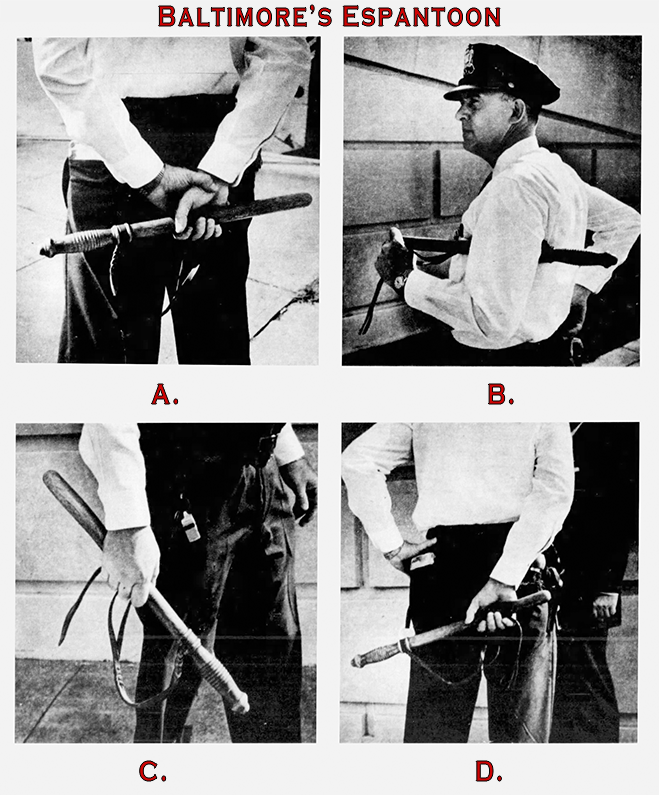
NOTE; We included a few non-Baltimore Police pics just to see how other agencies carry their batons, nightsticks, etc., and how when you carry them the way we carry ours, before long when you see others carrying them upside down and backward, it kind of jumps out to us as odd. This will provide a nice educational moment for those that might be interested, and maybe a little humor for those that don't get it or understand.

In the above picture, the letter "A" is marking off the portion of the stick known as the barrel-head. Notice how much cleaner the middle of the barrelhead is when compared to the shaft, especially the part of the shaft we have marked with the letter "B." The section we have marked with the letter "C" has a line at the top and a line at the bottom. This area, which we marked as area "C" has a lot of dirty hand marks, but it is not as dirty as the section we have marked with the letter "B." To us, this shows the officer handled it often down around that section marked "B," which could be an indication that this officer spun this stick as he walked his post. The constant catch and release of a stick while twirling it would put that portion of the stick in the hand most often. A stick with a light stain and no clear coat will absorb oil from the hands, then pick up and retain the most dirt. Especially when there is no swivel and the stick has to be caught and released more often to keep it going while preventing it from tangling up onto itself. Then, if we look at the stick between the portions marked "C," we can see the stick was carried most likely in the strong hand. Some guys learned to spin or twirl with their weak hand; most just use their strong hand. So this helps us not only date the stick but also prove how it was handled, and every hand print strengthens our feelings that this was a Baltimore-issued espantoon that was spun by a Baltimore officer, because other agencies do not allow an officer to carry an espantoon the way a Baltimore police officer would.
Taking a look at the photo before this, the one where the officer is seen in four variations, we'll see his hand is most often held in the center of the shaft. Now we have to add to the holding of the stick at the shaft what happens when the stick is actually used, either to strike someone, to jab someone, or to pry their arm, perhaps behind their back or from being wrapped around someone's neck or body. It also works to put someone in an arm bar and then to either walk them to the wagon or to cuff them when they are resisting an officer's attempts to subdue them. As long as it is resisting with an intent to flee rather than resisting while assaulting the officer, that determines how an officer reacts. This means an officer's actions are often reactions driven by the subject being arrested.
We'll take a look at these pictures and others to see better what is meant by "carried at the shaft." If we look at the four picture group, in particular the second picture, the one marked with the letter "B," we'll see how the stick was most often tucked up under the officer's weak arm. Unlike the picture most guys saw, including myself, once the stick was tucked under the weak arm, the strong hand reached up and across to hold the stick at that section earlier marked with the letter "C," in the "A, B, C' picture. My favorite picture is below, showing an officer getting back into his car. In it, we see his hand at the grip end of the shaft and the barrel-head extended forward.

Courtesy Eli Alaman
22 February 1941: Strike, Baltimore Police
Looking at the back of the officer closest to us, we can see where his Espantoon comes from under his arm, confirming that even in the 1930s the "barrelhead," end was striking out. Showing that as far back as the 30's the officer held the stick by the shaft, striking with the barrelhead.

Courtesy Eli Alaman
22 February 1941: Strike, Baltimore Police
If we look closely at the officer furthest to the right, we can see he has his stick with the barrelhead out; this is how Ken carried it when he was at rest. This allowed him to simply tilt his hand forward, allowing the stick to slide down until it was where he wanted it in his hand, then grip it so it would be ready in the event someone was closing in on him or his partners. Most often, the thong or strap would be looped over his ring finger, so when it reached the end of the strap, it would stop, and he would tighten his grip to hold it in the perfect position for him. With his head forward, if he needed to, he could have quickly used it to jab a suspect that was closing in on him. Jabbing was less violent than striking. However, the suspect's actions as he closed in on an officer determined whether the officer would strike or jab. They used to teach, "Reasonable and Prudent," what a reasonable and prudent person would do, and if a person decided they could attack an officer, then of course the officer had every right to defend himself.
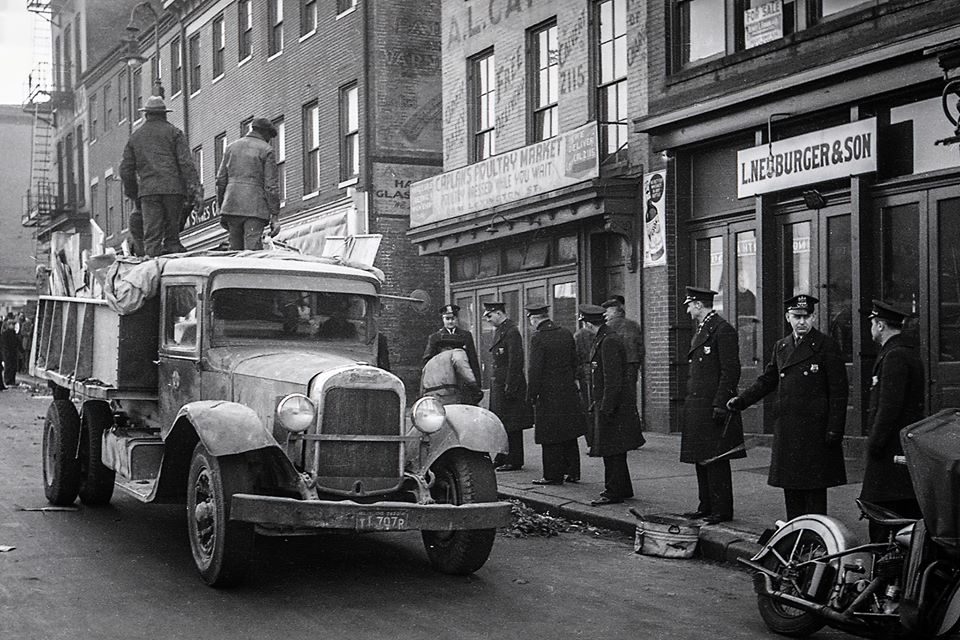 Courtesy Eli Alaman
Courtesy Eli Alaman
22 February 1941: Strike, Baltimore Police
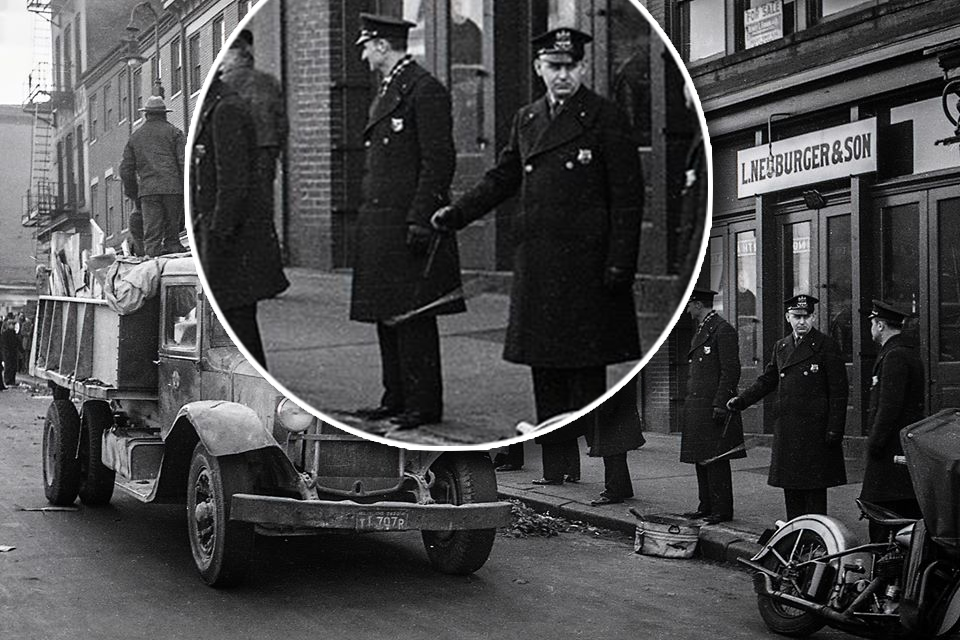 Courtesy Eli Alaman
Courtesy Eli Alaman
22 February 1941: Strike, Baltimore Police
Take a look at the officer in the bubble from a 1941 photograph where he is spinning his espantoon on the end of the thong or strap. It is a very nice picture, and given the year of the picture, it is nice to see it being done so long ago. Also, 1941 would have been long before a swivel was added to the strap or thong. This picture was taken by Eli Alaman
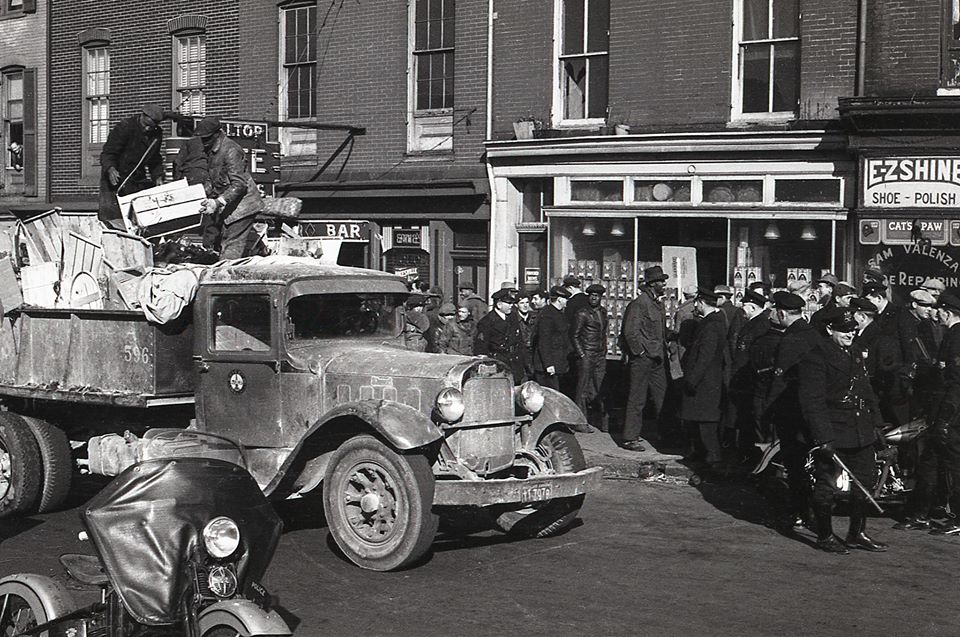
Courtesy Eli Alaman
22 February 1941: Strike, Baltimore Police
Taking a look at the motor's officer walking toward the right side of the picture, he is holding the stick at the bottom of the shaft, with the barrel head out front and away from his hand. Looking close, you can see that he is one of the guys that carved the barrel head so it was no longer convex. A lot of guys would reshape their espantoon to make it unique to them.
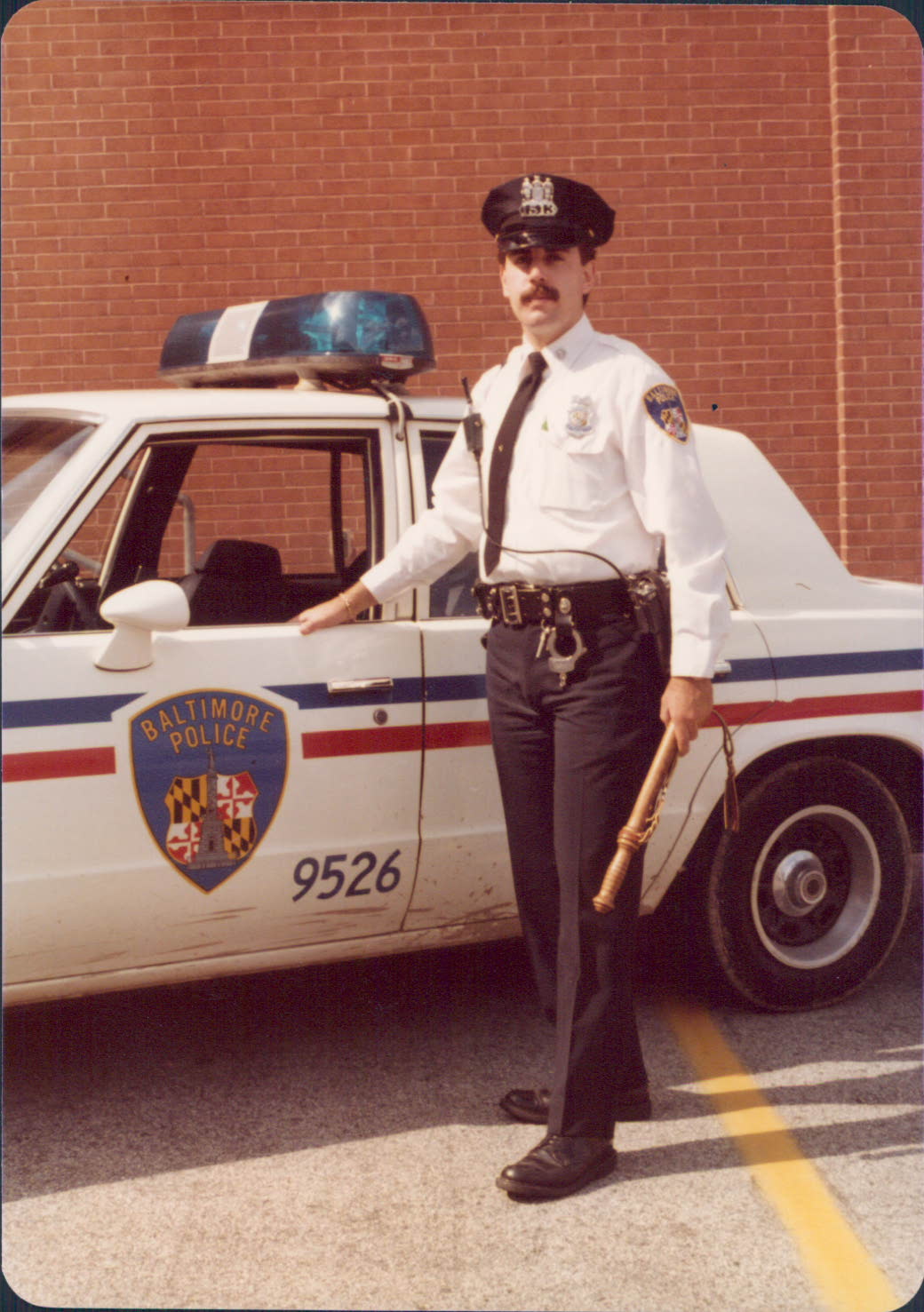
Courtesy Robert Oros
Nice espantoon picture showing a nice Baltimore Police-issued espantoon.
Looking more closely, we can also see he had a swivel added to the thong.
![]()
Just as the Espantoon wasn't only used for self-defense,
The Rattle wasn't only used for communication
Both The Espantoon and Rattle were used as Impact Weapons
and/or for communicating with other officers in the area.
For more, Click HERE or on the picture above
![]()
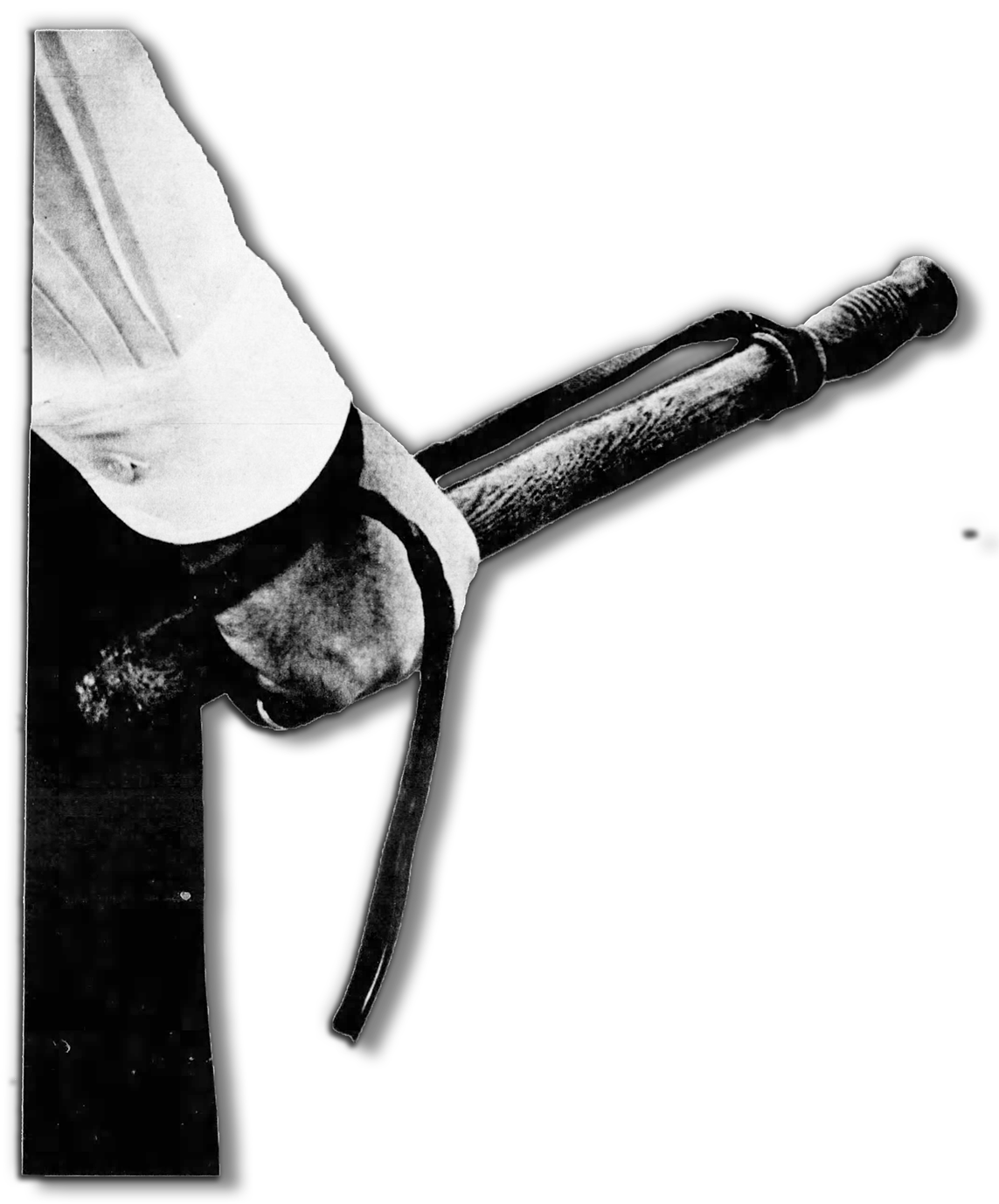
This is the most commonly used "striking position." It is also a catch or release position for holding the stick when spinning or twisting the espantoon. Notice in this picture that the officer is carrying his espantoon with the barrel head out. This practice has been the way Baltimore police have carried their sticks, going back to the late 1700's and early 1800s. It is what makes a nightstick an espantoon. The espantoon, also known as a nightstick, is a traditional symbol of authority for Baltimore police officers. Its unique design, with the barrel (or burl) head carried outward, is for self-defense and crowd control. Its uniqueness is believed to have originated here in the late 18th century and has been consistently followed ever since. With the barrel head facing outward, it allows for quick and effective strikes, or jabs, while maintaining a non-threatening appearance. This longstanding practice showcases the rich history and traditions of the Baltimore police force. The distinctive carrying style has become an iconic feature of Baltimore's law enforcement history and also serves as a visual representation of their role in maintaining law and order while reflecting the city's deep-rooted connection to its policing heritage.![]()
1861 Baltimore Police dressed in plain clothes and were distinguished by
a pink ribbon on their left lapel, and an espantoon in their hands
CLICK HERE OR ON PIC ABOVE FOR FULL SIZE ARTICLE
This clipping was taken from a 28 June 1861, Sun paper. Notice it says
"A new police force was appointed in several districts under military authority."
"Newly appointed policemen were designated by a Pink Ribbon, and
they carried the usual Police Club," which in Baltimore is the Espantoon
TO SEE FULL PAGE CLICK HERE OR ON THE ABOVE ARTICLE
![]()
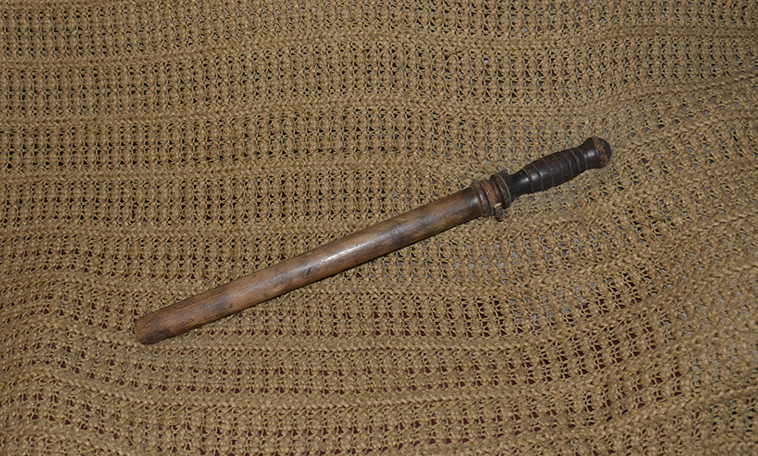
Reverend McKenney and Reverend Longenecker
This is one of the old Baltimore Police Department-issued Espantoons made between 1937 and 1977 by either Rev. W. Gibbs McKenney or Rev. John D. Longenecker. An interesting meeting occurred after years of the elder reverend [McKenney] turning police sticks for Howard Uniform to be distributed to the men and women of the Baltimore Police Department. The reverend [McKenney] was set to retire, and as such, he listed his tools for sale in a local newspaper. By the time the second reverend [Longenecker] saw the listing, the tools—a wood lathe and some other woodworking tools—were gone. Reverend McKenney had decided to, and by then he had already given his tools to a local boy’s school. However, he told the second reverend, who, after a brief handshake, he knew was a woodworker, that if he was interested and could gather the necessary tools himself, he would help him get the contract to turn Espantoons for Howard Uniform Espantoon. Not long after that meeting, the two reverends were together, with the senior reverend teaching the junior some of his tricks for turning the Baltimore Espantoon. There may be something to the number of grooves turned into the barrel head of the Baltimore espantoon, but we’ll cover that in another section. The younger reverend had been turning chair parts on a lathe since he was a small boy working at his family's furniture-making business in PA (it was his job to turn the rails for the chairs his father and older brothers were making). So, he picked up on Reverend McKenney’s pattern real fast, and best of all, he had a photographic memory, so he was able to turn them without a template. Well, I am told by a family member that he didn't use a template or pattern, but he did have one stick, the stick he got from Reverend McKenney hanging on a wall not far from his lathe, and all of the Longenecker Espantoons were identical and pretty close to the same as the McKenney Espantoon. If I remember correctly, the second Reverend said it took him 1 hour to do a stick at first, but by the time he was ready to start production, he was able to turn them at a much faster rate of 3 to 4 of them in that same hour.
![]()
Click HERE or the above Article 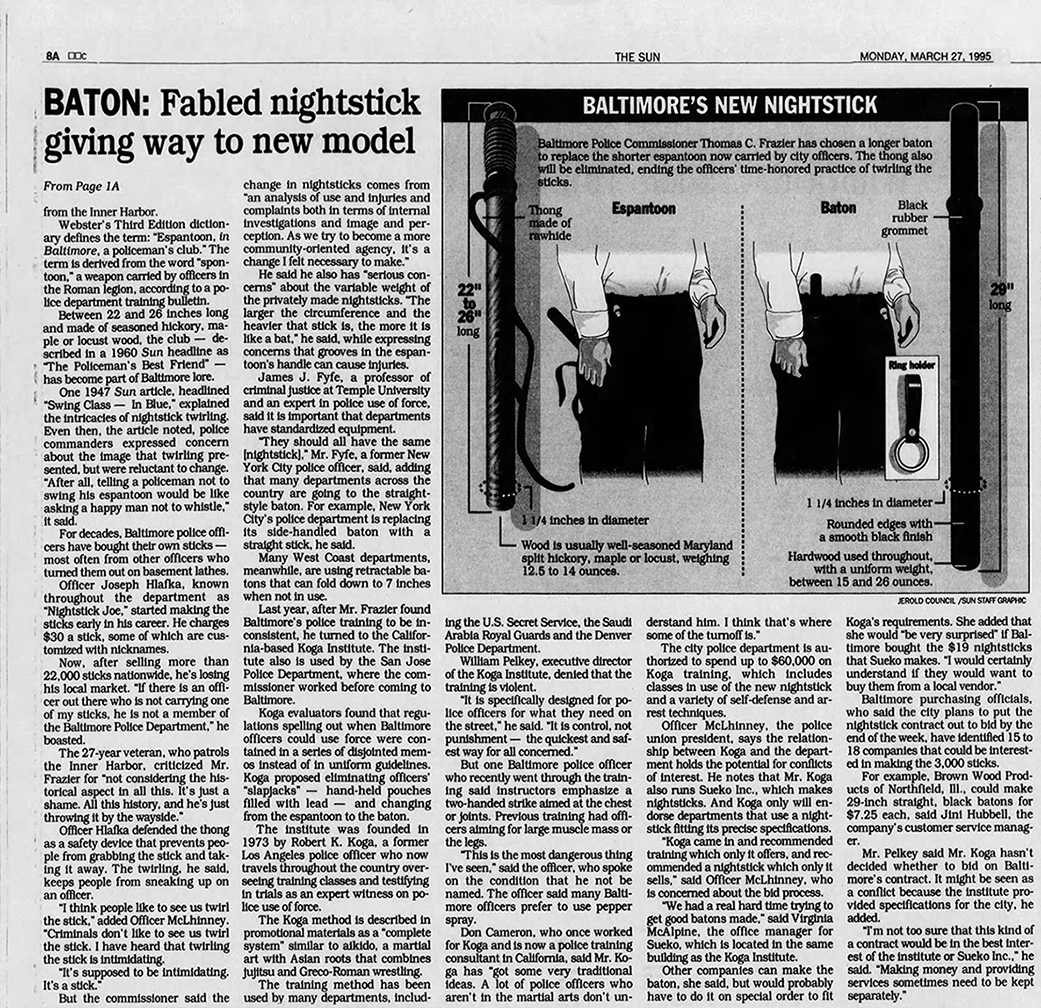
Click HERE or the above Article
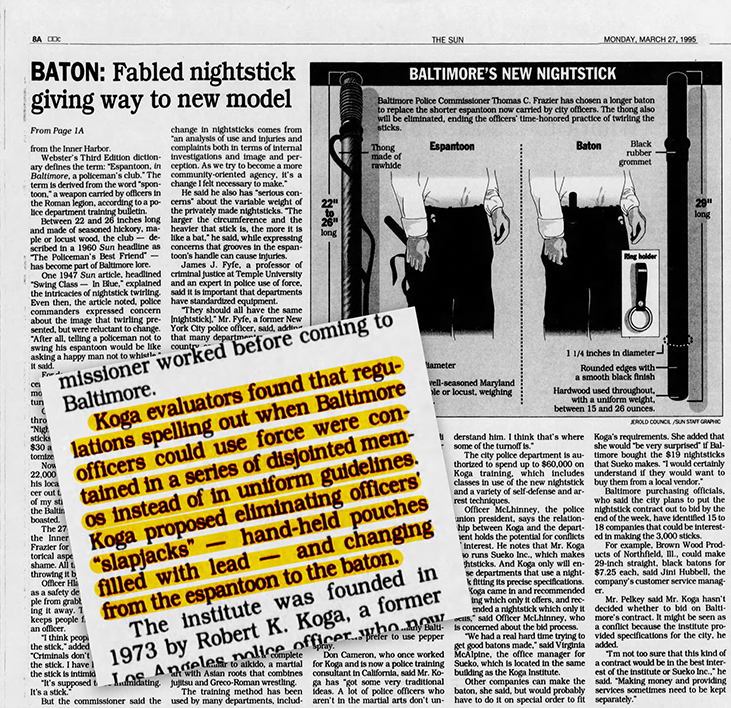
Here is who suggested doing away with the slapjack, but it was on
16 November 1994, that the department ended the authorized use of the Slapjack
Click HERE or on the picture above for a full newsletter.
Baltimore Police Newsletter
January 1995
![]()

We have and will continue to see this picture on the site; look where the stick is most often held, and we'll see why the handprints are where they are and how this is a Baltimore thing. Obviously, this doesn't just go for this stick; go get your stick, or the next time you pick up a stick at a flea market or antique store, pick it up and look for these telltale signs of where the officer's hands most often carried it. After all, no other agency not only had their officers turn a nightstick around and use the handle as the business end, but if we read our general orders, we see several lines describing the various batons allowed in use by the department. When they describe the espantoon, it is described as follows: espantoon—a wooden baton between 22-25 inches in length, with the striking end of the baton being between 1 1/2 - 1 3/4 inches in diameter and the grip end being 1-3/8 inches in diameter. This baton has color restrictions and shall only be coated in an oak, ash, maple, hickory, or rosewood finish. Decorations are prohibited.
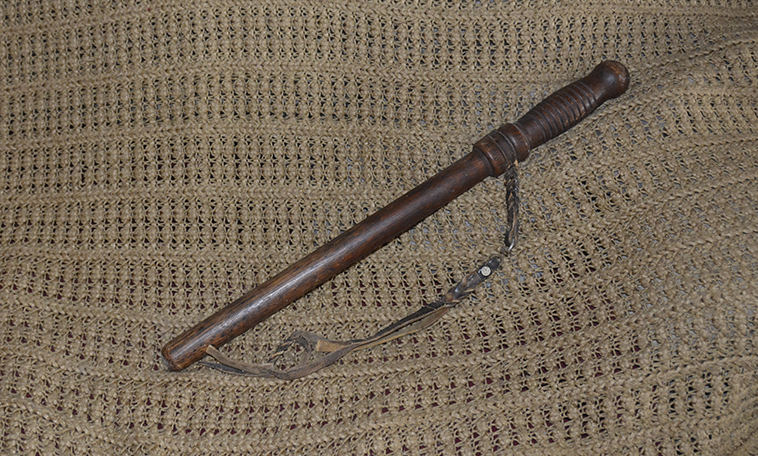
If we look close we can see where the hand most often held this stick
It is cleaner at the end of the shaft furthest away from the barrel head
NOTE: We are not saying we won't find marks where officers from other agencies didn't carry their batons at the shaft; what we are saying is that in most cases where the stick is not a straight stick and does have a handle, the handle will not be as clean as the end opposite our Espantoon's barrel-head.
To better understand what makes an Espantoon an Espantoon, we have to take into consideration what is the different between, a nightstick carried in New York, Chicago, Philadelphia, or by any other police officer in any other police department anywhere in this country. Basically, other than Chicago that had a unique turning pattern to their baton’s handle, that could help identify it as a Chicago stick. Baltimore may not have a pattern for optional officer self purchased sticks, the issued sticks were the same design from 1937 to 1992. Before 1937, the sticks were not much different, the craftsmanship was slightly better looking. Put either the older versions or the more modern version on a table with other batons from around the world, and a Baltimore baton could easily be picked from the crowd of sticks.
![]()
Below are Some Baltimore Police Issued Espantoons
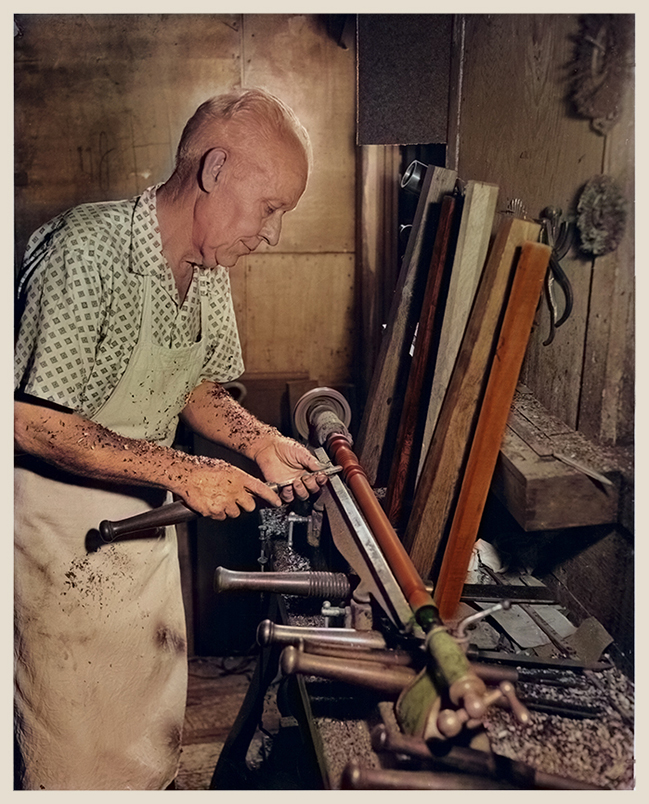
Carl Hagen
Turned espantoons from 1955 to 1979![]()

1920's Baltimore Police Issue

Issued Stick 1937 - 1977
Rev. W. Gibbs McKenney & Rev. John D. Longenecker
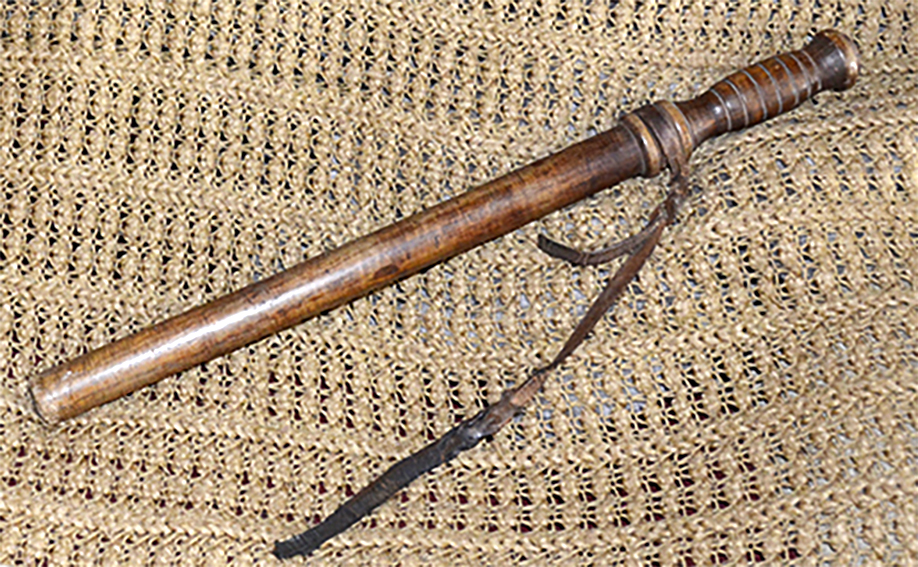
Issued Stick 1937 - 1977
Rev. W. Gibbs McKenney & Rev. John D. Longenecker

Issued Stick 1937 - 1977
Rev. W. Gibbs McKenney & Rev. John D. Longenecker
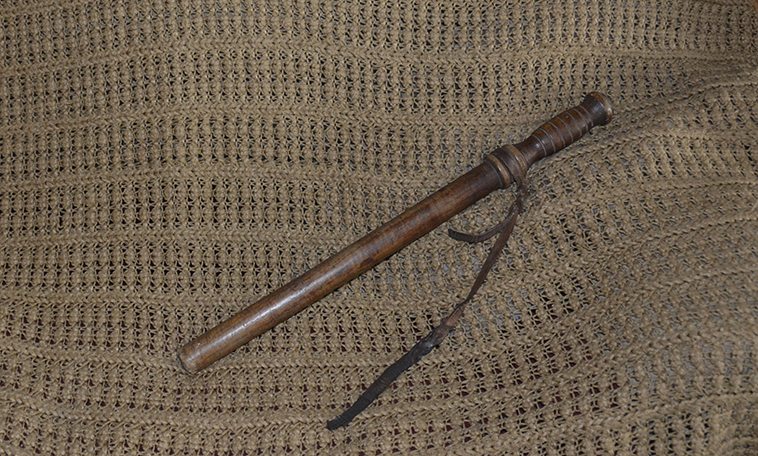
Issued Stick 1937 - 1977
Rev. W. Gibbs McKenney & Rev. John D. Longenecker
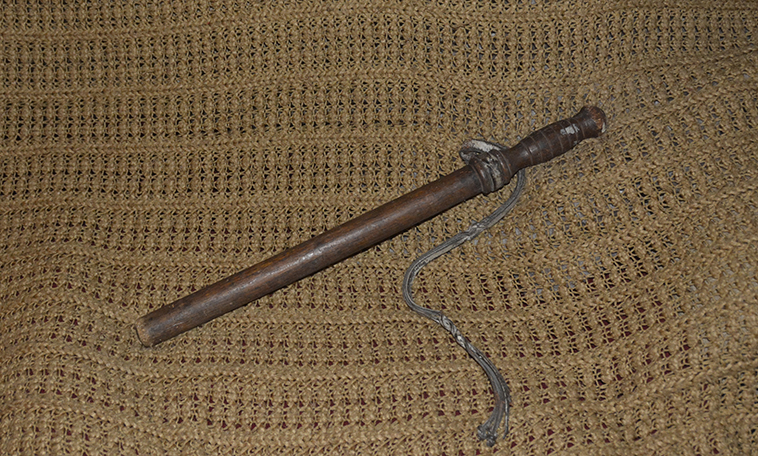
Issued Stick 1937 - 1977
Rev. W. Gibbs McKenney & Rev. John D. Longenecker ![]()
Click HERE to see full size article ![]()

Courtesy David Eastman
Look at the officer's espantoon seen on the right side of this pic, and notice how it is carried, held in his right hand with the thong ran through his fingers, and the barrel head out as he is gripping it by the shaft of the espantoon. This pic is taken in the early 1900's but we can clearly see he carries it the way it is carried today, indicating the striking end back then, was as it was in the 1960's and 1970's when Ken's uncles walked a beat in Baltimore, and the 1980/90's when Ken walked a beat in Baltimore. The striking end in Baltimore would be considered the handle to all other jurisdictions, and if other departments used it the way Baltimore did, it was only Baltimore that had it in the officer's general orders that the striking end was the wider end of the baton, the handle in Baltimore is the thinner end, the end known here as the "Shaft."![]()

Issued Stick 1937 - 1977
Rev. W. Gibbs McKenney & Rev. John D. Longenecker - This has one edge shaved flat so it would stay in place without popping out every time we turn a sharp corner or hit a pothole. The flat spot helps keep it in place when it's forced between the dashboard padding and the transmission hump.

Issued Stick 1937 - 1977
Rev. W. Gibbs McKenney & Rev. John D. Longenecker - There was a time in the mid 50's that officers would shave the Barrel Head of their Espantoon taking it from convex to flat/straight then add or re-cut grooves in the new Barrelhead
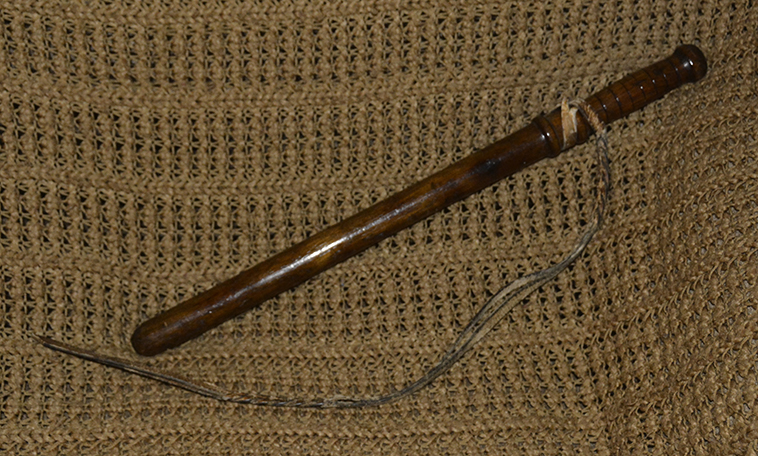
Issued Stick 1937 - 1977
Rev. W. Gibbs McKenney & Rev. John D. Longenecker
This is another case of someone attempting to straighten the convex, "Barrel-Head"

Issued Stick 1987
This was issued to me on 17 June 1987 when I was hired and sworn in

Issued Stick 1937 - 1977
Rev. W. Gibbs McKenney & Rev. John D. Longenecker

Issued Stick 1937 - 1977
Rev. W. Gibbs McKenney & Rev. John D. Longenecker
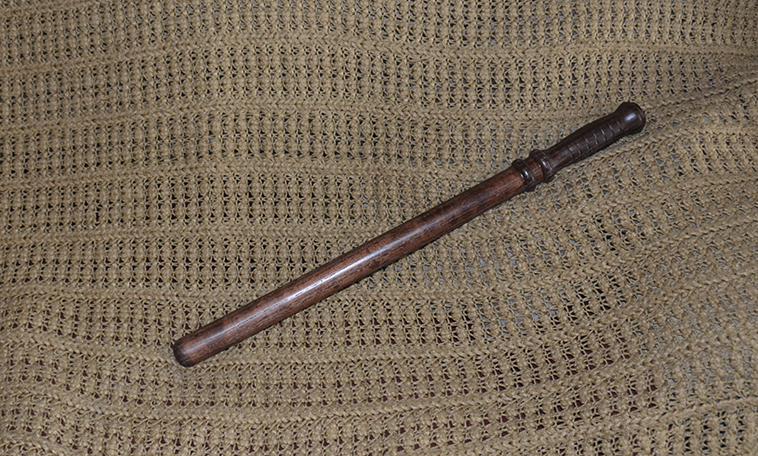
Jim Brock - Perfection Collection
Rev. W. Gibbs McKenney & Rev. John D. Longenecker Model - Circa 2015
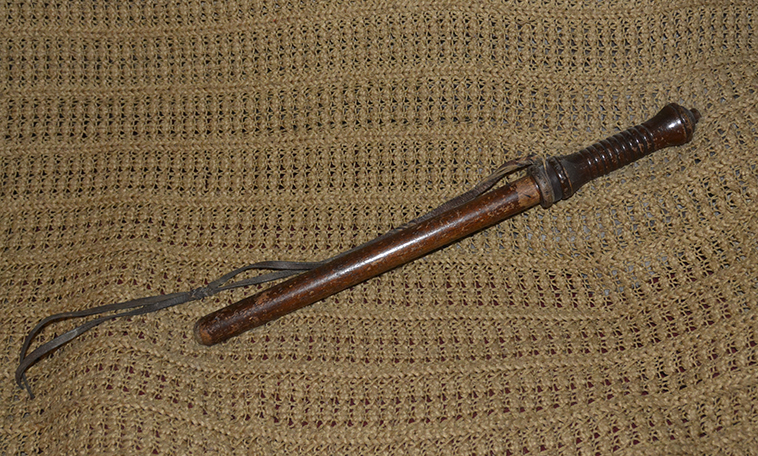 Non-Issue Stick 1937 - 1977
Non-Issue Stick 1937 - 1977
Rev. W. Gibbs McKenney & Rev. John D. Longenecker
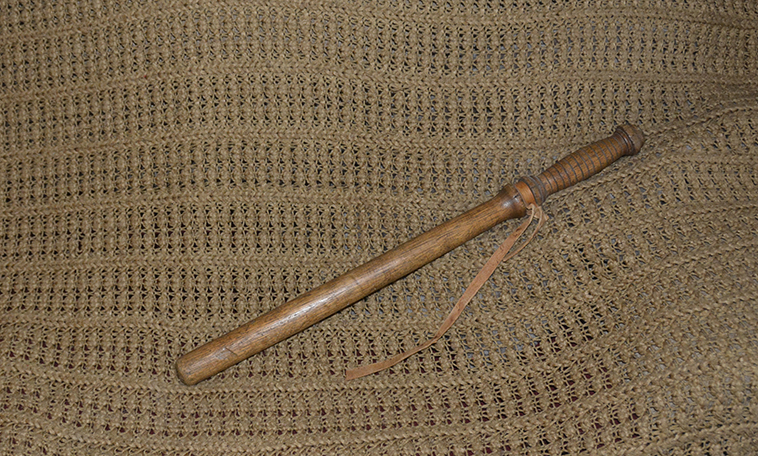
Carl Hagen turned sold through Howard Uniform circa 1965
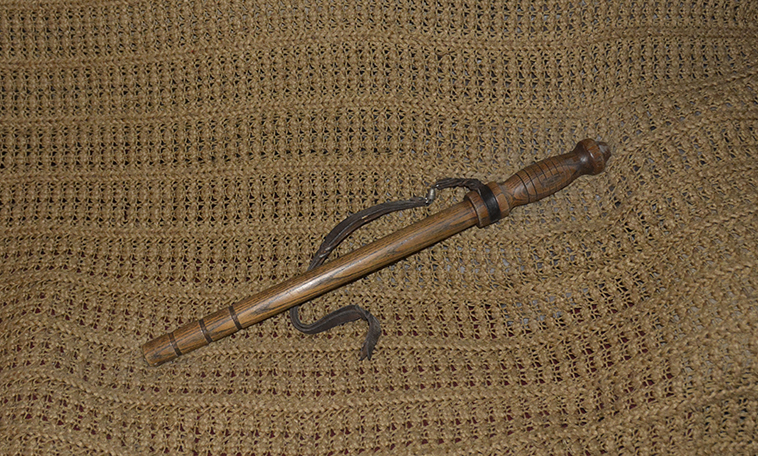
Carl Hagen
This is an early Carl Hagen Stick, it came while he was still turning them to the size of an issue stick, and isn't too far off of the standard issue stick, he just added a few things to make it stand out from the issue stick, the barrel-head is a little over sized and it is turned from an oak.
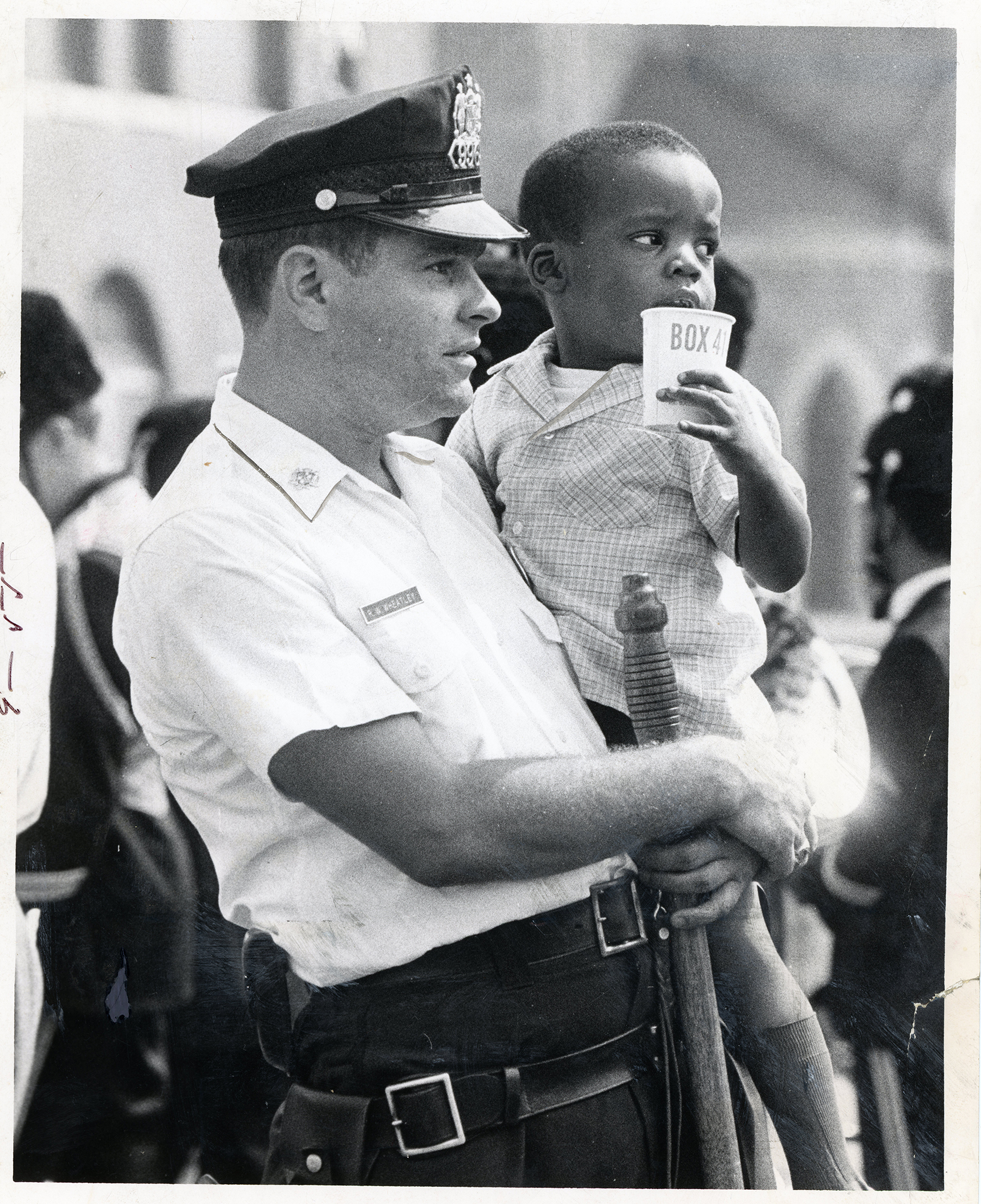
P/O Raymond Wheatley holding a Carl Hagen stick, notice how Carl rounded the tops of his sticks, this is a nice old stick. Also, notice how Officer Wheatley picked up a small child to help him better see a parade that he had attended, but couldn't enjoy over the crowd. Officer Wheatley not only gave the kid a lift, bought him a cup of soda too.

Carl Hagen 1955 - 1979
This is one of Carl's first unique designs, it was done solely by him and became a popular design from his sticks. In the next pic, we'll see Officer Ray Wheatley holding a Carl Hagen Espantoon, it is more of an issue cut, but with a modern (at the time) cut, the cut that ended up being refined into the sticks we saw turned by Ed Bremer and Joe Hlafka.
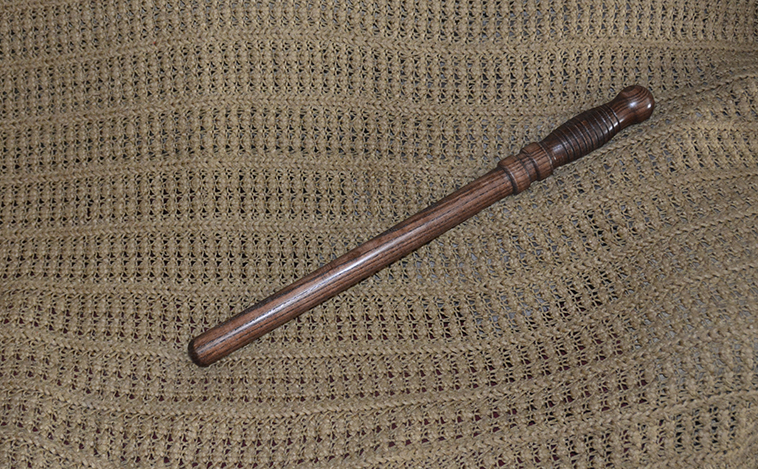
Jim Brock - Perfection Collection - Carl Hagen Model - Circa 2015
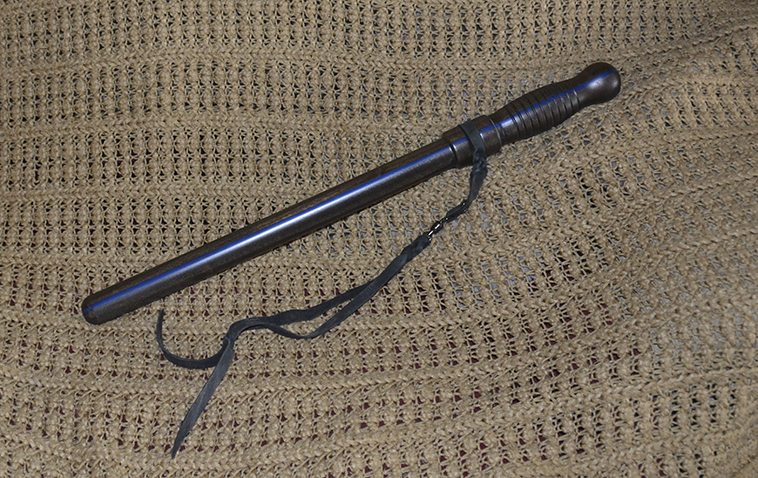
Jim Brock - Perfection Collection Thin Blue Line Stick - Carl Hagen Model - Circa 2015
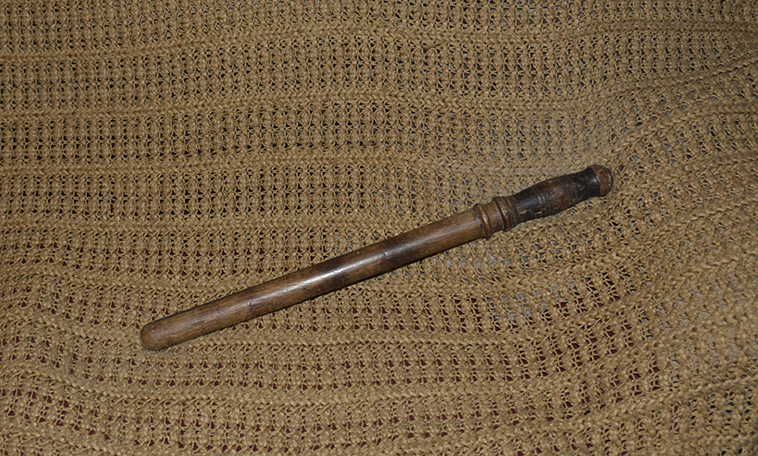
Prior to Issued Sticks 1954 - 1960
Rev. W. Gibbs McKenney & Carl Hagen - At some point when McKenney had retired from turning sticks, he had donated his lathe and tools to a boy's school out west, and before meeting Reverend Longenecker, McKenney he had met Carl Hagen and showed him how to turn sticks, for whatever reason, Carl turned some sticks for Howard Uniform, he just didn't get the 500+ stick a year contracts from Howard Uniform that the Reverends McKenney & Longenecker received.

Carl Hagen - 1955 - 1979

Jim Brock - Perfection Collection Lignum vitae #001 Stick
Lignum vitae is on top 10 lists of hardest woods depending on the list it is either 2nd or 4th One might be how dense the wood is, while the other might be how dense the guy/gal is that is trying to spelling Lignum Vitae Joe Hlafka Model Circa 2015
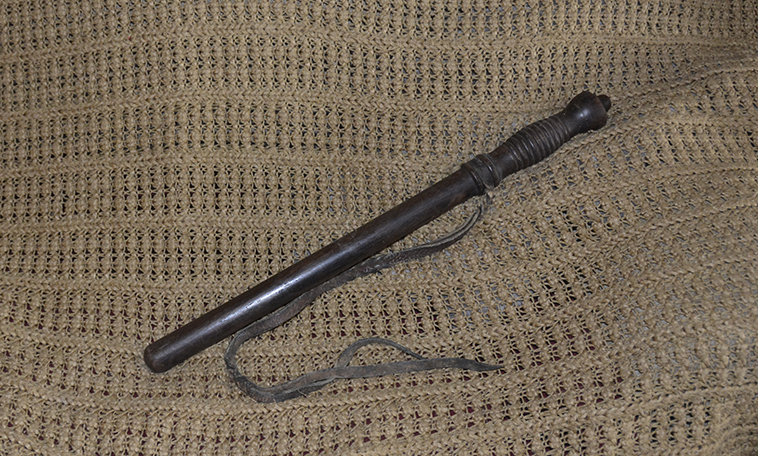
Ed Bremer - 1974 - 1977
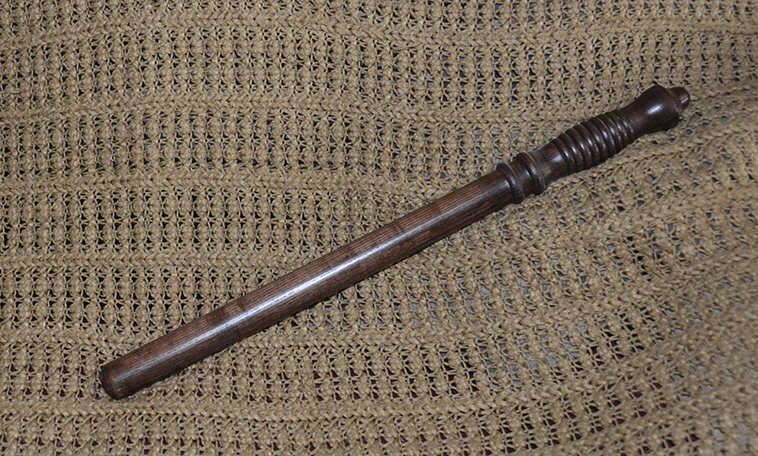
Jim Brock - Edward Bremer Model - Circa 2015
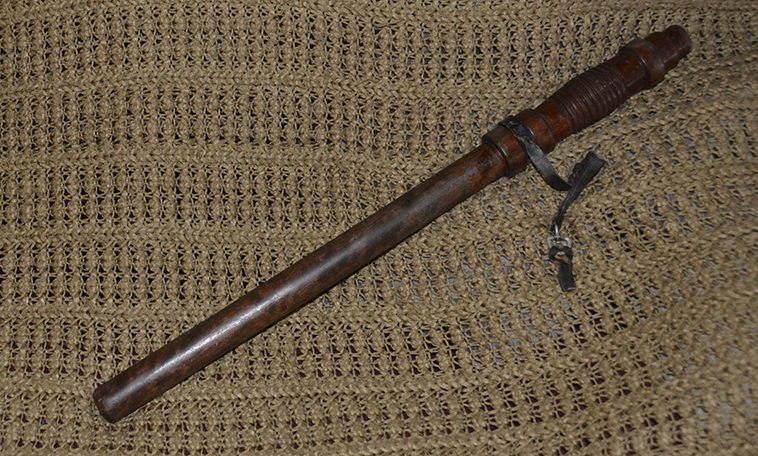
1977 - 2007 - P/O Joe Hlafka

Joe Hlafka
1987 - I bought this from Joe Hlafka direct, apparently someone ordered it, paid half down and before it was done they found their stick and told Joe, they didn't need it anymore, could he sell it to someone for the remainder of the balance, I was the lucky guy that talked to Joe about a stick, and he gave me the stick for $12.00. I have replaced the thong twice, had it, "I say" stolen once, the guy that took it, called it, "found". How you can find an espantoon in the trunk of a patrol car, and not think it must belong to someone. Not to mention DRISCOLL is written around the stick in blue sharpie by the Ring Stop - Anyway, it is a 30 plus-year-old stick. BTW I stopped the kid as he was going out to his post, so I loan it to him for the shift, and told him to get it back to me, "in my hand," the next day. I couldn't send him on the streets without a stick.
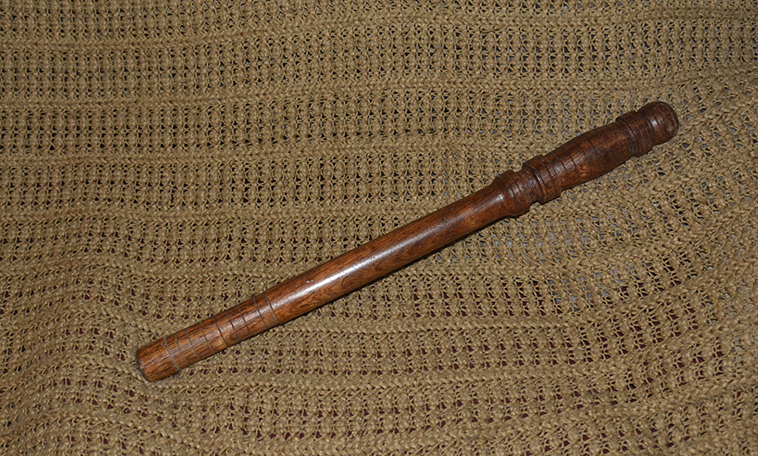
I Turned this Myself
1990 - I put the extra groove on the shaft because after carrying it for a day or two I realized the stick felt good, weight was nice, but the shaft was too think to hold on while swinging it, So I taped the thong to the barrel-head with Duct tape, and put the stick back on the lathe and shaved a hand-grip in the shaft. After shaving the shaft to a comfortable grip, I was done, pulled the tape, and it was a spinner, or umm, I mean a winner, 
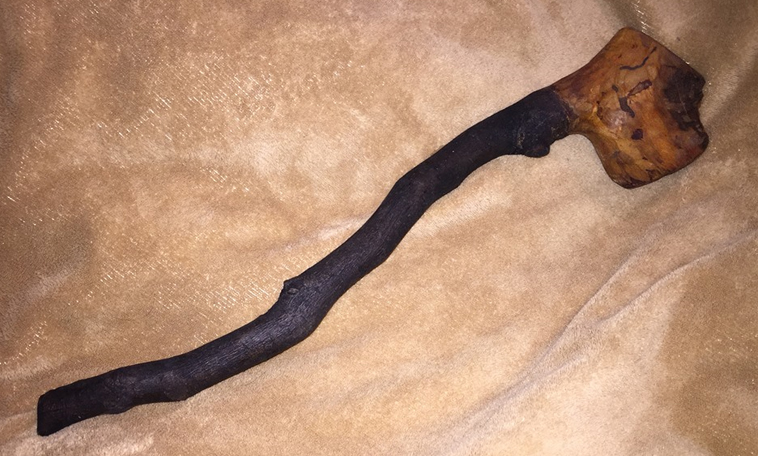
Irish Shillelagh
This is to point out the striking part of this weapon, that blunt looking rock, or fist shaped portion at the end of this weapon, and any blunt force weapon is called the "Burl-Head". On the Espantoon the blunt striking end resembles, and is often mistaken for the weapon's handle is called the "Barrel-Head." Most likely stemming from a misunderstanding caused by Baltimore's southern drawl, or bad "accent," causing a listener to misunderstand what a speaker may have said, Burl-head to thinking the speaker said, "Barrel-head." In 1987 when an old timer told me, he even pointed to the shape and, said, this is because this looks like an old wine barrel. Truth be told, it wasn't a barrel at all, it's a burl.

Barrel Head
This is the Barrel-head of one of Carl Hagen's early sticks - This Rounded off top end was exclusive to Carl Hagen, and was found more on the West side of Baltimore than the East. The East-side Espantoons saw more of a two or three tiered layers each with a hard edge that sat atop the espantoon like a crown on top the barrel head end of the stick. If we look at Carl's earlier stuff, he had a two or three-tiered top edge also, but it wasn't a hard edge. Carl had a super soft, smooth transition going tier to tier on the barrel head.
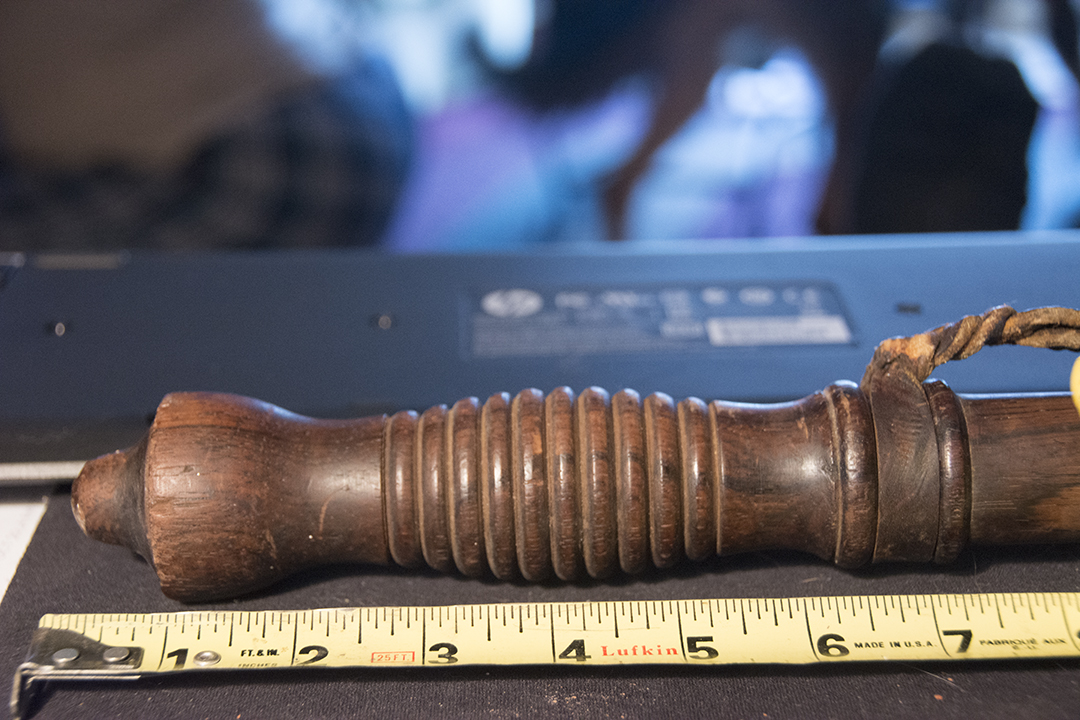
Barrel Head
This is the Barrel-head from one of Ed Bremer's early sticks, he put what he called a "Nib" on the top of all his Barrel head. Mr. Bremer felt he saved lives, both of Officers and Suspects because as he once said, "Nightsticks Save Lives, Preventing Officers from a need to escalate from hand-to-hand combat to the use of a firearm." The faster we can get a suspect into cuffs the safer it is for both the officer and the suspect. This stick is turned from Lignum vitae, a wood that was banned by the department as it was too heavy, hard and they felt could cause serious injury or death.
The “Barrel Head” of Baltimore's Issued Espantoon
Interesting Theory, in 2008 while researching Baltimore’s Espantoon, we were looking for the normal questions, like, why we called it an, Espantoon? Where did the word, Espantoon, come from? When did it start etc.? Etc. etc. etc…. Along the way other observations were made, like when we see a Chicago Nightstick, we know it is from Chicago on sight. The shape of the handle is cut in such a way that often even in the shadows of a picture, you can make out their handle cut, it is that unique.

This is a Chicago Stick
Notice the rings are on the top and bottom of the handle but skip the center
This pattern carries back as far as we can find in their nightsticks
Baltimore didn’t have such a design, if we go back far enough, we’ll see at one time we had as many as twenty, “ring grooves” on the barrel head, then later sometime during the time period that Reverend W. Gibbs McKenney was turning our sticks there was a change, at first it looked like he may had just made a simpler design, but it made me and some others that were helping with my research stop and wonder, were the near twenty ring grooves the same as the twenty points on the twenty point badge? Did each ring represent a ward in the city? When the good Reverend came along and made his design, did he reduce it to seven to represent the seven districts that protected the city at that time. We will never know, but it does give us something to think about.
Not long ago while watching re-runs of Ink Masters, I saw an episode in which they were drawing, and then tattooing the Statue of Liberty. One of the artists made what was said to have been a crucial error, he only drew six of the seven rays/spikes on the Statue of Liberty's crown. The other artists made a big deal, such a big deal that it seemed it was less than about detail, and more about symbology. So, I looked it up and found that according to the website of the National Park Service, the seven spikes on the Statue of Liberty's crown represent the seven seas, and the seven continents of the world.

This is one of Reverend McKenney's Espantoons Notice
the Barrel Head has Seven grooves. This pattern carries from the late 30's when
Rev McKenney turned them through 1977 while Rev Longenecker turned them
and on until 1996 when they were no longer issued by the department
Could these seven grooves, in the design of our stick by Reverend McKenney have a similar meaning? In 1937, would he have given the seven spikes of the Statue of Liberty's crown any thought at all? I doubt it, so I asked myself again, if it is not due to the seven districts of police that served and protected the city of Baltimore at that time. Then we have to take into consideration Reverend McKenney, and his profession then ask ourselves, “could there be a religious link to the number seven?” To answer this, I looked up religious links to the number seven, where I found; the number seven has had significance in almost every major religion. In the Old Testament, the world was created in six days and God rested on the seventh, creating the basis of the seven-day-week we still use to this day. In the New Testament the number seven symbolizes the unity of the four corners of the earth with the Holy Trinity. The number seven is also featured in the Book of Revelation (seven churches, seven angels, seven seals, seven trumpets, and seven stars). The Koran speaks of seven heavens, and Muslim pilgrims walk around the Kaaba in Mecca (Islam’s most sacred site) seven times. In Hinduism there are seven higher worlds, and seven underworlds, and in Buddhism the newborn Buddha rises and takes seven steps. So, whatever gives us the most comfort, it could just be an easy design that helps the maker kick them out at a rate of four per hour, it could be one groove for each of the seven districts (ED, CD, NWD, ND, NED, SWD, SD) that served the city at the time. We didn’t have a SED until 1958/59 and WD was non-operational for a time being. So, it could have been that. But most likely given that for forty years from 1937 until 1977 our sticks were turned by two Reverends. First from 1937 until 1957 Rev W. Gibbs McKenney, made our BPD Issue Espantoons, then in 1957 when he retired from the business he donated his machines to a local boy’s school, shortly after he met and Rev. John D. Longenecker learning he was a woodworker, he agreed to train him and help get him the contract he was walking away from. From 1957 until 1977 Rev. John D. Longenecker turned our sticks using the design given to him from Rev McKenney. Over the course of 40 years between the two reverends a combined 20,000 hickory, and 4,000 Redwood Espantoons were turned. Their sticks were sold to Baltimore City Police, as well as several other jurisdictions and security companies. More can be read elsewhere on this page about both Rev. W. Gibbs McKenney, and Rev. John D. Longenecker how they met and what they did.
Here we hope to just give us all a little something to think about as to why the design may have become what it did.
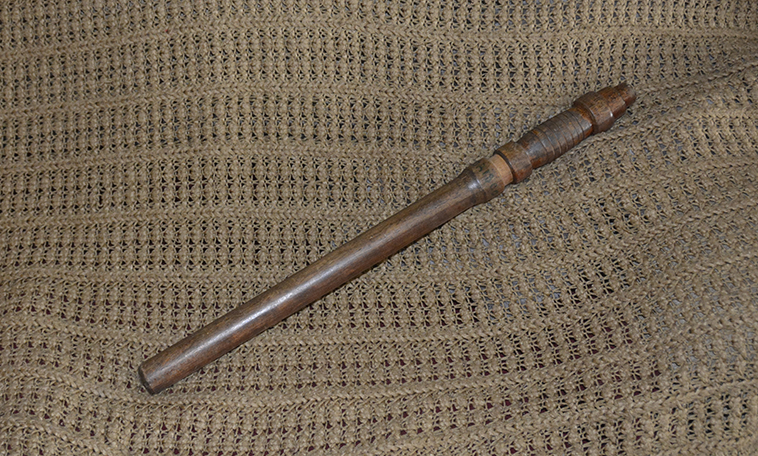
I purchased this stick from Joe personally and carried during my time in Patrol
If we count the grooves we see he also turned seven grooves, which was
kind of an unwritten custom of our department's Espantoons.
As an interesting side note, many of the guys that followed alongside Reverend Longenecker, like Carl Hagen who turned from 1955 to 1979, Edward Bremer turned out Espantoons from 1974 until 1977, and our own, Officer Joseph "Nightstick Joe" Hlafka who from 1977 until 2007 more often than not, turned seven grooves into the barrel heads of their sticks. There is nothing in writing to tell us why they did this, if it was for the reason the Statue of Liberty has seven spikes, because of the religious ties to the number seven, perhaps the reverends felt it would offer a kind of protection, or maybe it was just quicker and easier to turn seven simple grooves. We can pick whatever makes us feel better about the design, because until we can talk to a family member to see what they were told, we may never know. the good thing, I am friends with Joe's wife, and I was first contacted by Reverend Longenecker's stepson. So, we have a contact, and can look for family members of the others we know turned our Espantoons.
 Grip Designs
Grip Designs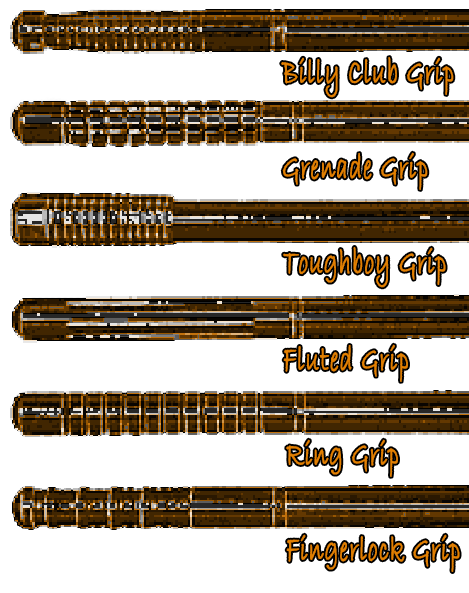

BALTIMORE POLICE DEPARTMENT TRAINING BULLETIN
Guidelines EDWARD T. NORRIS POLICE COMMISSIONER
December 12, 1987
Revised / Reviewed: August 2002 Vol. 12, No. 10
ESPANTOON HISTORY The espantoon according to Webster’s Dictionary is: “in Baltimore; a policeman’s nightstick.” The term is a derivative of the word “Spontoon” that dates back to the weapon and symbol of authority the Officers of the Roman Legions carried.. In 1784 Baltimore appointed paid police officers. From that time until the middle 1960's when the department switched to motorized patrol units the sight of the officer “walking the beat” was a commonplace reassurance. One of the most unique elements of a foot patrol officer in any large East Coast American City was their ability to twirl the “nightstick” until it literally danced. Obviously then, as now, the espantoon is a defensive weapon. The purpose of twirling the espantoon was multifold. The days before the portable two-way radio, the officer was alone and the “twirling” created and protected a “personal zone.” Another benefit of twirling the espantoon was that a familiarity was gained with the “stick” that developed confidence carrying the espantoon. The espantoon was also used for communications. A rapid tapping of the espantoon signaled a warning to others or a call for help. A flip of the espantoon, falling free of the hand striking the concrete, created a unique “ring.” Even today foot patrol officers use this technique to signal each other. It is extremely effective on quiet nights. Even when “tapped” in a large crowd, usually another officer is the only one to notice. Training Guideline Vol. 12, No. 10 Page - 2 - Departmental regulations allow an officer to substitute a personally purchased espantoon for the one issued by the department, provided the substitute is similar in size, composition and design to the issued equipment. The departmental issued espantoon is 22" long by 1 1/4" in diameter and is solid wood. There is a handle on one end with a groove to attach a leather strap or thong. The thong extends from the groove to the bottom of the espantoon.
COME-ALONG AND HANDCUFFING ASSIST TECHNIQUE There are a variety of uses for the espantoon as a come-along or to assist in the handcuffing of an arrestee. Most are too complicated to describe briefly here. A key element to all of these techniques is for the officer to retain control of the espantoon at all times. The espantoon is primarily used as a lever to add power (torque) to the officers hand and arm movement. The speed of the top of the espantoon is essential. Bring the espantoon (with one hand) in a cocked position and strike forward in a slashing move. Make sure the wrist is snapped forward to accelerate the top two inches of the espantoon for maximum power. Do not snap back after impact. Follow through across your body. If a second immediate strike is required, deliver it in a back hand method, again snapping the wrist for maximum power.
JABBING AREAS AND TECHNIQUE To jab an assailant with the espantoon is an alternative method of stopping an assault to gain control. Jabbing is especially effective in close quarter confrontations such as a small hallway or in a large crowd. This would include any situation where “swinging” the espantoon would not be effective and/or would endanger others. The most effective target area for using a jab is the stomach area. A jab with the espantoon when carried in a single hand short reach position, is very effective against a sudden assault. A jab in the single hand long reach position has limited applications, such as keeping a subject or assailant at bay. The most effective jabbing technique is utilizing both hands. One hand close to the top of the espantoon while having the other hand at the bottom; gun away from the assailant. The technique is identical to using a bayonet on a rifle. Step forward to the assailant thrusting the end of the espantoon in the stomach area while lifting upwards. Both maneuvers are done with power. Training Guideline Vol. 12, No. 7 Page - 3 - Historically, most officers have made or purchased their own espantoons. While all are required to be made entirely of wood and similar to the size of the issued model, each one is unique. The variations of wood tones, size and shapes make them very personal. Often the same espantoon is carried for an entire career regardless of rank attained or duty assignments. The espantoon has sometimes become a family heirloom and passed on to younger generations of officers. The term “nightstick” was derived from the fact that officers were required to carry the espantoon during the “night-time” hours i.e.:4 x 12 and 12 x 8 shifts. It was optional during daylight hours. Police Officers are encouraged to have their espantoons with them whenever on duty. In the escalation of force, the use of espantoon is a step below the service revolver. The espantoon gives the officer the option and a greater degree of safety in the use of force. If the assailant is overpowering the officer’s attempt to defend himself, the espantoon can be utilized effectively to gain control. If the espantoon is left in the car or has otherwise been disregarded, the options for self-defense are severely limited..
DEFENSIVE USE The proper method for carrying the espantoon is in a “short reach” position in the weak (non gun) hand with the index or middle finger through the leather thong. When interviewing one or more potentially hostile suspects, the espantoon may be placed under one arm. This enables the officer to utilize both hands to write information.
STRIKING AREAS AND TECHNIQUES Often the question is asked, “Do I strike with my strong hand?” Most officers will use their strong hand because it is a natural tendency in high stress situations, but your weak hand is also acceptable. If you spin or twirl your espantoon, use the hand that will be utilized for striking. The twirling of the espantoon will enable you to learn its exact length. This knowledge will increase familiarity and confidence as an extension of your arm. Care and consideration should be given when and where you should “twirl the stick.” The espantoon should not be spun in close areas to avoid the possibility of injury to others or property damage. In some situations the espantoon may appear better left in the ring. If the espantoon is too heavy or feels uncomfortable, the officer should obtain a lighter espantoon. The power of the espantoon is developed by the speed not the mass. An espantoon that is too heavy for the officer will be ineffective. Whenever an officer is forced to strike a person, he must only hit as hard as necessary to stop an assailant in an effort to gain control to effect an arrest.
Training Guideline Vol. 12, No. 7 Page - 4 - The best target areas are the legs. The point of impact should be on the outside rear quadrant of the upper leg about four inches above the knee. That is where the common peroneal nerve branches off from the sciatic nerve. Striking this area will cause an involuntary bending reflex action of the leg. In a sympathetic nerve reaction the other leg will also “buckle” causing the assailant to fall to the ground. On top of the calf has the same stunning effect. Do not strike for the knee joint which can cause permanent damage to bones, tendons and muscles. While the legs are the best target areas, an officer is not limited to the legs. Any strike to the head must be avoided. Courts have held that a strike to the head with an impact weapon is tantamount to using deadly force. To strike with the espantoon an officer should hold same in the “long reach” position. The hand should be at the base with the index finger through the leather thong. The striking point should be the top two inches of the upper section. These methods leave the hands free and gives immediate access to the espantoon. These techniques are not offensive but helps the officer to control a situation better and with more confidence. If the officer is in a situation where the escalation of force seems imminent; drawing the espantoon from the ring tends to be offensive and aggravates the situation. When attempting to control a person or a situation, neither “slapping” the free end of the “stick” into an open hand nor pointing the espantoon in a threatening manner is advisable. These actions provoke people and place the officer in greater peril.

![]()
The Perfection Collection
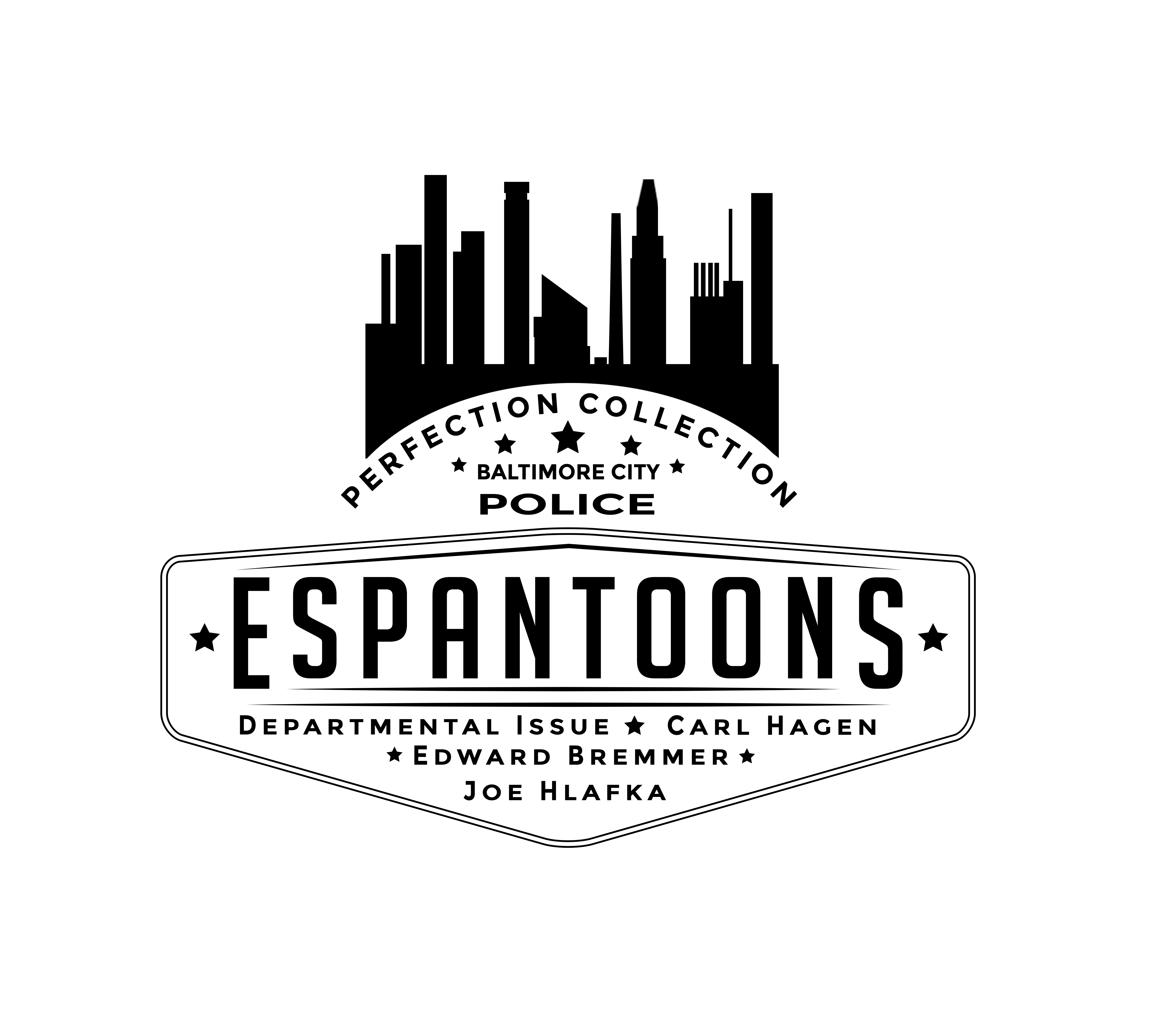
The Perfection Collection was a well-turned set of sticks turned to replicate
four of Baltimore's best-known nightstick espantoon turners
Department Issued turned by one of two Reverends
Then Three well known highly collectable stick makers
Carl Hagen, Ed Bremmer and, Joe Hlafka
Top Down - Department Issued Turned by Rev McKenney or Rev. Longenecker
Carl Hagen, Edward Bremmer, and Joseph "Nightstick Joe" Hlafka
Webster’s Third Edition: “An Espantoon In Baltimore, a policeman’s stick”
We should Start out by saying we collect Nightsticks, Espantoons, Batons Etc.
If you have one for sale, or donation let us know.
We particularly like Baltimore Sticks, but collect them all. We hope to start a Baltimore Police Museum and would like to have as many we can to show what police have used for years to protect themselves and the public. It will be a rolling museum at first, and they will be used to show the differences over the years, as well to show how they wear, do to their having been carried everywhere with an officer over his or her carreer.
In Other Cities It’s Just A Policeman’s Club
by Reynold Stantley
Once upon a midnight hot
While I pondered “on the spot”
Over books with knowledge crammed
Feeling like a person damned
While I peered all board in June
seeking the meaning of Espantoon
Came a Raven black and geaven
In his eyes dull gloom and engraven
Then he opened wide his beak
Gave a most unearthly squeak
Quotas the Raven “take a hop;
“Espantoon? Go ask a cop”
The story of a lost investigator
You see it all happen this way: the man who sits in the editorial sanctum and likes speed and brevity along with accuracy and honesty handed me a newspaper clipping. – He told me to read it. I did. It related the sad land tale of a British Marine from the H. M. S. Exeter who had an altercation with two policemen at Eutaw and Franklin Streets. He lost, of course!
One thing struck me right between the eyes. It was the report of one of the policemen, a sergeant, that stated; “I struck him across his face with my Espantoon.”
So That’s What it’s All About!
Straightaway I asked the host – “What’s an Espantoon?”
He replied;
“That’s what I want you to dig up. It’s a policeman’s club, and the term is particular to Baltimore. What I want you to do is to find out the derivation of Espantoon, and while you’re at it you might trace the Swagger Stick. It was carried by the British sailor, you know.” (Turns out the sailor struck the Officer and Sergeant with that Swagger Stick)
I saluted, did an about-face and left his office gaily. Believing I had a cinch job.
All I have to say now is that if you ever want to play a cruel joke on some family or friendly enemy, get them to look up Espantoon. If he is of a sensitive nature he will probably become a raving maniac.
O.K. next we’re off to the Pratt Library, The Funk & Wagnall dictionaries. It states that the word is one peculiar to Baltimore, and that it means “a policeman’s Billy.” Also, that it comes from the Spanish, espanto, meaning “to threaten.”
Very well, why did the Baltimore police ever adopt the word Espantoon for what is known elsewhere as a policeman’s club, or nightstick?
Little Sir Echo answered; “Why?”
Gets Nowhere with Quest
None of the efficient research workers at the library could find out. Then I went outside and ask a policeman. He looked at me sympathetically and asked; “are you feeling all right buddy? We’ve had some hot weather, you know, and our hospitals are fine.”
That didn’t get me anywhere, so I sought out the help of one, Prof. Jacob H. HoHander of Johns Hopkins University, who not only knows Baltimore. But knows the word (Espantoon) backward and forward. Said he;
“I once wrote an editorial partly dealing with that subject. Of course, the word is of Spanish origin – but how did it ever reach Baltimore and become an expression in our police department is a complete mystery.”
Now for the Oxford English dictionary. Oh what have we here? Espantoon? No, but there’s Espontoon, with an “O” which is defined as a half pike – not a half pint, mind you – But a Half Pike as carried by infantry officers. Then the quotation from Southey;
“Capt. Lewis slipped and recovered himself by means of his Espontoon.”
Search goes on and on again
Well, all that in a question of spelling and derivation. It’s spelled Espantoon by the Baltimore Police Department, and that’s that.
Said George J Brennan, secretary to police Commissioner Stanton;
“It is true that the expression nightstick as applied to those implements carried by policeman is somewhat generally used elsewhere. To my knowledge Espantoon has been used by the Baltimore Police Department for the last 30 years. I have no idea as to its origin.”
(Robert F. Stanton, 1938-1943 – meaning his 30 years puts us at 1908-1913 – We have news articles going back to 1837 using the word Espantoon to describe a Baltimore officer’s Nightstick – So that is more than 100 years before Stanton’s time)
So there you are. The expression might have come to Baltimore with the early settlers as “Espontoon“ and then the spelling changed to “Espantoon.” (Imagine that, what would the grammar police have to say about that?)
On the other hand, the theory that some Spaniard brought it here holds good (possible), because the origin of the Spanish word – ESPANTO, to threaten – certainly applies to those Espantoon you see carried by our worldly Baltimore policemen.
Swagger stick helped him strut
Now for the British Marine and his swagger stick. He used it on the head of one of the policeman trying to help him. Is it an effective weapon?
No! It’s just something for “putting on the dog” when off-duty in the British Army. According to the Oxford English dictionary, you may call it either a swagger cane or swagger stick, and it is the short cane or stick carried by British soldiers when walking out, or going out on the town.
Originally it was a riding crop, but when the infantry took it up, it became a swagger stick. Its weight is slight, and it does not make an effective weapon.
Anyhow, the moral to it all is this, if you’re looking for trouble early in the morning, don’t try to use a swagger stick against an Espantoon. Not only is it bad etiquette, but it would be s bad for you all round. Espantoon! What a great word to stick in your brain and tumble out when you least expect it, like the song of the three little fishes.
Baltimore’s police Espantoon and how is used
Other cities call it a nightstick, but it’s got to be an Espantoon here. Where did the word come from? Experts are stumped. Some say it’s of Spanish origin; others English. Look it up and go crazy. Police are supposed to swing Espantoon only in “case of dire necessity.”
Espantoon History, Two years after the incorporation of the Baltimore Police Department in 1785 they appointed a police Chief and a high constable (then the Chief was known as a “Marshal”) at the time he toured the city caring a “mace”, and it was known as his “Badge of Office”. Oddly enough to this day our Espantoon is known as our “Badge of Authority”. In an 1843 the Sun paper report, a watchman had someone try to take his Espantoon by grabbing it during an arrest. From that report we know what it was called a “Mace” around the time we started carrying them in 1787, and that it was called an Espantoon some 56 years later in 1843. Now let’s look at the two terms… first a “Mace” often when we think of a Mace we think of a stick/club with some sort of axe blades, or a spiked ball on a chain attached to it… the Mace part of the spiked ball and chain or axe bladed weapon is actually the handle, the stick that the spiked ball, or axe blades attach to. Later the Mace is switched to Espantoon, which is exclusive to Baltimore Police, and derived from the “Spontoon”. A Spontoon, sometimes known by the variant spelling Espontoon (or as a Half-Pike), is a type of European “Pole-arm” that came into being alongside the “Pike”. The Spontoon was in wide use by the mid 17th century, 1650-1675’sh, and it continued to be used until the mid to late 19th century 1860/1890’s.
Unlike the Pike, which was an extremely long weapon (typically 14 or 15 feet), the “Spontoon” measured only 6 or 7 feet in overall length (that is to include the handle/mace and the attatched weapon, blade/maul etc. Generally, this weapon featured a more elaborate head than the typical Pike. The head or weapon of a Spontoon often had a pair of smaller blades on each side, giving the weapon the look of a military fork, or a “Trident”, but like a “Tomahawk”, it could also hold a “Blunt” object.
Italians might have been the first to use the Spontoon, and, in its early days, the weapon was used for combat, before later becoming a more symbolic item. After the musket replaced the Pike as the primary weapon of the foot soldier, the Spontoon remained in use as a Signaling weapon. Non-commissioned officers carried the Spontoon as a symbol of their rank, and used it like a Mace, in order to issue battlefield commands to their men. (Commissioned officers carried and commanded with swords, although some British Army officers used Spontoons at the Battle of Culloden.)
During the Napoleonic Wars, the Spontoon was used by Sergeants to defend the colors of a battalion or regiment from cavalry attack. The Spontoon was one of few Pole type weapons that stayed in use long enough to make it into American history. As late as the 1890s, the Spontoon could still be seen accompanying marching soldiers. Now days you may have seen the leader of a marching band carrying something like a Spontoon often called a Baton. They used these items to give their commands, as commands were given either verbally, through hand gestures, using a whistle or a Baton, or with a Mace in the military.
Lewis and Clark brought Spontoons on their expedition with the Corps of Discovery. The weapons came in handy as backup arms when the Corps traveled through areas populated by bears.
There were also spontoon-style axes. These used the same shaped blades mounted on the side of the weapon, and had a shorter handle.
Today, a spontoon (or Espontoon, as it is referred to in the manual of arms) is carried by the drum major of the U.S. Army’s Fife and Drum Corps, a ceremonial unit of the 3rd US Infantry Regiment (The Old Guard).
So if we take a look at the Spontoon, it is a Mace with a weapon end; the weapon can be sharp, blunt, or both. Now looking at the Espantoon, a mace with a blunt end, carved or turned onto it as opposed to being affixed or attached. The turned barrel head often mistaken for the handle on the nightstick but is actually the striking end of the Espantoon. Some say it was done this way on purpose, so people wouldn’t know it was the striking end, designed/disguised somewhat to look like a “Billy Club Handle”. The Spontoon’s weapon end would sometime be rounded, turned with ring grooves, other times a small marble sized ball would turned on the end, this was decorative, but also served a purpose in using it on pressure points, or for jabbing moves. All the popular handle designs were used on the striking end of the Spontoon/Mace to create the Espantoon. The turnings/carvings include, Ring Grips, Fluting and a combination of the two to form what is known as a, Grenade Grip, later came two more that are similar, they are the “Billy Club Grip”, or the “Tough-boy Grip”. There is only one final grip type, but we would never see it on an Espantoon, that is the “Fingerlock Grip” and it isn’t seen on the Espantoon, because it would lighten the striking end, and cause hard/sharp edges that would cause injuries that we don’t want. The “Fingerlock Grip” is most often found on the Truncheon, a Billy Club types weapon made for striking the subject, and less for jabs, arm bars, and wrist locks. While an Espantoon is made to strike or jab, it isn’t made to cause serious injury as much as it is meant for protection to the officer, by bringing the subject under control as fast as possible and with minimal injury. More often than not fear of the Espantoon would be enough, withdrawing it from its ring, or removing it from under the officer’s arm, would have a person quickly submit. In short we can see from old news reports in Baltimore, where we started with the “Mace”, in 1798, back then it was known as “The Badge of Office” later it went to the Spontoon, and finally the Espantoon. Add to this, the Espantoon, or Nightstick, to this day is known as a “Badge of Authority” and we know the Mace/Spontoon evilved into what is todsy known as the Espantoon.
Monadnock
Monadnock has been around with quality nightsticks, being considered as one of the leading Tactical Baton, Restraint and training aid supply companies, being one of the top choices of law enforcement professionals worldwide. For more than 50 years, Monadnock Tactical Batons has reflected the collective heritage, and expertise of a company focused on providing the highest quality gear equipment to police, military, and security professionals who depend on them every day, for self-protection and to protect those in the community that has been sworn to protect. The truncheon or Billy-club is an indispensable piece of police equipment, as primitive as a stick, and Monadnock Tactical Batons come in options to suit every professional need. Monadnock makes reliable batons for law officials, and tactical baton accessories suitable for riot control and crowd control. Monadnock equips law officers the world over, through academy training with soft training weapons, to actual self-defense weapons that will last a “lifetime” of work in the field.
More law enforcement officers choose to carry an American-made Monadnock expandable baton over any of the other competing brands. A collapsible baton makes for easier, and more discreet carrying, while a side handle baton gives more flexibility in grip and technique. Whether you need a telescopic baton, a stun baton, or an expandable steel baton, Monadnock makes it. Each police baton from Monadnock is made with the strongest materials, so you never have to worry – a Monadnock Baton is always ready when you need it.
![]()
LAY OFF BILLIES, POLICE ARE TOLD
The Sun (1837-1987); Dec 1, 1937;
pg. 15
LAY OFF BILLIES, .POLICE ARE TOLD
O’Dunne, In New Police School Talk, Calls Use Sign of Inefficiency – Judge Thinks Question Debatable Whether They Should Be Carried at all
“Lay off use of the nightstick,” Judge Eugene O’Dunne told policeman gathered yesterday at a regular session of the newly organize police school held in the Northern District Police Station.
Judge O’Dunne outline points for police to remember and preparing and presenting cases before the criminal court, in which he has been sitting this year. Warning the policeman against use of the nightstick, Judge O’Dunne said;
“It is a debatable question of policy whether officers should carry them at all. The London police, for the most part, go unarmed. I think it is a mistake in this country to judge everything by the customs of London. We are not Britishers.
Cities Cosmopolitan
“We live in cosmopolitan communities where nearly half of the population is foreign-born,” the judge continued, “in London only 3%, are not British-born. They have an inherent respect for law. It is a tradition with them. They Rivera authority. That sentiment does not prevail in America, at least not as it does over there…” Pointing out that most frequent use of the nightstick is on so-called drunks. Judge O’Dunne said; “ordinarily, an officer who uses the nightstick in such cases proves his inefficiency, nearly every use of the nightstick, in my judgment, warns a formal hearing before the Commissioner, as to the necessity or justification for it.
Viewed with Suspicion
“there are times when it may be justified, such as a riot, etc. But it is ordinarily viewed with grave suspicion, and any officer habitually reporting to it may be a fit subject for survey and retirement or dismissal in cases of use without full justification.”
Calling the story of the Baltimore police “one of honor and of romance.” Judge O’Dunne declared that the department must keep pace with changing times, and that this is an age of specialization, with a demand for specialist. He continues;
“the Police Department, which is one of the efficient agencies of government. Is not exempt from this inexorable demand. The criminal today is more scientific in his approach to crime than the police department which attempts to cope with him in the suppression of his activity and in his capture, trial and conviction after he has played his hand in an attempt to commit “the perfect crime.”
Commanding William P Lawson, Commissioner of police, on the existence of the police school, Judge O’Dunne said:
“I understand the promotion of the school and the burden of perpetuating it is due to magistrate Harry W. Allers, one of the young progressives of his age. More power to them. When he is as old as I am, he may be regarded as the “father of the new police system.” It is a title of which he may well be proud.”
Asserting that an error of education will be required to live down many prejudices associated with police work, Judge O’Dunne said “the idea that colleges or universities training cannot be helpful to those engaged in the ferreting out of crime, is one of those prejudices.”
Proves Falsity, Claim
“Jay. Edgar Hoover, head of the federal Bureau of investigation.” He continued, “has demonstrated the falsity of this idea. The results of his work are the answer to such challenges. He has on his staff men of the highest order of scientific training specialist in all branches, universities graduates of the higher order.”
Advocating a course in criminal law for all members of the Police Department, Judge O’Dunne gave the police pointers on their actions on the witness stand, what they should look for in preparing cases and some advice on what will be admitted in the court as evidence
Terms in Shortcut
In speaking of confessions, Judge O’Dunne said:
“I give it is my opinion, based on long observation, that forms of third-degree are too frequently resorted to, and later, too strenuously denied.
“There is a great temptation to get evidence from the prisoner, instead of hunting it up and running it down, by skill and industry.”
Judge O’Dunne, who opened his address by pointing to the work done by the department in preventing crime, was introduced by Commissioner Lawson
Baton Designs
As much as we like to call our “Nightsticks” and “Espantoon”, espantoons, come in different sizes shapes etc. and all fall under the category of a Baton, so the following article covers Batons, various sizes, shapes and names. Batons in common use by police around the world include many different designs, such as fixed-length straight batons, blackjacks, fixed-length side-handle batons, collapsible straight batons, and other more exotic variations. All of these different types of batons have their advantages, and disadvantages.
The design and popularity of specific types of baton have evolved over the years and are influenced by a variety of factors. These include inherent compromises in the dual (and competing) goals of control effectiveness and safety (for both officer and subject). They have three basic lengths in your standard Espantoon/Nightstick they are the “Nightstick” about 24 to 26 inches, the “Daystick” 12 to 14 inches, and the “Mounted Longstick/Horseback Stick” these ranged from 36 to 38 inches. Each of these three sticks were often custom made and could be a little longer or shorter than the norm. These different sizes were used for different shifts, and different assignments, and just as they were more comfortable to use a Daystick for dayshift and a nightsticks for nightsticks, it was necessary for the Mounted to use a Longstick; some officers needed a stick a little longer or shorter than the norm. These were and still are used to defend against attack, and as such require differences to adjust them to better fit the officer’s needs. We hope this page will show the different sticks used and in use around the world and in the Baltimore Police department.
Spontoon
A Spontoon, sometimes known by the variant spelling espontoon (or as a half-pike), is a type of European pole-arm that came into being alongside the pike. The spontoon was in wide use by the mid 17th century, and it continued to be used until the mid to late 19th century.
Unlike the pike, which was an extremely long weapon (typically 14 or 15 feet), the spontoon measured only 6 or 7 feet in overall length. Generally, this weapon featured a more elaborate head than the typical pike.
The head of a spontoon often had a pair of smaller blades on each side, giving the weapon the look of a military fork, or a trident.
Italians might have been the first to use the spontoon, and, in its early days, the weapon was used for combat, before it became more of a symbolic item.
After the musket replaced the pike as the primary weapon of the foot soldier, the spontoon remained in use as a signalling weapon. Non-commissioned officers carried the spontoon as a symbol of their rank and used it like a mace, in order to issue battlefield commands to their men. (Commissioned officers carried and commanded with swords, although some British Army officers used spontoons at the Battle of Culloden.)
During the Napoleonic Wars, the spontoon was used by sergeants to defend the colors of a battalion or regiment from cavalry attack. The spontoon was one of few pole weapons that stayed in use long enough to make it into American history. As late as the 1890s, the spontoon could still be seen accompanying marching soldiers.
Lewis and Clark brought spontoons on their expedition with the Corps of Discovery. The weapons came in handy as backup arms when the Corps traveled through areas populated by bears.
There were also spontoon-style axes. These used the same shaped blades mounted on the side of the weapon, and had a shorter handle.
Today, a spontoon (or espontoon, as it is referred to in the manual of arms) is carried by the drum major of the U.S. Army’s Fife and Drum Corps, a ceremonial unit of the 3rd US Infantry Regiment (The Old Guard).
The spontoon being the wooden portion of the weapon, the pike or axe tool head was made of a metal or even stone that was added to the spontoon – these would eventually be removed and the spontoon cut down in length from around 6 feet in length to just 2 ft. Often these Spontoons would have a wood carved head on the striking end, giving us more of a Billy Club, Baton, that would become what is known in Baltimore as the Espantoon. As is described elsewhere on this page, the Espantoon is a combination of many of these hand to hand fighting weapons, and in Baltimore you will still see the Espantoon carried by our police, as basic and primal as a stick, could be the difference between an officer going home at the end of the shift.
Mace
A mace is a blunt weapon, a type of club or virge that uses a heavy head on the end of a handle to deliver powerful blows. A mace typically consists of a strong, heavy, wooden or metal shaft, often reinforced with metal, featuring a head made of stone, copper, bronze, iron, or steel.
The head of a military mace can be shaped with flanges or knobs to allow greater penetration of plate armor. The length of maces can vary considerably. The maces of foot soldiers were usually quite short (two or three feet, or seventy to ninety centimeters). The maces of cavalrymen were longer and thus better suited for blows delivered from horseback. Two-handed maces could be even larger.
Maces are rarely used today for actual combat, but a large number of government bodies (for instance the British House of Commons, the U.S. Congress), universities and other institutions have ceremonial maces and continue to display them as symbols of authority. They are often paraded in academic, parliamentary or civic rituals and processions.
Chemical Mace an interesting name for it, basically a chemical designed to stop someone the way an actual mace would, but less or no blood… The actual Mace is a blunt weapon, a type of Club or Virge that uses a heavy head on the end of a handle to deliver powerful blows. A Mace typically consists of a strong, heavy, wooden or metal shaft, often reinforced with metal, featuring a head made of Stone, Copper, Bronze, Iron, or Steel with a Pike or Axe attached to the end… removing the Pike or Axe you still have a Mace.. So a Mace is basically a Pike or Axe handle. Same with the Spontoon as described below – The head of a military Mace can be shaped with Flanges or Knobs to allow greater penetration of plate armor. The length of a Mace can vary considerably. The Mace of foot soldiers were usually quite short (two or three feet, or 24 to 36 inches). The Maces of cavalrymen were longer and thus better suited for blows delivered from horseback. Two-handed Maces could be even larger. Maces are rarely used today for actual combat, but a large number of government bodies (for instance the British House of Commons, the U.S. Congress), universities and other institutions have Ceremonial Maces and continue to display them as symbols of authority. They are often paraded in academic, parliamentary or civic rituals and processions. It is from the Mace that the Spontoon and then Espantoon evolved, and best of all, the old metal or stone pike became part of the wooden Mace/Spontoon as it was carved or turned into the stick, known as the Barrel Head (The striking end of the Espantoon).
![]()
Espantoon
Sheila S Nyka
The Sun (1837-1987);
Jul 19, 1979;
pg. A16
Espantoon
Sir: In his witty and amusing July 19 page A16 article, Girard Ordway does not suggest an origin for the word “espantoon.” Is it not probable that this is derived from the Spanish verb “espan·tar” which, according to my dictionary, means “To frighten, terrify, chase You”? Shella S. Nyka Baltimore.
Courtesy Mark Frank
1960 Carl Hagen Stick
From Sun Article Policeman’s Bestfriend
![]()
Local matters (Police Officer Shot)
Baltimore Sun 5 January 1858
pg 1
Police Officer Shot – John Winkleman, a police officer attached to the Southern District Force, was essentially shot in the thigh a few evenings ago since (2 January 1858) by his revolver which exploded in his pocket. He was thoughtlessly whirling a stick around between his fingers, when the bludgeon struck the hammer of the weapon, causing it to discharge its load into his thigh. The ball was extracted by a surgeon.
Several things to note, one use of the word “Bludgeon” – A bludgeon refers to a heavy club used as a weapon. This was 1858 and I have articles before this time calling it an Espantoon, so this just might be the author, but he did say Twirling the stick between his fingers, So we have them twirling a stick as far back as 1858. Now in reference to the gun, in the 1800’s they carried in their pocket, some used a pocket holster, many were injured, even killed by accidental discharge, looking at the wording, the writer says, “causing it to discharge its load into his thigh” this is singular, as its not one of it’s loads, a round etc. this was a single shot weapon. Also vary common of our early police to carry. This being a time when the department didn’t issue a firearm. So this one little article is full of history, and information.
Nightstick
Where the Word Comes From
The word “Nightstick” comes about because it’s opposite of an old stick known as a “Day stick”. During the “Day” officers carried a stick that was about 12″ long and was more like a club, or what is used today as a “Tire thumper”, the handle end was turned much the way the barrel end of the nightstick is, and the leather strap was shorter too. The Nightstick was twice as long or a little longer coming in at 24″ to 26″ in length, the barrel end, often confused as the handle is actually the striking end, in Baltimore the leather strap is attached at the barrel end, and is as long as the stick, it holds a swivel that allows the officer to spin said stick for longer periods of time without it becoming tangled up. Spinning as you will read elsewhere on this page served multiple purposes, first it kept people out of the officer’s personal space, but it also, let the thug that might have thoughts of standing up to an officer, think twice, he or she might realize, and officer that can spin a stick from side to side, over his arm, under his arm and around his body, catching it every time, or spinning it for several minutes nonstop before simply placing his or hand out at time to catching it. These fancy spins, often called spinning, twirling, or making the stick dance, can usually be seen as the officer walks his beat, talks to his partner, a businessman or civilian on his beat while seemingly not paying attention to his stick at all. It is these acrobatics with the sticks that makes the average thug think twice about the officer’s skill with said stick. I look at it like this, if simply tucking the stick under your arm as you talk to a suspect will intimidate him or her into an orderly fashion, then spinning the stick with skill will no doubt calm any hostile actions they might have had.
Elite Espantoons
I’m not a salesman, so don’t take this as a sales pitch, take it as a friendly piece of advice; I was researching Nightsticks and Espantoons for this site, when asked by my good friend, Officer Jim Mitchell, about having his stick re-strapped. (as he made this request Jim is basically in hospice. I am loyal to my friends, and loyal to my brothers & sisters in law enforcement, so I looked into having it done with the intent on doing it at any, and all cost.) I contacted, Chase Armington, of Elite Espantoons; Chase, was so interested in helping me, help Jim, make sure he could go to his grave with a complete stick, that he drove more than 90 miles west from his place to mine, paying nearly $20 in tolls, another $20 in gas for the 180+ mile, round trip, so that Chase could re-strap Jim’s stick. When he was done he wouldn’t take a dime to help cover his costs. I was planning on taking the stick to Jim that following Saturday, but was so impressed with Chase’s ethics, and the work that he had done, that I asked my wife to hop in our truck with me, and we drove more than 90 additional miles west from my place in Baltimore, to Jim’s place in Hanover Pennsylvania. I was able to give Jim his stick that day; the look on his face was worth the trip(s). None of it would have been possible without the help of Chase Armington & Elite Espantoons, aside from making one hell of a stick, Chase adds to it the best quality leather, and swivel money can buy. The swivel used would easily hold a 400lb tuna, and is obviously top grade, so obvious in fact that without a word from Chase, I noticed it from across the room, and when I handed the stick to Jim, the first thing he said was, “This swivel is much nicer than the swivel that was on there!” So aside from his doing something selfless for one of our Baltimore Police, let me tell you a little about Chase.
Chase Armington is the owner operator of Elite Espantoons. Chase makes what are in my opinion some of the finest Espantoon (nightsticks) being made today. He began his career in law enforcement in 2004 in Pennsylvania, transferring everything to Maryland in 2007. He has held the position of “OIC” overseeing his department in PA, Sergeant in Perryville PD, Second in Command Port Deposit PD, Deputy Sheriff, and Detective at Queen Anne’s County Sheriff’s Office. Chase began turning his version of the Baltimore Espantoon out of necessity to keep one of the longest standing traditions in police history alive. Every Espantoon he turns is unique, and individual. He doesn’t use a duplicator, and he usually will not make a stick until it is ordered. He thinks of himself as “A simple guy with a little bit of talent to turn a stick.” I think he is a little more than that, “He’s good police, with an old-school police brotherhood “mindset”; working hard for his fellow officer; on top of this he just happens to be able to turn a damn good stick!” He has sold hundreds of his Espantoons, and currently has them all over the world, each one is unique, and each one is logged and remembered. It is still amazing and very humbling to Chase, that officers, family, and friends alike will purchase one of his sticks. He is humbled and unable to truly express the amount of gratitude he has for each order. Someone once said, “Man you must be making a killing selling those sticks“, his simple reply is “I don’t do it for profit, I do it for the tradition.” From personal experience, I turned sticks myself back in the late 80’s early 90’s, if I made $10 profit, per sale, I was selling a bad stick, and I never made more than $7.50/$8.00 on a stick. Times have changed, and the days of the $25.00 nightstick are long gone. But the low profit has not changed a bit! Sticks are made of good hardwoods, exotic hardwoods, the better the wood the more it cost, on top of a good block of wood, which could cost from $35 to $65, there’s the swivel, the leather strap, sandpaper, steel wool, stain, polyurethane, or oils, there’s tools, tooling and maintenance; today’s profits haven’t changed much over the last 20 to 25 years even with $50 to $100 sticks, the profit sits at just under $10. When a person turns “quality” sticks, it is not to become rich… just like someone becomes a police officer… they aren’t doing it for the money and if they are, they are doing something wrong. Chase is doing it all right, his sticks will serve you well.
Making a better stick, could save an officer’s life; having that better stick could save your own life. These days a cheap stick will cost $45 to $65 dollars, and it is low quality, for an extra $5 to $35 you could have the best, and you’re worth it. If you want a stick that will last you a lifetime, that could be passed down from officer to officer over the years; contact Chase at Elite Espantoons, P.O. Box 48 – North East, Maryland 21901 – (610)721-7343 – I wouldn’t steer you wrong, these are among the best sticks made, his cheapest stick is $50 his best is only $100 and he has a few in between. When you buy one of Chase’s sticks, it isn’t an off the shelf stick; it is turned for you personally by Chase, and you will be able to carry it with pride. To give an example of how much I like Chase’s product, I have ordered two already, one from his list of seven, and one custom that will take him time to find the wood. In the end I plan on having all seven sticks Chase makes, plus my custom stick.
![]()
Barrel End (Striking/Jabbing End)
Some old sticks are turned with this ball or point of the end; it is both decorative and useful in defense tactics. Sticks are used as striking weapon in most cases, but not always, there are arm bars, and pressure point tactics used, the ball or point at the “Barrel” end of the stick, the end that looks like the handle, is actually the striking end, the ball can be used on pressure points and as a jabbing weapon, when poked into the stomach, there is less a chance of serious injury and a great likelihood that the suspect will quickly give up. When a suspect refuses to put their hands behind their back, often while on the ground, the stick can be placed between the arm and elbow to gain leverage and forcibly twist the arm back.
Espantoon
The Espantoon is a wooden police baton equipped with a long leather strap for twirling. It originated, and is still strongly associated, with the Baltimore Police Department in the city of Baltimore, Maryland. The term is considered distinctly Baltimorean.
The word itself derives from that of a pole weapon, the Spontoon, which was carried by infantry officers of the British Army during the Revolutionary period. Since then the Espantoon has been considered a symbol of the “policeman’s office and dignity”. Before the advent of wireless communications, the Espantoon was reportedly used by Baltimore policemen to call for assistance where its user would bang it on the curb, cobblestone streets, or a downspout/drainpipe.
Officers were often seen twirling their sticks, some called it twirling, others spinning and still others called it making the stick dance. This technique, of spinning the stick at the end of a strap of leather, had some other things about it that were unique to Baltimore; Baltimore officers were among the first officers to insert a swivel in the strap these swivels normally come from fishing lures, but have also been made from a keychain swivel, and would allow the stick to be spun continually for long periods of time. There were several reasons to spin a stick; it started with a need to communicate, officers had control of the stick and could bounce it off the ground/street to signal officers on adjoining posts. Other uses were to create distance, people could never enter the officers, “personal space” if he was spinning a stick in such a way that they could be hit by it if they were too close. There was yet another reason, a little less obvious, but served as a subtle reminder of the officer’s skills with said stick, making some think twice before confronting the officer. We have to remember that simply tucking the stick under the arm while talking to a suspect served as a deterrent on their part to want to lash out at an officer, add to this seeing an officer spin the stick around his back, across his side, and back and forth around his body, and one might think twice about challenging said officer. A good officer can spin a stick like a martial arts student spins nunchucks, and few people want to go up against someone that has mastered a weapon of this type.
In 1994, Thomas C. Frazier took over as Baltimore’s police commissioner and banned the Espantoon. Frazier, a Californian, believed that the device, and the policemen’s twirling of it, was intimidating to the civilian populace. He attempted to replace it with another weapon, the koga. Many officers, however, felt that the koga was cumbersome, difficult to master, and even more dangerous than the Espantoon.
In 2000, Edward T. Norris assumed the office of police commissioner and lifted the ban on the Espantoon, although he did not mandate its use. The move was made as part of a general effort to boost morale and instill a more aggressive approach to policing in Baltimore. Norris stated, “When I found out what they meant to the rank and file, I said, ‘Bring them back.’ … It is a tremendous part of the history of this Police Department.”
An Espantoon War Story
The Officer says, “One night I walked in on a bar fight when a 300 lb. drunken country boy broke a bottle over a counter and came charging in my direction. Being the local street cop I couldn’t run if I wanted to, first it wasn’t in my blood, and then I still had to stand tall on my post, so this 250 lbs. cop rammed his stick up under that cowboy pig’s belly button. I mean I gave him all I had, and in return he gave me 6 beers, a pizza, bar nuts, and what could have been pretzels. All of it was down the front of my uniform; my Sergeant came over after I had thrown my coat in the nearest dumpster. Sarg pulled my coat from the dumpster, scrapped the pizza off, handed it back to me and told me the dry cleaner has cleaned up much worse. My back-up arrived and we all went back into the bar, when we came out they all said, we will never fuck with the police again! I called an ambulance to make sure everyone was ok… most of the people in that bar were people I said hi, or talked with every day! My stick saved the day that day, and many other days during my 38 year career with the Police Department.
This story reminded me of an incident I was involved in when I was a rookie officer, we had a call to meet the fire department for a forced entry, someone left a pot cooking on a stove, fell asleep and smoked up an apartment building. When the Fire department forced the front door they found a young man inside wearing camo fatigues, standing in a karate stance threatening anyone who might enter… My partner at the time had about 8 years on, he and others in the squad used to call me a 6 month veteran, I learned by watching, and I learned fast because I had so many talented police in my squad. In this case I knew what was coming, we both arrived at the same time, made our way up into the hallway where the firemen directed us to look into the apartment by simply pointing. As we did, we saw the suspect taking different Kata stances, threatening us in an attempt to keep us out. Without a word all that could be heard were the sounds of two nightsticks being drawn from their rings – 20 to 22 inches of African Redwood clearing the ring was like the sound of two samurai swords being drawn from their scabbards. With that we both entered the room, kicking the door closed behind us, now all we could hear were the oohs and awws of the firefighters in the hall. The suspect first hearing the Espantoons as they were drawn, the door being kicked closed, and the almost chanting sound of the firefighter’s oohs and awws forced him to quickly come to his senses, and give up. Within seconds of that door closing, he made the smartest decision that he could have. Without a word, (and it should be said, not a word was said from the time we arrived) he turned around, and slowly put his hands behind his back. He was cuffed for his safety, our safety, and the safety of the firefighters. They came in turned off the stove, and took one over cooked broiling pan of “Oodles of Noodles” out to the gutter to cool off. They came back in opened some windows to clear the building, and that was that.
Sometimes just the threat of seeing a couple guys that know how to use a weapon, is all it takes, and in this case two guys drawing their Espantoons in unison convinced that black belt, it was time to “Tap Out”.
![]()
1930’s Detroit Police Officers Baton number 1503
The son of a Detroit Police Officer from the late 1930’s, 40’s 50’s and 60’s says in the 30s and 40s his dad walked the beat on some of the toughest streets in Detroit. This hardwood Baton is 22″ long and as an Official Detroit Police Officer’s Baton number 1503, it shows wear, and the above pics show in great detail how well this stick stood it’s ground between the officers saftey, and his being injured by the criminal element of 40 years of crime fighting; 10 to 15 of those being on a foot beat in Detroit’s bad lands. God bless him and thank him for his service. If we take a close look this stick is turned vary “similar” to Baltimore’s Espantoon of the same time period.
Billy Club
Billy Clubs
The Billy club (also referred to as a truncheon or baton) is a short stick used defensively as a bludgeoning weapon, typically by law enforcement. Billy clubs can be manufactured using wood, plastic, or steel. They are easily concealable, usually less than an arm’s length in size, and specifically designed to be used as a non-lethal means of subduing an attacker or a non-compliant person.
History
British constables in the early to mid-nineteenth century carried wooden truncheons which quickly received the name “Billy clubs” (or “bully clubs”). At that time, the truncheon was also a means of identification for a legitimate law enforcement officer, similar to the way a badge is used today. Every baton had the authoritative organization’s coat of arms emblazoned on its side, for presentation to the individual being approached or apprehended. The Billy club was such a simple and efficient tool, British officers continued to carry the traditional wooden version without major modifications up to the 1990s.
Etymology
Some debate surrounds the origin of the name. Most accounts attribute the “Billy” club to a variation of the slang use of “bully” when referring to a London police officer in the Victorian era. Other accounts hold that the early London constables were called “Billie’s” as they served as the law enforcement officers for King William IV, also known as “Old Bill.” Therefore, any club they carried might reasonably be referred to as a “Billy club.” The Billy club, while having been renamed and reinvented many times throughout the last few centuries, is still a standard part of the modern-day police officer’s arsenal.
![]()
Espantoon
October 31, 2008
There has been great response to my postings and those of the Baltimore Sun’s Copy Desk Chief John E. McIntyre on old police terms, clichés and the differences in cop lingo between Baltimore and New York. One reader reminded me of a New York term I had all but forgotten: “On the job.” Several readers have commented on the Espantoon — defined in Webster’s Third Edition: “In Baltimore, a policeman’s stick” — and one asked for a picture of one. Here are a couple by Sun photographer Amy Davis shot back in 2000 when then Police Commissioner Edward T. Norris reversed a ban and allowed officers to once again carry the sticks. Tradition returned. Here is “Nightstick Joe” making an Espantoon in the basement of his Federal Hill row house in 2000, and another of him outside with the stick. What follows is the complete story published on Sept. 23, 2000 that I wrote on the return of the Espantoon. I’ve been warned against posting long takes from old stories, but so many want to know the history I think some of you might be interested:
By Peter Hermann
My Nightstick Collection in the early stages, you can see all the different “Barrel Head” designs from “Grenade Grip”, to “Ring Grip” and while you can’t see it too well, the tallest stick, a Riot or Mounted Stick, it has what is known as a “Finger Grip”. These grip styles have evolved over the years, with the “Ring Grip” being the most common in American Espantoon/Nightstick’s Billy Club/Baton and the “Fluted Grip” most common combined with the “”Ring Grip” to give us that “Grenade Grip”
We have examples, the “Fingerlock Grip” Batons most often found on the Truncheons below. So while it is hard to make out in this drawing, you can find a photo below. I hope this helpful, or at the very least entertaining, these grips are often mixed, or made in variants so that officers could have something unique, or fancy for Award, or Presentation Batons. And while the Grenade Grip is most often found on the PR-24 and other Polycarb sticks from Monadnock’s line up, the Fluted and Ring mix can be found in older Wooden sticks, but they rarely crossed the two cuts.
Here are the parts of an Espantoon/Nightstick
1. The Leather Thong/Strap used to help retain the stick, also used to help officers spin the stick. Spinning the stick has multiple purposes, one it helps entertain them during long boring night shifts, but it also keep people out of their personal space, and some say, seeing how well the officer could spin the stick made them think twice about confronting the officer in a way that might force him to use his stick in self-defense. It demonstrated the officer ability to handle the stick.
2. The Handle end, most people think the stick is held at the other end, but the stick is actually held on the shaft end of the stick, with the Thong stretched out and looped around one or two fingers.
3. The Shaft, this is the long straight end opposite the Barrel Head, This also helps distinguish a Espantoon/Nightstick from other types of baton, as the shaft of a Espantoon is straight whereas Billy clubs it would taper out as it gets closer to the end.
4. The Ring Stop, this has two purposes, one it helps prevent the stick from going all the way through the nightstick ring/holder, it also serves as part of the Thong Groove/Slot helping to keep the Strap from moving up or down on the stick.
5. The Thong Groove Slot, this is where the leather thong/strap is woven onto the stick, to allow the officer a way of retaining the stick. It has also been used to spin the stick, for first aid, and to help pull people out of the harbor.
6. The Barrel Head, this end often mistaken for the nightstick’s handle, is actually the striking end of the stick. When used to jab, or strike this can be more effective, taking less swings, with less force causing less injury. It also helps when using the stick for arm bars, and other holds as it gives a good grip that can be harder for a suspect to break free from.
By the way, in case you didn’t see else ware on this page/site, today we carry only nightsticks, in the 1700’s and up into the early 1900’s they carried different sticks at night then they did during the day. As a nightstick had more uses, signaling officers on different posts they used a longer stick at night, to not look as threatening during the day the officers carried a less obvious stick, it was the same in every way as the nighttime version except the shaft was about one ¼ to ½ its size shorter. These sticks, booth night and day version are not just used for striking, they are also used for jabbing, prying, applying pressure to pressure points; these methods can be quite effective, often more effective than striking. In the photo below you’ll see a Daystick #11 with a Nightstick #10 and #12 next to it, showing the shaft in its different styles.
My Collection Numbered
1. A Strait Stick 2. A Riot, or Mounted Stick 3. One of Nightstick Joe’s Sticks 4. An Elite Espantoon’s Stick 5. A Baltimore Stick 6. A Billy Club gift from my son, and Daughter-in-law, late 1790’s early 1800’s 7. Gift from my Nephew 8. My BPD Issued Stick Un-stained 9. A Gift from my wife 10. A NYPD Nightstick – notice no strap ridge 11. A mid to late 1800’s Day Stick 12. Ret. K9 Officer, Robert “RAM” Miller’s Nightstick Joe stick 13. My Old stick I turned it in the early 90’s 14. A friend of the Family’s Nightstick, She was a Security Guard down Sparrow’s Point in the 1970’s
We’ll be putting together a great story on Nightstick Joe, his Nightsticks and how he could be part of the reason mpst police started using the word Nightstick instead of the word Espantoon, as used by older officers… After all he is known as “Nightstick Joe” not “Espantoon Joe” LOL – more to come
Police get rid of an old weapon Baton training aims to supplant use of traditional nightstick
August 11, 1996|By PETER HERMANN | PETER HERMANN,SUN STAFF
Bidding farewell to the fabled espantoon, Baltimore police are wielding a new nightstick on city streets and practicing new ways of confronting unruly citizens. The California-based Koga Institute is teaching officers procedures for searching, subduing and arresting people. They are based on martial arts, and the police chief hopes these techniques win minimize injuries to officers and citizens. Officers also are learning several maneuvers with the new stick — called a baton — which is replacing the espantoon, a nightstick used since the turn of the century. Although officers seem to like the training, the program got off to a rocky start. Some police commanders have been reluctant to change, and instructors privately have complained that some district sergeants and lieutenants have tried to steer officers away from becoming Koga trainers. Commissioner Thomas C. Frazier, over the institute’s objections, decided to limit how officers use one baton maneuver — a two-handed jab to the chest — because he is concerned someone could be killed. Robert K. Koga, a former Los Angeles police officer, founded the institute in 1973. The self-defense techniques he teaches are based on Aikido, a combination of Greco-Roman wrestling and jujitsu. While the baton may be the most noticeable addition to the police force, officers are learning a wide range of Koga defense techniques. “The Koga Method is a , complete system, capable of providing an officer with an the tools needed to not only safely control a suspect, but control the officer as well,” company brochures say. Frazier concluded more training was needed soon after he arrived in Baltimore in 1994 and spent several nights on the street, watching his officers make arrests. “What I saw frightened me,” he said. Standard techniques were lacking, he said, putting suspects and officers in danger. Then there was the famed espantoon. Frazier thought the time-honored tradition of twirling the stick was intimidating to citizens, and he worried about injuries of people hit by the stick. “There was never any formal espantoon training,” said Lt. Gerard G. DeManss, a 25-year veteran who heads the Koga training program in the department. “The department gave you something and didn’t tell you how to use it.” So far, 500 officers have been trained in the new techniques and given the new baton, which is 29 inches long and has no handle. The espantoon is shorter and thicker and has a grooved handle and strap. Instructors estimate it will take up to five years for all 3,100 department members to complete the program, which has cost the city $118,000 in the past two years.
Emphasis on Technique
This month, about two dozen police officers completed their last day of Koga training on the fifth floor of the old Signet Bank building on Guilford Avenue. Lining up on blue wrestling mats, they practiced how to arrest and search suspects, including having them lie face down on the ground to be handcuffed — a departure from making suspects line up against a wall. The idea is to keep the suspect off balance, giving the officer leverage in case the prisoner tries to escape. The instructors emphasized the importance of technique. For example, when searching a suspect for a weapon, seven areas are checked, starting with the waistband, the most common hiding place. “If you start jumping around, you will miss something,” Sgt. Ronald Fleming told the group. “You will miss the gun.” The officers also went through a series of baton maneuvers, and instructors stressed that the blows are defensive. “It is not used as an offensive tool,” DeManss said. Baltimore police do not teach two Koga maneuvers-a controversial choke hold that cuts off the blood supply to the brain and a practice of having officers approach suspects with guns in hand. DeManss teaches the controversial two-handed jab to the chest, but tells officers to use it only when they can justify deadly force. In other words, the jab is in the same category as the firearm. Koga argues that the jab can safely be used more liberally because it is not a deadly maneuver. But DeManss says “controlling force” manual is inconsistent with how is should be used. While it recommends against striking near the heart, diagrams clearly show officers striking a suspect’s midsection. Making a distinction during a fight is next to impossible, DeManss said. The FBI “Defense Tactics Manual” lists “unacceptable target areas” for a baton, including any area near an internal organ, such as the cardiopulmonary and digestive systems. DeManss said Koga may be able to defend the jab in court, but he doesn’t want to take the chance. “I can’t find a doctor to sign off on this. It is taught [in Baltimore] as deadly force. Bob’s totally against it. He said we just ruined the whole [program].” Adding to concerns, a law review article this spring by a University of Baltimore law student Brian L. DeLeonardo, warned that allowing officers wide latitude in using the jab would make the city vulnerable to civil liability. “A misclassification of a baton strike to the chest as nondeadly force provides ample ground for a jury to conclude that such a decision reflects a deliberate indifference to the citizens of Baltimore City,” he wrote. After DeManss raised concerns, the commissioner agreed and ordered instructors to tell officers ‘that this may be a fatal blow. You can’t say go ahead and do a two-handed strike to the chest and not worry it can’t be fatal, because it can.” Maneuver defended But Koga strongly defends the baton strike. In a May 28 letter to Frazier, a copy of which was obtained by the Sun, he argues that in order to classify the blow as deadly force, it must be “likely to B] cause death…. In over 40 years of police work and police training, I have yet to hear of a fatality experienced due to blunt trauma to the chest by the baton.” Koga also noted resistance 3 within the city Police Department to his program and criticized the way Baltimore is teaching it. “I have become aware that some students are afraid of retribution from some command staff who do not want this method,, which seems to be carried on through the lower supervisory ranks,” he wrote. “It has been expressed to me that if an instructor voices positive comments in support of the program, they are essentially committing political suicide.” Koga wrote that in some cases, lieutenants have “corrected” officers — on the street who are using his techniques, reverting to the is old ways. “There appears to be no accountability to insure compliance with the policies of the commissioner’s office,” the letter says. DeManss said that “supervisors are avoiding this like the plague. Frazier is going to have to s3 put his foot down.” Frazier said he not heard any complaints from the officers who have completed the program, but he acknowledged initial resistance. And he said there is a “lack of understanding on the part of the command staff,” leading to some confusion on the street when ) sergeants and lieutenants see their officers handle suspects in what seem unusual ways. “It’s different,” Frazier said. “We’re taking away the espantoon. The batons are longer and lighter and thinner. You can’t spin them. All those are issues of tradition. It’s just a process of change that we have to work through.” Pub Date: 8/11/96
![]()
Police Advances render iron claw obsolete
The Sun (1837-1987); Jun 17, 1978;
pg. B20
The iron claw, just like the guillotine, machine gun, shock baton and Billy knife, has outlived its usefulness and has become a dying piece of optional police equipment – unless you happen to be one of the “old veterans.”
“We progressed beyond the iron claw,” the president of the local firm to distribute police equipment said recently. “It’s a punishment type of equipment. If anything, it was detrimental to law enforcement.”
Robert V. Wantz, president of Maryland police supply, Inc., Said his firm stop supplying the iron claw the law enforcement officers about three years ago after the demand had decreased substantially.
“No question they can still be bought.” Mr. Wantz said.
The iron claw is a single handcuff that can be snapped on to a person’s wrists and controlled by a T-shaped handle. Once secured to the rest it is “crank” to remove any slack. After that, any sudden voluntary or involuntary movement can cause considerable pain or even a broken wrist.
Dennis S. Hill, a police spokesman, said officers are allowed to use the device if they purchase one with their own funds. Salesman for another local supplier of police equipment, who preferred to remain anonymous because of the “adverse publicity the claw draws,” said the item retails for about $30. “We probably sell about three in a six month period. It takes a special skill to use it properly. It’s quite a vicious device… And instrument of persuasion,” he added. “Most people are afraid of it. I had one cop who claimed to use it to break a man’s jaw.” However, Millard S. Rubenstein, the Police Department’s legal advisor, said he could not recall a single serious case were departmental charges resulted from improper use of the iron claw.
Police agent Michael D. Bass, another police spokesman, said he had seen very few of the Aren’t clause during his six years on the force and cannot himself recall it’s being used in making an arrest. “I would say the radio [walkie-talkie] and radio cars caused the demise of the claw,” agent Beth said. “Most of the guys who will carry it now would be old-timers.”
He said the claws were most useful when there were many foot post in the city and no immediate method of summons and either backup help or a patrol wagon.
“You had to go to a call box to call for a wagon [after making an arrest].” Agent Bass said, “they [prisoners] would go digging and scratching all the way.” He said that by cranking the device it could easily be used to “secure a prisoner.”
But now he said, the call is mostly a thing of the past, unless you happen to run into one of the older veterans on the force. “It’s just a conversation piece now,” he added.
Mr. Wantz said the manufacturers of police equipment have not developed many new items in recent years and the most popular piece of equipment now seems to be a heavy aluminum flashlight that can be used as a nightstick.
It can be purchased by law enforcement officers for about $18-$28 he said.
![]()
Officer Custom-Makes Nightsticks BALTIMORE CITY
[FINAL Edition]
The Sun – Baltimore, Md.
Author: Hilson, Robert, Jr
Date: Apr 9, 1993
Start Page: 4.BSection: METRO
Document Text
In his first week with the Baltimore Police Department 24 years ago, Officer Joseph Hlafka broke five nightsticks while on duty.
“Four times I was protecting myself from people who refused to leave a corner,” Officer Hlafka recently recalled.
The fifth nightstick fell from his hand and broke apart.
“So I started to make my own, and I got good at it, real good,” Officer Hlafka said. “Mine don’t break easily like some of the other ones.”
In making the nightsticks, he uses woodworking skills he learned in the Police Boys Clubs, and stronger wood. His colleagues liked his first models and asked him to make theirs.
Since then, Officer Hlafka, known as “Nightstick Joe,” has made thousands of nightsticks for fellow officers.
“I realized that I would get hurt if I continued to use their {the police department’s} equipment,” he said. “I just make a better nightstick. Once I made them, they started going like a house on fire.”
The nightsticks that Officer Hlafka, 55, makes in the crowded basement workshop of his south Baltimore rowhouse are requested by police officers in Baltimore and other cities, and in Canada and France.
“They hear about me and get in touch with me and before too long, I can make them a good nightstick,” Officer Hlafka said.
More than a dozen nightsticks sway from the ceiling of his workshop, waiting to be claimed by officers. Some officers have requested terms such as “Nighty Night,” “Ouch,” “The Man,” “Bye Bye” and “Kiss Me” to be engraved on their nightsticks.
Several department-issue nightsticks are also in Officer Hlafka’s basement. “This is a piece of junk,” he says, grabbing one of the nightsticks that is lighter in weight than his. “I could snap it in a heartbeat.”
Pine nightsticks, 21 1/2-inches long, are issued to every trainee in the Baltimore Police Depatment Education and Training Division for use for self-defense and crowd control. City officers use only wooden nightsticks, which inflict less physical damage than the plastic nightsticks used by some other police departments.
Officer Hlafka uses strong bubinga wood from Brazil and South Africa, meticulously rounding each nightstick on a lathe. Then he sands the weapon — 24 inches long and 2 inches in diameter — until it is smooth.
It takes him about two hours to make a nightstick, a knocker in police parlance, and he charges $30 for it. He earns about $5 profit on each nightstick.
Sgt. Thomas Maly, who works in the education and training division, said it’s somewhat of a tradition for new officers to buy nightsticks from Nightstick Joe.
“A lot of them seem to like his nightsticks,” Sergeant Maly said. “They conform to the same standards but have a different finish. They’re more perfect.”
Officer Hlafka said he never imagined the popularity of his nightsticks.
“But I’ve done pretty well over the years and I guess the nightsticks have, too,” he said. “I make it to last because it should last, and I make them any way that they want to have them made. I think that I’ve known every officer on the {city} force for the last 20 years.”
A foot patrolman assigned to the tactical section at the Inner Harbor, he works an eight-hour night shift, then puts in four to six hours making the “Hlafka model” nightsticks.
When he’s in his workshop, he and his wife communicate via an intercom system.
“The only thing that changes on each nightstick is the head. The rest of it is the same. People have different grips,” he said. “When an officer grabs a piece of wood, it’s got to feel comfortable.”
Officer Hlafka said he’s used two nightsticks since he began making them. “The first one I made, I had for almost 10 years until it got stolen. The one I have now I’ve had for 15 years,” he said.
Capt. Michael Bass, of the Northern District, said Officer Hlafka is somewhat legendary because of his nightsticks.
“You mention his name and everybody says, `Oh yeah, I know him,’ ” Captain Bass said.
He said when he was assigned to the police academy, Officer Hlafka would meet with most trainees, show them his nightsticks and take their orders.
“And then a couple of weeks later, he’ll pull up and pass them out,” Captain Bass said.
Reproduced with permission of the copyright owner. Further reproduction or distribution is prohibited without permission.
![]()
Better Training in use of Force Urged for Police
[FINAL Edition]
The Sun – Baltimore, Md.
Author: Hermann, Peter
Date: Nov 5, 1994
Start Page: 1.B
Section: METRO
Document Text
The Baltimore Police Department needs to better train its officers in the use of force against suspects and should ban two types of long-used, but unsanctioned, weapons, a consultant has concluded.
A report, which was released in summary form yesterday, urges the department to adopt a comprehensive policy on the use of force that would consolidate a series of disjointed memos and training guidelines.
“To an outside observer, our efforts in {training} would certainly appear to be fragmented and sporadic, at best,” Col. Joseph R. Bolesta, chief of the Human Resources Bureau, wrote in a memo responding to the report.
“I’m not surprised by what they found,” said Police Commissioner Thomas C. Frazier.
The report also called for standardized nightsticks to be issued, instead of officers being allowed to buy their own, and for a ban on weapons such as blackjacks — small leather pouches filled with lead pellets or a steel plate.
Mr. Frazier asked for the review in August after West Baltimore resident Jesse Chapman was found dead in the back of a police van after his arrest. Witnesses said officers beat the 30-year-old man, an allegation not supported by a grand jury review.
The founder of the institute that prepared the report, Robert K. Koga — who has known the commissioner since his days in San Jose, Calif. — and an aide spent 2 1/2 days in Baltimore, at a cost of about $3,000, and are still poring over manuals as they evaluate the department.
Mr. Koga founded the training and consultant center in the early 1980s after he retired from the Los Angeles Police Department. It has worked with numerous police agencies nationwide, including those in Denver, San Jose and Dallas and with the U.S. Secret Service.
The Baltimore department declined to release the full report, saying it contained sensitive tactical information, but made public Colonel Bolesta’s memo outlining the institute’s findings and his responses.
William Pelkey, executive director of the Koga Institute, said developing a standard policy on the use of force is essential to ensure a safe department that can be trusted by citizens.
“Written policies drive police departments and establish parameters in which officers function,” he said. “Everything pertaining to use of force should be together. You should look in one place and find the philosophy and the practice. When you don’t have those together, you might have contradictions.”
The main problem in Baltimore, Mr. Pelkey said, is that department rules are “so fragmented that officers have no clue on what is authorized or not.”
Some recommendations by the institute may not be implemented.
For example, the report calls for monthly firearms training for each officer, something Colonel Bolesta said is impractical because of a lack of money and training space.
Officer Gary McLhinney, president of the Fraternal Order of Police, said he supports the institute’s finding in regards to training. Until last year, he said, officers only fired their weapons once a year on a practice range. Now, they train twice a year.
“That’s inadequate,” Officer McLhinney said. “The fact they recognize there is a problem with training is a step in the right direction.”
Officer McLhinney would not comment on the recommendations to ban certain equipment.
Mr. Frazier said he became concerned after the Chapman incident, which is still under internal review, when he learned an officer may have hit Mr. Chapman in the back with a blackjack.
He said there is a “consensus of the command staff that slapjacks and blackjacks are inappropriate law enforcement tools.” They most likely will be banned, Mr. Frazier said.
Colonel Bolesta agreed.
“We’ve never trained anyone to carry that equipment,” he said. “That concerned us. . . . We don’t issue them. But there is tacit approval for that kind of thing.”
The institute also recommends that the department replace the “espantoon,” a 22-inch nightstick with a knurled end, with a 29-inch straight baton.
Mr. Pelkey said the longer stick is safer for officers involved in a close struggle with a suspect and its smooth surface avoids unnecessary injuries to people being hit.
Also on the way out could be the leather handle on the end of the nightstick, used by officers to twirl their batons. The sight of officers walking down the street swinging the stick can be unsettling to residents, some commanders feel.
“The thong serves no useful purpose other than decorative and should not be considered as an addition to any future impact weapon adopted by the department,” Colonel Bolesta wrote in his memo.
Reproduced with permission of the copyright owner. Further reproduction or distribution is prohibited without permission.
![]()
Police Get Rid of an Old Weapon Baton Training Aims to Supplant use of Traditional Nightstick
August 11, 1996|By PETER HERMANN | PETER HERMANN,SUN STAFF
Bidding farewell to the fabled espantoon, Baltimore police are wielding a new nightstick on city streets and practicing new ways of confronting unruly citizens.
The California-based Koga Institute is teaching officers procedures for searching, subduing and arresting people. They are based on martial arts, and the police chief hopes these techniques win minimize injuries to officers and citizens.
Officers also are learning several maneuvers with the new stick — balled a baton — which is replacing the espantoon, a nightstick used since the turn of the century.
Although officers seem to like the training, the program got off to a rocky start. Some police commanders have been reluctant to change, and instructors privately have complained that some district sergeants and lieutenants have tried to steer officers away from becoming Koga trainers.
Commissioner Thomas C. Frazier, over the institute’s objections, decided to limit how officers use one baton maneuver — a two-handed jab to the chest — because he is concerned someone could be killed.
Robert K. Koga, a former Los Angeles police officer, founded the institute in 1973. The self-defense techniques he teaches are based on Aikido, a combination of Greco-Roman wrestling and jujitsu.
While the baton may be the most noticeable addition to the police force, officers are learning a wide range of Koga defense techniques.
“The Koga Method is a , complete system, capable of providing an officer with an the tools needed to not only safely control a suspect, but control the officer as well,” company brochures say.
Frazier concluded more training was needed soon after he arrived in Baltimore in 1994 and spent several nights on the street, watching his officers make arrests. “What I saw frightened me,” he said. Standard techniques were lacking, he said, putting suspects and officers in danger.
Then there was the famed espantoon. Frazier thought the time-honored tradition of twirling the stick was intimidating to citizens, and he worried about injuries of people hit by the stick.
“There was never any formal espantoon training,” said Lt. Gerard G. DeManss, a 25-year veteran who heads the Koga training program in the department. “The department gave you something and didn’t tell you how to use it.”
So far, 500 officers have been trained in the new techniques and given the new baton, which is 29 inches long and has no handle. The espantoon is shorter and thicker and has a grooved handle and strap.
Instructors estimate it will take up to five years for all 3,100 department members to complete the program, which has cost the city $118,000 in the past two years.
Emphasis on technique
This month, about two dozen police officers completed their last day of Koga training on the fifth floor of the old Signet Bank building on Guilford Avenue. Lining up on blue wrestling mats, they practiced how to arrest and search suspects, including having them lie face down on the ground to be handcuffed — a departure from making suspects line up against a wall. The idea is to keep the suspect off balance, giving the officer leverage in case the prisoner tries to escape.
The instructors emphasized the importance of technique.
For example, when searching a suspect for a weapon, seven areas are checked, starting with the waistband, the most common hiding place. “If you start jumping around, you will miss something,” Sgt. Ronald Fleming told the group. “You will miss the gun.”
The officers also went through a series of baton maneuvers, and instructors stressed that the blows are defensive. “It is not used as an offensive tool,” DeManss said.
Baltimore police do not teach two Koga maneuvers-a controversial choke hold that cuts off the blood supply to the brain and a practice of having officers approach suspects with guns in hand.
DeManss teaches the controversial two-handed jab to the chest, but tells officers to use it only when they can justify deadly force. In other words, the jab is in the same category as the firearm.
Koga argues that the jab can safely be used more liberally because it is not a deadly maneuver.
But DeManss says “controlling force” manual is inconsistent with how is should be used.
While it recommends against striking near the heart, diagrams clearly show officers striking a suspect’s midsection. Making a distinction during a fight is next to impossible, DeManss said.
The FBI “Defense Tactics Manual” lists “unacceptable target areas” for a baton, including any area near an internal organ, such as the cardiopulmonary and digestive systems.
DeManss said Koga may be able to defend the jab in court, but he doesn’t want to take the chance. “I can’t find a doctor to sign off on this. It is taught [in Baltimore] as deadly force. Bob’s totally against it. He said we just ruined the whole [program].”
Adding to concerns, a law review article this spring by a University of Baltimore law student Brian L. DeLeonardo, warned that allowing officers wide latitude in using the jab would make the city vulnerable to civil liability.
“A misclassification of a baton strike to the chest as nondeadly force provides ample ground for a jury to conclude that such a decision reflects a deliberate indifference to the citizens of Baltimore City,” he wrote.
After DeManss raised concerns, the commissioner agreed and ordered instructors to tell officers ‘that this may be a fatal blow. You can’t say go ahead and do a two-handed strike to the chest and not worry it can’t be fatal, because it can.”
Maneuver defended
But Koga strongly defends the baton strike. In a May 28 letter to Frazier, a copy of which was obtained by the Sun, he argues that in order to classify the blow as deadly force, it must be “likely to B] cause death…. In over 40 years of police work and police training, I have yet to hear of a fatality experienced due to blunt trauma to the chest by the baton.”
Koga also noted resistance 3 within the city Police Department to his program and criticized the way Baltimore is teaching it.
“I have become aware that some students are afraid of retribution from some command staff who do not want this method,, which seems to be carried on through the lower supervisory ranks,” he wrote. “It has been expressed to me that if an instructor voices positive comments in support of the program, they are essentiaUy committing political suicide.”
Koga wrote that in some cases, lieutenants have “corrected” officers — on the street who are using his techniques, reverting to the is old ways. “There appears to be no accountability to insure compliance with the policies of the commissioner’s office,” the letter says.
DeManss said that “supervisors are avoiding this like the plague. Frazier is going to have to s3 put his foot down.”
Frazier said he not heard any complaints from the officers who have completed the program, but he acknowledged initial resistance.
And he said there is a “lack of understanding on the part of the command staff,” leading to some confusion on the street when )) sergeants and lieutenants see their officers handle suspects in what seem unusual ways.
“It’s different,” Frazier said. “We’re taking away the espantoon. The batons are longer and lighter and thinner. You can’t spin them. All those are issues of tradition. It’s just a process of change that we have to work through.”
Pub Date: 8/11/96
![]()
The Espantoon (is back thanks to Ed Norris)
October 31, 2008
There has been great response to my postings and those of the Baltimore Sun’s Copy Desk Chief John E. McIntyre on old police terms, cliches and the differences in cop lingo between Baltimore and New York.
One reader reminded me of a New York term I had all but forgotten: “On the job.”
Several readers have commented on the Espantoon — defined in Webster’s Third Edition: “In Baltimore, a policeman’s stick” — and one asked for a picture of one. Here are a couple by Sun photographer Amy Davis shot back in 2000 when then Police Commissioner Edward T. Norris reversed a ban and allowed officers to once again carry the sticks. Tradition returned.
Here is “Nightstick Joe” making an Espantoon in the basement of his Federal Hill rowhouse in 2000, and another of him outside with the stick.
What follows is the complete story published on Sept. 23, 2000 that I wrote on the return of the Espantoon. I’ve been warned against posting long takes from old stories, but so many want to know the history I think some of you might be interested:
By Peter Hermann
Nightstick Joe is Back in Business.
To the delight of tradition-minded Baltimore police officers, the city’s new commissioner agreed yesterday to allow his troops to carry the once-banned espantoon, a wooden nightstick with an ornately tooled handle and a long leather strap for twirling.
Joseph Hlafka, who retired last year after three decades as an officer on the force and is best known by his nickname earned for turning out the sticks on his basement lathe, will once again see his handiwork being used by officers patrolling city streets.
Orders for the $30 sticks are coming in. A local police supply store has ordered three dozen to boost its stock. Commissioner Edward T. Norris bought five. Young officers who have never seen one are calling with questions.
“They want to know how to twirl it,” Hlafka said.
Before Norris arrived from New York in January, he had never heard of an “espantoon.” He knew the generic “baton,” “nightstick” and “billy club,” and was well acquainted with New York’s technical “PR-24.”
He challenged his command staff to prove the term belongs solely to Mobtown. And there, in Webster’s Third Edition: “Espantoon, Baltimore, a policeman’s club.”
Norris signed the order yesterday, and the espantoon once again became a sanctioned, but optional, piece of police equipment.
“When I found out what they meant to the rank and file, I said, `Bring them back,'” said Norris, who is trying to boost morale. “It is a tremendous part of the history of this Police Department.”
Hlafka is delighted. When the sticks were barred in 1994 by a commissioner who didn’t like them, his production dropped from about 70 a month to 30, with most of them going to officers in departments across the country and collectors.
They are now made from blocks of Bubinga, a hardwood imported from South Africa that doesn’t get brittle in cold weather. Hlafka whittles and sands the wood to remove visible blemishes on the sticks, which measure from 22 inches to 25 inches long.
It is art with a purpose. The espantoon recalls the bygone times of Baltimore law enforcement, when running afoul of an officer meant trouble. It fits in with the city’s new assertive policing strategy of a new department leader who wants “police to be the police again.”
It is just what Hlafka, 62, wants to hear. “No one sold drugs on my post,” he said while standing outside his William Street rowhouse, twirling an espantoon he had just finished. “They knew they would have to answer to me.”
Former Commissioner Thomas C. Frazier banned espantoons in 1994, saying that they weren’t all the same length and weight and that an officer twirling the stick was too intimidating to the citizenry.
In one order, the Californian uprooted decades of Baltimore police history. Espantoons – the word is derived from “spontoon,” a weapon carried by members of a Roman legion – were first issued to nightshift officers before the age of radio communication.
Officers used the sticks to bang on sidewalks or drainpipes to call for help. Twirling the stick became an art. “Telling a policeman not to swing his espantoon would be like asking a happy man not to whistle,” The Sun said in a 1947 article.
To replace the espantoons, Frazier issued long batons, called Koga sticks, which many officers refused to carry because they were cumbersome. It required hours of training in martial arts self-defense tactics, and some argued that the Koga stick was more dangerous than the espantoon.
Sergeants were reluctant to send officers to Koga classes, and a trainer argued that some of the tactics being taught could be lethal on the street.
Capt. Michael Andrew was among a handful of high-ranking officers who never took Koga training. He still has the espantoon his father gave him when he graduated from the police academy in 1973.
His father, George Andrew, bought the espantoon from a West Baltimore Street shop when he joined the city force in 1940. The nightstick has been used ever since, “with the exception of five years when Frazier banned it, and we had to put it in mothballs,” the younger Andrew said.
In the old days, the espantoon was required equipment. “You better not have got caught without that stick under your arm,” he said. “If you ever left it in your car, you’d get yelled at by your sergeant.”
The Andrews’ espantoon started at the Eastern District, where his father began his career at the old stationhouse at East Fayette and North Caroline streets, and then moved with him to a foot patrol on Pennsylvania Avenue, in the Western.
The nightstick is now in the hands of his son, and back on the city’s east side. The 49-year-old captain addressed a group of younger officers assigned to flood the crime-troubled Eastern, and held up the espantoon as an invaluable tool for their jobs.
He and other officers say that it can be used to stop threats without resorting to a gun.
The elder Andrew, who retired as a lieutenant in 1974, recalled arresting a drunken blacksmith on East Fayette Street who had grabbed his legs. “I tapped him with the stick,” the 86-year-old said. “He let go.”
Police commanders view the nightstick as an important tool that can be used to subdue people without killing them.
“Mace is very effective, and it certainly has done its job,” said Deputy Commissioner Bert Shirey, who still has the espantoon he was issued at the academy 34 years ago. “But there are times when Mace doesn’t work, and it’s nice to have something in between Mace and a gun.”
There is no doubt that getting hit with an espantoon hurts, and it can cause serious injury.
Hlafka, who walked a beat at both the Inner Harbor and Lexington Market during his final years on the force, said he has struck many people with an espantoon over the course of his career.
“People used to complain that we would hit them with the stick,” Hlfaka said. “But would they rather get hit by a 9 mm bullet? Then, you don’t come back.”
All content herein is © 2008 The Baltimore Sun and may not be republished without permission
![]() Club
Club
A club (also known as cudgel, baton, truncheon, cosh, nightstick, or bludgeon) is among the simplest of all weapons. A club is essentially a short staff, or stick, usually made of wood, and wielded as a weapon since prehistoric times.
Most clubs are small enough to be swung in one hand although two-handed variants are known. Various kinds of clubs are used in martial arts and other specialized fields, including the law-enforcement baton. The military mace is a more sophisticated descendant of the club, typically made of metal and featuring a spiked, knobbed or flanged head attached to a shaft.
The wounds inflicted by a club are generally known as bludgeoning or blunt-force trauma injuries.
Law Enforcement
Main article: Baton (law enforcement)
Police forces and their predecessors have traditionally favored the use, whenever possible, of less-lethal weapons than guns or blades to impose public order or to subdue and arrest law-violators. Until recent times, when alternatives such as tasers and capsicum spray became available, this category of policing weapon has generally been filled by some form of wooden club variously termed a truncheon, baton, nightstick or lathi. Short, flexible clubs are also often used, especially by plainclothes officers who need to avoid notice. These are known colloquially as blackjacks, saps, or coshes.
Conversely, criminals have been known to arm themselves with an array of homemade or improvised clubs, generally of easily concealable sizes, or which can be explained as being carried for legitimate purposes (such as baseball bats and pool sticks).
In addition, Shaolin monks and members of other religious orders around the world have employed cudgels from time to time as defensive weapons.
![]()
Types of Batons
Though perhaps the simplest of all weapons as primal as a stick, there are many varieties of club, including: For other types see Baton (law enforcement).
Aklys – The Aklys is a club with an integrated leather thong, used to return it to the hand after snapping it at an opponent. Its origin is unclear.
Ball Club – These clubs were used by the Native Americans. There are two types; the Stone Ball clubs that were used mostly by early Plains, Plateau and Southwest Native Indians and the Wooden Ball clubs that the Huron and Iroquois tribes used. These consisted of a relatively free-moving round headed stone or wood and attached to a wooden handle.
Baseball, Cricket and T-Ball Bats – The baseball bat is often used as an improvised weapon, much like the pickaxe handle. In countries where baseball is not commonly played, baseball bats are often first thought of as weapons (e.g. in Poland, baseball bats or similar are defined as weapons by law, so have been illegal to carry or possess). Tee ball bats are also used in this manner. Their smaller size and lighter weight make the bat easier to handle in one hand than a baseball bat.
Baton
Blackjack: see cosh.
Clava — a traditional stone hand-club used by Mapuche Indians in Chile, featuring a long flat body. Full name is clava mere okewa. In Spanish, it’s known as clava cefalomorfa. It has some ritual importance as a special sign of distinction carried by the tribal chief.
Cosh: Cudgel – A stout stick carried by peasants during the Middle Ages. It functioned as a walking staff and a weapon for both self-defence and wartime. Regiments of Clubmen were raised as late as the English Civil War. The cudgel is also known as the Singlestick.
A weapon made of covered metal similar to a blackjack. See Baton (law enforcement) #Blackjack.
Any of various sorts of blunt instrument such as bludgeon, truncheon or the like)
Crowbar– The crowbar is a commonly used improvised weapon, though some examples are too large to be wielded with a single hand, and therefore should be classified as staves.
Flashlight – Large metal flashlights such as Maglites, can make a very effective improvised club. Though not specifically classified as a weapon, it is often carried for self-defense by security guards, bouncers and civilians, especially in countries where carrying weapons is restricted.
Gunstock War Club – The wooden stocks of firearms introduced during the European colonization of the Americas were reportedly re-used by First Nations as improvised weapons; other sources claim that the club was an indigenous weapon before European contact, and acquired the term “gunstock” from the similarity of its shape. Regardless, the gunstock is an essential part of firearms, but it was stylized as a war club made famous by the American Indians as the Gunstock War Club. Another more modern idea of this kind of war club would be the combat skill of bayonet usage. Even without a knife or blade type attachment, the rifle’s body itself is used for Close Quarters Combat (CQC).
Jutte – One of the more distinctive weapons of the samurai police (dōshin) was the Jutte. Basically an iron rod, the Jutte was popular because it could parry the slash of a sword and disarm an assailant without serious injury. Essentially a defensive or restraining weapon, the length of the Jutte requires the user to get extremely close to those being apprehended. A single hook or fork, called a Kagi, on the side near the handle allowed the Jutte to be used for trapping or even breaking the blades of edged weapons, as well as for jabbing and striking. The Kagi could also be used to entangle the clothes or fingers of an opponent. Thus, feudal Japanese police used the jutte to disarm and arrest subjects without serious bloodshed. Eventually, the Jutte also came to be considered a symbol of official status.
Kanabō (nyoibo, konsaibo, tetsubō, ararebo). – Various types of different sized Japanese clubs made of wood and or iron, usually with iron spikes or studs.
Knobkierrie, occasionally spelled knopkierie or knobkerry, is a strong, short wooden club with a heavy rounded knob or head on one end, traditionally used by Southern African ethnic groups including the Zulu, as a weapon in warfare and the chase. The word Knobkierrie derives from the Dutch knop (knob or button), and the Bushman and Hottentot kerrie or kirri (stick); in the Zulu language it was called the iwisa.The weapon is employed at close quarters, or as a missile, and in time of peace may serve as a walking-stick. The head, or knob, is often ornately carved with faces or shapes that have symbolic meaning. The knobkierrie itself serves this function in the crest of the coat of Arms of South Africa.The name has been extended to similar weapons used by the natives of Australia, the Pacific islands and other places.
Kubotan — a short, thin, lightweight club often used by law enforcement officers, generally to apply pressure against selected points of the body in order to encourage compliance without inflicting injury. Officers are constantly striving for new techniques and ideas to assist them in the controlling of situations where individuals resist arrest. Resisting may take the form of simply refusing to move, or of attempting to fight with the officer. In any arrest situation, the chances of an officer getting hurl are always high, and with today's recent trend in law enforcement to lower height and weight requirements for police applicants, as well as the number of women being hired as police officers, many officers are confronting criminals who are much larger, or who are more powerful. Kubotan
Life Preserver (also hyphenated Life-preserver), a short, often weighted club intended for self-defense. Mentioned in Gilbert and Sullivan’s The Pirates of Penzance and several Sherlock Holmes stories.
Mace – A mace is a metal or wood club with a heavy head on the end, designed to deliver very powerful blows. The head of a mace may also have small studs forged into it. The mace is often confused with the spiked morning star.
Mere – a mere is a type of short, broad-bladed club (patu), usually made from Nephrite jade (Pounamu or greenstone). A mere is one of the traditional, close combat, one-handed weapons of the indigenous Māori, of New Zealand. The designed use of the mere for forward striking thrusts is an unusual characteristic of Maori patu, where in other parts of the world, clubs are generally wielded with an ax-like downward blow.
Nulla-nulla – a short, curved hardwood club, used as a hunting weapon and in tribal in-fighting, by the Aboriginal people of Australia.
Nunchaku (also called nunchucks) — an Asian weapon consisting of two clubs, connected by a short rope, thong or chain, and usually used with one club in hand and the other swing as a flail.
Oslop – a two-handed, very heavy, often iron-shod, Russian club that was used as the cheapest and the most readily available infantry weapon.
Pick-Axe Handle – Pick-axes were common tools in the United States in the early 20th century, and replacement handles were widely available. In developing countries, where manual labor is still prevalent, it is pervasive. Strong and heavy, they make a formidable club and have often been used as club weapons. Pick-axe handles were handed out by segregationist Lester Maddox to the white patrons of his Pickrick Restaurant to keep that establishment from being “integrated”. In the British Army pick-axe handles are, or were officially used as guards’ batons. It should be said that these handles were distributed based on reach, and availbilty (Note it was not cost, as it was, there were stock piles of surplus, “Truncheons” that would have cost less than a pick-axe mattocks handle. But they would not have helped win the intended battle)
Rungu – A rungu (Swahili, plural marungu) is a wooden throwing club or baton bearing special symbolism and significance in certain East African tribal cultures. It is especially associated with Maasai morans (male warriors) who have traditionally used it in warfare and for hunting.
Slapjack – This is a variation of the blackjack. It consists of a longer strap which lets it be used flail-type, and can be used as a club or for trapping techniques as seen in the use of nunchaku and other flexible weapons. The slapjack became illegal for United States police officers to carry in the early 1980s.
Sally rod – A Sally rod is a long, thin wooden stick, generally made from willow (Latin Salix), and used chiefly in the past in Ireland as a disciplinary implement, but also sometimes used like a club (without the fencing-like technique of stick fighting) in fights and brawls. In Japan this type of stick is called the Hanbō meaning half stick, and in FMA (Filipino Martial Arts) it is called the Eskrima or escrima stick, often made from Rattan.
Shillelagh – A shillelagh is a wooden club or cudgel, typically made from a stout knotty stick with a large knob on the end that is associated with Ireland in folklore.
Telescopic – Telescopic batons are rigid batons that are capable of collapsing to a shorter length for greater portability and ability to conceal. They are illegal in the United Kingdom and some other countries. In Hungary these weapons are named “viper” (“viper”) and though officially illegal, they were reported as being repeatedly used by riot police units.
Tipstaff
Tonfa, also known in slang as a “PR-24” or “Stanky Doodle,” a staff of Japanese origin and featuring a second handle mounted perpendicular to the shaft
![]()
Espantoon Beats Fists
Jul 31, 1903
Odd story from 1903 to show how the times have changed, in an article with the headline, “Espantoon Beats Fists” the author writes; Joe Gans a noted colored champion lightweight pugilist of the world, proved no match for patrolman George Streb in a personal encounter at Mullikin and Dallas Street at about 1 o’clock Wednesday night and as a result of the impromptu “meeting” Gans appeared before Justice Rab at the Northeastern Station yesterday with a badly damaged head “It is well,” said Officer Streb, “that I did not know he was a fighter, else I should have hit him harder.”
The statements made at the hearing tended to strengthen the accepted theory that the man who gets the first blow scores a decided advantage. Gans was coming along the street along with two other Negroes, it appears and at the corner the party jostled the patrolman. He objected, and told them to move on, but after going a little distance they stopped and looked back. He warned them again and they crossed the street and sat on a doorstep. Streb then followed, and demanded to know if they lived there.
Told to move on they refused, and Gans suddenly; it was alleged, made a pass at Streb. The blow missed him, but knocked off his helmet. (1903 Baltimore Police were wearing Bobby Helmets – this ceased in 1908) Whack: went the club on the pugilist’s head and once again it descended after which Gans was ready for the stationhouse, where the charge of disorderly conduct was lodged against him.
Gans denied that he had acted in a disorderly manner, and said the officer had struck him without cause. He declared further that he was opposed to, “Negro rowdyism” and believed in policemen doing their duty.
“That’s all right about the officer,” remarked Justice Rab: “You see to your own case, and I guess our officer can account for the others.”
Gans was fined $5 and costs, which he paid and was released.
Al Herford, his manager, was present at the hearing.
The Following is the History of Joe Gans
Joe Gans (25 November 1874 – 10 August 1910) was born Joseph Gant in Baltimore, Maryland. Gans was rated as the greatest lightweight boxer of all time by boxing historian and Ring Magazine founder, Nat Fleischer and was known as the “Old Master.” He fought from 1891 to 1909. He was the first African-American World Boxing Champion, reigning continuously as World Lightweight Champion from 1902 to 1908.
![]()
Career
Gans started boxing professionally about 1891 in Baltimore. In 1900, Gans quit with an eye cut in the twelfth round of the world lightweight title bout against champion Frank Erne. In their rematch two years later, Gans knocked Erne out in one round to recapture the lightweight title.
Gans reigned as champion from 1902 to 1908. In an important title defense he defeated the “Durable Dane,” Oscar “Battling” Nelson, on a foul in 42 rounds on September 3, 1906 in Goldfield, Nevada by promoter Tex Rickard. When they fought again two years later Gans lost by a knockout. He died in August 1910, of tuberculosis and is buried in Mount Auburn Cemetery in Baltimore. His monument is maintained by the IBC (International Boxing Commission) and sits just to the left of the main entrance of the cemetery. Gans is generally considered to be one of the greatest boxers of all time, pound-for-pound.
“I was born in the city of Baltimore in the year 1874, and it might be well to state at this time that my right name is Joseph Gant, not Gans. However, when I became an object of newspaper publicity, some reporter made a mistake and my name appeared as Joe Gans, and as Joe Gans it remained ever since.”
This is confirmed by primary sources, such as The Sun (Baltimore, MD) on October 24, 1893 – “Joseph Gant and Buck Myers, colored”; The Sun (Baltimore, MD) on November 28, 1893 – “A six-round sparring match between Wm. Jones and Joseph Gant, colored light-weights”, etc.
![]()
Professional honors
Gans had a final professional record of 145 wins with 100 knockouts, 10 losses, 16 draws, 6 no contests and 19 no decisions (Newspaper Decisions: 13-2-4) He was inducted into the International Boxing Hall of Fame in 1990.
Hemingway Connection
Ernest Hemingway utilized Joe Gans as a character in his 1916 short story ‘A Matter of Color’. This early story set the stage for Hemingway’s famous 1927 parable ‘The Killers’.
The Nightstick
10 Oct 1959
“There’s a lot of law in the end of a nightstick” is a maxim familiar to policemen everywhere. And most Baltimore officers say they would rather enforce their less important orders with a persuasive nudge from the stick than an arrest any time.
Although primarily a weapon, the nightstick, Billy, club or to use the term attested as Baltimore’s own Webster’s New International Dictionary Espantoon is as much a symbol of a police officer’s authority as his Badge.
Those who think it merely an ornament with which lo display twirling technique are much mistaken. The drunk who feels its sting through his shoe soles will pass out next time in a less conspicuous place than a gutter and the young punk whose solar plexus recoils from its jab will in the future think again before raising his fist against the officer who says “move along.”
A New York City mayor once praised the nightstick as “far more effective” in police work than “the new scientific ideas.”
Realizing the stick’s injury-dealing potential most policemen are reluctant to swing at a man unless he becomes very violent or directly attacks them, preferring instead to poke and prod a recalcitrant customer into submission.
A blow in a vital area from a nightstick can be deadly, as in the case of Paul Clingenpeel. 23, of the 1300 block West Lombard street, who died on September 6 1959 of head injuries after being struck during an attack on Sgt. John Pumphrey, of the Western district.
Sgt. Pumphrey won acquittal yesterday in Central District’s Police Court on a charge of striking young Clingenpeel and causing his death.
The Rules and Regulations of the Baltimore City Police Department stipulate that “Espantoons” are to be used only in self-defense, when absolutely necessary.”
In Maryland, common law rules, rather than statutes, control the question of police liability for excessive force in making arrests. State’s attorneys have ruled. Assault charges may be brought against police officers in cases where excessive force is used.
Periodic complaints of “police brutality” and too enthusiastic use of clubs are heard, but very few cases have resulted in the prosecution of policemen on charges of assaulting citizens they have arrested.
James M. Hepbron, police commissioner, has cautioned his men against too-free use of their weapons, warning that he will not tolerate use of unreasonable force in making arrests and subduing prisoners.
The Digest of Laws, issued to each member of the force, states that “an officer should use only such force as is necessary to take a prisoner into custody. However, if he is resisted he may repel force with force, i.e. match force with force, and escalate weapon for weapon, as per escalation of violence.
The Digest also tells the officer that he must consider the type of crime involved and the nature of the resistance against him in deciding how much force to bring to bear on a person. This does not mean if it is a littering case, the officer has to let the suspect go if he or she resists, because the resisting itself becomes a new crime, and the police will never allow one who resists his arrest to just walk away.
The simplest and least expensive piece of police equipment. The nightstick is usually made of well-seasoned split hickory or locust. It is 22 to 24 inches long, and an inch and a quarter thick, with a 22 inch rawhide thong or strap secured around the base of the striking barrel.
Baltimore policemen have the option of carrying the clubs or not on the day shift, at the discretion of their commanders, but must carry them on afternoon and night shifts, as well as strike details and riot squads at all times.
As much as the nightstick is used as a persuader, it is nearly as often used to help people in distress. The long thong/strap has been used as a tourniquet, to stop people from bleeding to death, and the same thong has served as a lifeline to drunks who have rolled off a pier into the harbors cold waters.
Admittedly a throwback to that most primitive of man’s weapons, the club, the nightstick continues to be one of the most effective items of enforcement equipment, and is to most policemen a companion they always want at hand.
A Hlfaka Stick
This has a nice Finger Grip cut into the shaft so the officer can get a better grip while swinging that oversized Barrel head.
Barrel Head
Often believed to be the handle or grip end, this is the striking end and in this design we can see a “Ring” cut mixed with a “Fluted” cut. This gives a nice look allowing for easy grip when being used for jabbing.
Ball on Barrel End
The ball on the end of this nightstick is useful for pressure points, jabbing, and other take downs that could result in not only saving an officer’s life, but saving the suspects life. Officers have an escalations of weapons, if they use the Espantoon effectively, even if it breaks a suspects bone, it is better than advancing to another weapon and possibly having to shooting the suspect.
The trick of twirling their Espantoons is one that policemen have developed to a fine art down through the years. For a routine show of authority on trivial matters a policeman wears a badge, and develops a deep voice. For cases of dire emergencies, he carries a revolver. Between the situations at those extremes lies the wide bailiwick of the Espantoon, or nightstick. This is the instrument that gives law enforcement its delicate shadings – a touch to the hesitant, a nudge to the raucous, with emphasis increasing as necessary to the’ “prod”, “rap” and downright “swing”. The espantoon is the simplest and least expensive article in a policeman’s equipment. It is made usually of well-seasoned Maryland split hickory or locust, 22 – 24 inches long and an inch and a quarter thick. Attached to the base of the handle is a rawhide thong, also 22 to 24 inches in length. The department buys Espantoons, 100 or so at a time, from a Pratt street house that has been turning them out as long as most of the sergeants can remember. The new patrolman gets his first one free of charge. If he breaks it, the department replaces it. If he loses it, he buys another for a dollar. For all its simplicity the Espantoon is also one of the policeman’s most versatile and important pieces of equipment. It is carried only by men on the night shifts, ordinarily, but by strike or riot squads at all times. As for versatility, its virtues are beyond reproach. In the days before radio and telephone service, policemen banged their nightsticks on the pavement to communicate with each other. Use of the Espantoon’s thong as a tourniquet is common, and many an inebriated going to sleep on the edge of a pier and awakening in the harbor waters has grasped that same extended thong as a lifeline. The Espantoon is most beloved by policemen, however, for two other reasons. The captains say it keeps a new patrolman’s hands out or his pockets. The men say it is a great deal of companionship on remote and lonely beats. Dozens of Espantoon spins, whirls and loops have been developed by these lonely policemen down through the years. You can usually tell how long a patrolman has been on the force by the way he handles his espantoon. If, in the course of an hour, he throws it into nothing more complex than a simple forward flip, he has probably been practicing only about six months.
Patrolman M. J. Madigan shows the sideswing stick falls thong taunt. At the bottom of its drop. the espantoon pivots upon its fastening
Momentum helped by a gentle tug, carries it through a full circle. And so the free end drops back in Madigan’s hand its starting point
For the forward flip, the simplest of all Espantoon maneuvers, the policeman holds the free end of the thong and the free end of the slick, then releases the end of the stick as he swings his arm forward. The stick swings out, pivots where the thong is fixed to the handle, does a complete turn and slaps back into the patrolman’s hand. The back flip, or outside loop – which requires six months more practice – is the same thing in reverse, with the patrolman catching the end of the club, palm down, behind his back. For the side-swing also, the patrolman gives the club a full turn, this time laterally from a curbstone position. The overhand ,is nothing more than another side-swing with the thong passing over the back of the hand in the starting position unwinding as the maneuver is completed. Any policeman can dangle his Espantoon by the thong and twirl it, but that maneuver leads to two others that are more difficult, the recover and the spin. For the recover, the policeman, with the club in a fast twirl, snaps his wrist expertly and the club straightens out to an upright position, where the policeman seizes it. For the spin, the policeman simply increases the speed of the twirl until the club takes on the appearance of a spoked wheel in a horizontal position. Policemen talk at times about other policemen who, it is said, could throw an Espantoon into a perpendicular spin, like a, “Western Show Rope Spinner”. This feat, however, like the Hindu Pope trick, has never actually been seen. Legend also has it that there have been policemen who, by throwing an Espantoon into a forward flip, could break a button off a man’s breast pocket without bruising the cigars inside it. As for the name of the stick, Baltimore police are pretty evenly divided between “Espantoon” and “Nightstick”. Baltimore is the only city in the world where the word, “Espantoon” is used at all. Webster lists it as “Espantoon” in Baltimore … a policeman’s club.” Its derivation is listed as Esponton ( French) meaning Spontoon, a kind of half pike formerly borne by subaltern officers of the British infantry and all commissioned officers of the early United States militia.
Although the official Espantoon issued by the Police Department is hickory, at least half of the patrolmen prefer locust for its ringing qualities – a carryover from the days when it was used for signaling. The official Espantoon is issued in natural color, with a thin coat of transparent enamel to prevent discoloration. Almost all of the patrolmen scrape away the enamel and stain the club to either a walnut or a mahogany hue. Several men call iodine the best dye, saying it gives a luster that cannot be matched by any prepared wood stain. There is a third group that puts the Espantoon on a lathe and burnishes it to a deep mahogany. Other woods have been tried by the few policemen who make their own Espantoons – redwood, rosewood, ebony, cocobola and lignum vitae, the latter tropical growths. The friendly protective picture of a policeman twirling his Espantoon on the corner is gradually fading out of the American scene, for two reasons. The first is that the long thong, which makes for freer twirling, is being replaced in several cities by a short strap barely long enough to pass around a policeman’s wrist. Espantoons have been wrestled away from policemen on riot duty. This is a safety measure. The second reason is that there is a regulation against anything but an orderly, inconspicuous display of the Espantoon. The department here doesn’t deal too sternly with the latter situation. After all telling a policeman not to swing his Espantoon would be like asking a happy man not to whistle.
 Espantoon
Espantoon
The Espantoon is a wooden police baton equipped with a long leather strap for twirling. It originated, and is still strongly associated, with the Baltimore Police Department in the city of Baltimore, Maryland. The term is considered distinctly Baltimorean. The word itself derives from that of a pole weapon, the spontoon, which was carried by infantry officers of the British Army during the Revolutionary period. Since, the espantoon has been considered a symbol of the “policeman’s office and dignity”. Before the advent of wireless communications, the espantoon was reportedly used by Baltimore policemen to call for assistance where its user would bang it on the curb or a drainpipe.
In 1994, Thomas C. Frazier took over as Baltimore’s police commissioner and banned the espantoon. Frazier, a Californian, believed that the device, and the policemen’s twirling of it, was intimidating to the civilian populace. He attempted to replace it with another weapon, the koga. Many officers, however, felt that the koga was cumbersome, difficult to master, and even more dangerous than the espantoon.
In 2000, Edward T. Norris assumed the office of police commissioner and lifted the ban on the espantoon, although he did not mandate its use. The move was made as part of a general effort to boost morale and instill a more aggressive approach to policing in Baltimore. Norris stated, “When I found out what they meant to the rank and file, I said, ‘Bring them back.’ … It is a tremendous part of the history of this Police Department.”
Joseph May and then found guilty of clothing a patrolman on Nelson
In the courtroom where he had often appeared as a witness against prisoners, Patrolman Joseph G. Mannion of the Southwestern District, was found guilty of an unprovoked assault on Patrolman Charles W. Nelson on Saturday morning last by striking his brother policeman on the head with his Espantoon and was fined $25.00 and costs by Justice Ulrich, at the Southwestern Police Station, yesterday afternoon, The fine was paid.
A countercharge of assault preferred against Nelson by Mannion was dismissed by the magistrate, there being no evidence to prove that Nelson assaulted Mannion. Now that Mannion has been given a hearing by the magistrate he will today face and the Police Board on charges of official misconduct.
The trial of the two policemen attracted scores of persons to the police station. Mannion lives at 1408 Battery Avenue and a large gathering of his friends in South Baltimore filled the magistrate’s office. Both policeman wore their uniforms, and Nelson’s head bore evidence of the blow.
The two policemen were represented by counsel; Nelson’s Attorney was Henry J. Broening and Mannion was defended by an H K. Brooks. Deputy Marshal Manning and a stenographer from the police headquarters were present to hear the testimony.
DURING the trash collectors’ strike in Baltimore in the summer of 1974, just before many of the police themselves went on strike, The Sun reported that demonstrators were attempting to throw trash and garbage on the plaza in front of City Hall and that Police “waded in with Espantoon flying.” As a Non-Baltimorean, I was confused by the phrase. First, I got to wondering if the wading in was literal (into the garbage) or figurative (resolute and vigorous). And next, I didn’t know what an Espantoon was and wondered if a flying Espantoon was anything like a floating kidney. Turning to the dictionary, I was relieved to read in “Webster’s ·New International Dictionary of the English Language,” second edition, unabridged, the definition of Espantoon: “Baltimore, U.S. A Policeman’s club.”
However, the definition in turn raises a lot of metaphysical problems about time, space and the essence of Espantoons.
Suppose for example, that a Philadelphia policeman drives through Baltimore on his way to Richmond and has his nightstick, Billy club, or whatever, along with him. Does it become an Espantoon within the limits of the city of Baltimore?
What does “Baltimore, U.S.” mean? Are Espantoons owned only by Baltimore city policemen? Or are there Espantoons in the county, say in Reisterstown or Catonsville?
Suppose a Baltimore policeman moves to Ashtabula. He might .well think of his club as an Espantoons, but would it really be one?
Conversely, a policeman new to the Baltimore force may have lived formerly in Texarkana. When his Lieutenant gives the order, “All right, men. Wade in with Espantoons a flying!” does lack of understanding result in confusion and hesitation on his part, perhaps having undesirable consequences for the public order and safety?
The Espantoon is officially recognized by the Police Department of the City of Baltimore as an item of an officer’s equipment. Standard-issue sticks are made of maple or oak, although according to an informant (Mr. D. S.) an officer may elect to purchase at his own expense a more handsome rosewood stick. Presumably of regulation design and clubbing characteristics. Is there a line to be drawn here? Is there a shading off in design toward non-official, civilian clubs, cudgels, bludgeons and shillelaghs?
With Espantoon, Baltimore may have reached the ultimate in localism. There are parts of the count where one goes to a soda fountain for a milk shake and other parts where one goes to a spa for a frappe, and linguistic atlases of the United States show regions for hoagies, heroes, submarines and grinders. But on the shibboleth of Espantoon it may be Baltimore versus the world.
Baltimore has had other brushes with uniqueness. There is a story that Johns Hopkins was going to leave his money to build a pyramid, until he was persuaded, Egyptian experience to the contrary, that a university and hospital would last longer. Had he proceeded as intended, Baltimore would have been the only American city with a really good-sized pyramid.
As it is, it has the Bromo Seltzer tower, which is a replica of the tower of the Palazzo Vecchio in Florence, Italy. There are those who remember when it had a 51-foot, 17·ton, blue steel Bromo Seltzer bottle on top which was floodlighted at night and served as a beacon for ship traffic in the Chesapeake Bay. The bottle became unsafe and had to be taken down, so the tower is now more like the one in Florence, except for the Bromo Seltzer clock. Having a replica of something in Florence is certainly a questionable claim to uniqueness, but the clock is Baltimore’s own.
As far as can be determined, Baltimore’s authors have for the most part ignored Espantoons. Francis Scott Key is not known to have used the word. Nor, it is thought, did Poe, despite the word’s auditory interest although it is true that it falls in with the “June-moon-spoon” rhymes rather than the “tomb-gloom-doom” ones. Nor Ogden Nash. H.L. Mencken, Baltimore’s Sage and the arch ex-curator of provincialism, mentions Espantoon in Supplement One of “The American Language.” In a list of American and British equivalents he says that what the British call a truncheon is known to Police in Baltimore as an Espantoon. You would have to show me in Sedalia, Missouri.
Mr. Ordway is senior scientific editor for the Bureau of National Affairs, a Washington publisher. (A silly story about the Espantoon by a Sun Reporter, just to remind the public, that Baltimore Police have a uniqueness about their whooping sticks)
Elite Espantoon’s
I found this picture on a simple Google photo search, it wasn’t an Elite ad, or from the Elite site, it’s just someone showing off their wood. But Elite has a style all their own, a style much like Joe’s, Carl’s and other’s before them… where you knew his stick on site… The shape and the finish has Elite written all over it, this is a quality Espantoon
![]()
ESPANTOONS AS LIFE-LINE
Policemen use them to Pull Sailor
Out of Long Dock
Sep 7 1903
Espantoons are given to police officers as weapons of defense, but last evening 6 Sept 1903 patrolmen Gladden and Thomas of the Central District saved the life of Walter Andrews a sailor from drowning by means of their clubs. Andrews was pursuing his somewhat uncertain way along the coping of long Dock when he lost his balance and fell into the water
Patrolmen Gladdens and Thomas, who were standing nearby heard the splash and cries from help, ran to the spot and saw the man struggling in the dark water. There was no rope or pole at hand, and the officers were for a moment at a loss to think of how to save the man. Then they remembered their Espantoon and lying down flat on the wharf the officers reached their clubs down to Andrews.
The half-drowned man seized hold of the emblem of authority and was drawn up to the wharf. He was taken to the City Hospital in the Central district patrol wagon and by means of a stomach pump was relieved of a large quantity of Harbor water and other foreign liquids. He soon recovered. I have heard this story before, and in other accounts the officers used the leather straps (sometimes called thongs – to reach the man and pull him to safety.)
The Billy Club (also referred to as a truncheon or baton) is a short stick used defensively as a bludgeoning weapon, typically by law enforcement. Billy Clubs can be manufactured using wood, plastic, or steel. They are easily concealable, usually less than an arm’s length in size, and specifically designed to be used as a non-lethal means of subduing an attacker, or a non-compliant person. In the photo above we have 6 sticks, the top stick is an issue Baltimore Police Stick, the 3rd stick down from the top is a Carl Hagen, Espantoon, the 5th stick down is a Nightstick Joe (Joe Hlfaka) Nightstick or Espantoon
History
British constables in the early to mid-nineteenth century carried wooden truncheons which quickly received the name “Billy clubs” (or “bully clubs”). At that time, the truncheon was also a means of identification for a legitimate law enforcement officer, similar to the way a badge is used today. Every baton had the authoritative organization’s coat of arms emblazoned on its side, for presentation to the individual being approached, or apprehended. The Billy club was such a simple and efficient tool, British officers continued to carry the traditional wooden version without major modifications up to the 1990s.
Etymology
Some debate the surrounds of, or the origin of the name “Billy Club”. Most accounts attribute the “Billy” club to a variation of the slang use of “bully” when referring to a London Police Officer in the Victorian era. Other accounts hold that the early London constables were called “Billie’s” as they served as the official law enforcement officers of King William IV, also known as “Old Bill.” Therefore, any club they carried might reasonably be referred to as a “Billy club.” The Billy club, while having been renamed and reinvented many times throughout the last few centuries, is still a standard part of the modern-day police officer’s arsenal. (Also the most cost effective piece of police equipment) If I were asked, I would have to go with the King William version as to how the Billy Club got its name, simply because of the old saying History repeats itself, And while the Billy clubs were carried by the Billies, and law enforcement ran by King William AKA Old Bill, we can move forward to another name from England, the Bobby and or Bobby cap/helmet. Robert Peel founder of the London Metropolitan Police Department had a police force of men known as “Bobby’s Cops” Later shortened to Bobby Cops, and their hats known as Bobby Caps/ Bobby Helmets. It stands to reason if they did it for Robert Peel; they did it first for King William the 4th
In the Victorian era, police in London carried truncheons about one-foot long called billy clubs. According to the Online Etymology Dictionary, this name is first recorded in 1848 in American English as slang for a burglars’ crowbar. The meaning “policeman’s club” is first recorded 1856. The truncheon acted as the policeman’s ‘Warrant Card’ as the Royal Crest attached to it indicated the policeman’s authority. This was always removed when the equipment left official service (often with the person who used it). Earlier on the word was used in vulgar Latin (bastο – a stick helping walking, from basta – hold).
The Victorian original has since developed into the several varieties available today. The typical truncheon is a straight stick made from wood or a synthetic material, approximately 1.25 inches (32 mm) in diameter and 18–36 inches (460–910 mm) long, with a fluted handle to aid in gripping. Truncheons are often ornamented with their organizations’ coats of arms. Longer truncheons are called “riot batons” because of their use in riot control.
Truncheons probably developed as a marriage between the club or military mace and the staff of office/sceptre.
Straight batons of rubber have a softer impact. Some of the kinetic energy bends and compresses the rubber and bounces off when the object is struck. The Russian police standard-issue baton is rubber, except in places such as Siberia, cold enough that the rubber can become brittle and break if struck.
The traffic baton is red to make it more visible as a signaling aid in directing traffic. In Russia traffic batons are striped in black and white for the same reason.
Until the mid-1990s, British police officers carried traditional wooden truncheons of a sort that had changed little from Victorian times. After the early 1990s, forces replaced truncheons with side-handle and collapsible batons for all but ceremonial duties.
The Baltimore Police used to use two kinds of batons depending on the time. The one for daytime was called a day-stick and was 11 inches in length. Another baton, that was used at night, was 22 to 24″ inches long and called a night-stick, which is the origin of the word “nightstick”. The night-stick was longer so it could provide extra protection which was thought to be necessary at night.
A mace is a blunt weapon, a type of club or virge that uses a heavy head on the end of a handle to deliver a more powerful blow. A mace typically consists of a strong, heavy, wooden or metal shaft, often reinforced with metal or carved wood, featuring a head made of Wood, Stone, Copper, Bronze, Iron, or Steel.
The head of a military mace can be shaped with flanges or knobs to allow greater penetration of plate armour. The length of maces can vary considerably. The maces of foot soldiers were usually quite short (two or three feet, or seventy to ninety centimetres). The maces of cavalrymen were longer and thus better suited for blows delivered from horseback. Two-handed maces could be even larger.
Maces are rarely used today for actual combat, but a large number of government bodies (for instance the British House of Commons, the U.S. Congress), universities and other institutions have ceremonial maces and continue to display them as symbols of authority. They are often paraded in academic, parliamentary or civic rituals and processions.
![]()
The Eight His Nightsticks Air Swing – Shifts To Make Heads Sting
13 May 1934
Patrolman Simmons Transfers Espantoon From Exercise To Action When Called To Quell Fist Fight One Hotel’s Ballroom Floor
Patrolman Joseph R. Simmons was swinging his nightstick peacefully at about 2:30 o’clock yesterday morning as he walked to his call box to receive a message from central police station
1 minute later he was swinging his nightstick again, but this time not so peacefully. The sudden change in the nature of his swing was ascribed to the alleged fight between two men on the ballroom floor at the Lord Baltimore hotel
Several hours later, the patrolman again the harmless tricks with his Espantoon on the way to central police court. Three of the four men arrested had been charged with disorderly conduct as a result of the visit to the hotel and fined a total of $12.00 and cost.
When patrolman Simmons arrived at the hotel. He reported to his supervisor, he separated two men, as he was leading a Allen P. Vance 22 of the 2400 block a Wilkens Avenue, from the floor, he said the man’s 20 year-old Brother James, “Pushed me aside and kept pulling at me, making it necessary for me to use my stick!” – “when I got to the street!” Simmons continued, “Allen got loose and struck me in the jaw, making it necessary for me to use my on him too!”
Both brothers were treated at mercy hospital for scalp lacerations, and later taken a central police station. There they were joined by Edward Stuchler of the 1600 block of North Lakewood Avenue, and John Seymour of 1200 block of North Patterson Park avenue.
The two youths were fined $1.00 and cost each for disorderly conduct, the police said Allen was fined $5.00 and cost on the disorderly conduct charge, in a similar amount of charges of assaulting Simmons. James who lives in the 1000 block of North Fulton Avenue was dismissed.
![]()
Nightstick History/Info/Silliness
Unknown Author (Possibly Bill Hackley)
When I started out, the older officers often had a short, hard-rubber club they carried in the sap pocket on the leg seam of their uniform trousers. They referred to it as a “Day Billy”, harkening back to a time when the day shift on a police department was a fairly quiet affair. When the sun went down and the crazies came out, however, they parked the Day Billy and picked up a “Nightstick”. Most of us also carried a slap-jack, or “convoy” blackjack tucked in a pocket in case we were inadvertently caught somewhere without a stick. Like in a diner during a meal break, or at turn-key downtown. You were expected to always use an impact tool. If you hurt your hand from punching someone, and had to go off on injured status, you were forcing someone else to leave their job to cover your beat. Getting injured legitimately was expected, but getting hurt foolishly was considered to be bad form.
Being an avid law enforcement history buff, I learned over my 38 year career that there often is a lot of tradition, and a lot of really fun stories, attached to the various styles and configurations of nightsticks and billies used by the different agencies across this country. I’ve managed to collect quite a number of ‘signature’ sticks from various LE departments while I was on the job. It’s hard for me now to pick one of them up, and heft it in my hand, and not recall the first time I stepped out of a cruiser at a disturbance call, my new gunbelt creaking stiffly, and remember the first time anyone ever came up to me and said, “There, Officer…it’s that blue house with the chain link fence”. In time, I got to visit LE agencies in other parts of the country and was always fascinated by their impact weapons, and the local history attached to them.
Sometimes it involved the type of nightstick issued at an agency. Like the espantoon used by the coppers at Baltimore PD. If you aren’t aware of it, the espantoon outwardly looks like a standard old-style nightstick. However, it was modified slightly in shape and the design of its leather thong and held in the opposite way a normal nightstick was held. That is, you conked miscreants with what most of us would identify as the knurled “handle” end of the stick, not the “barrel” end. I’ve heard a couple of different stories as to why the espantoon is employed that way, and how it came by its name. I’m not sure anyone knows for sure, but it’s a neat story.
Contrast that with the lance-like 26-inch “koga” style nightsticks that gained favor on the west coast in the 1970’s, supplanting the older style nightsticks with the leather thong that beat cops had used for years. The trim, unadorned “koga” stick represented a formalized system of close quarters hand-to-hand control over out-of-control trouble makers. The first real martial arts based system of stick use that I recall being taught to street cops in this country. Most of us had only been taught a few choke holds and come-alongs at the academy, along with hours of striking and short-sticking the heavy bag at the gym. Give a determined road-dog copper a dynawood koga-style nightstick, and a modicum of training, and you couldn’t find anyone in the county who could whip him in a fight.
At a lot of police departments, either the agency issued a cheap POS nightstick, or it required each officer to procure his own “knocker”. If you poke around in the history of those departments, you’ll generally come upon the name of one or two officers who, as a side-line back in the day, turned out high quality nightsticks and made a few bucks selling them to everyone. The makers didn’t charge much for a nightstick because their brother officers couldn’t afford much on the skinny salaries they made. These were sticks that had an identifiable style of manufacture that soon became the signature tool of that agency, often nearly as identifiable as the agency’s badge or shoulder emblem. The stick makers’ names are all but lost in the mists of time now. Names like Tony Barsotti at San Francisco PD, Ernie Porter at Cincinnati PD, or Joe Hlafka at Baltimore. You can spot those sticks by their contours just as sure as if the maker’s mark had been burned into the wood.
Frankly, I’ve always thought the real advantage to working in uniform was that you could nonchalantly carry a real club when you were in public and on a job, and no one gave you a second glance. The old cops told me to “take his wind, or take his wheels” when fighting a high-end resister, and I quickly learned the effectiveness of a short-stick jab to the solar plexus, a full-power smash to the short ribs, or well centered strike at the back of the thigh or calf muscle. The idea was to debilitate and wear down a resister, bring him back under control and get him cuffed up. “Don’t cripple him, if you don’t have to”, one old timer told me, “Just take the starch out of him and bring him in”. Damned if it didn’t work as well, or better, than anything invented since.
That’s what the nightstick represented then. Carried idly in your hand, twirled at the end of a leather thong, or dangling from a gun belt, it was the visible symbol of the restrained presence that characterizes the American police officer. I know that when I started out some of the old sergeants actually discouraged anyone from wearing a baton ring on your gun belt. They believed that stick should always be in your hand, or tucked under your arm as you scribbled in your notebook. I rebelled, being a practical sort, and started wearing a baton ring as soon as I got off probation in the spring of 1972. Then, as now, there was a lot of anarchist sentiment in the country and assaults on LEO’s were high. Having my stick in a ring on my belt cut down on the chances of some chud getting it and getting himself shot for his efforts.
You remember what a CHUD is, right? A “Citizen Having Urban Difficulties”?
In time I tried using nightsticks made of polycarbonate plastics, even briefly tried one made out of aluminum. The only one that felt good in my hands was an 18-inch-long “Billy” made by Monadnock that I bought about 30 years ago. It had a slightly oversized grip which fit nicely in my oversized hands and was marketed as the “Tuff Boy” model. It sure lived up to its name. It didn’t warp out of shape if you left it locked in the car during the summer, was fast-handling and darn near stout enough to hammer fence posts into the ground. But, being a short “Billy”, it was never as versatile as the 24 or 26-inch hardwood nightsticks were..
Anyway, I enjoy collecting sticks, and stick stories. If you have one, I’d sure like to hear about it. Any “El Kabong” “Wroooong” or “Wood Shampoo” stories you have will not be reported… LOL, in fact no names will be attached, I will assume some literary freedom was taken, creative writing entered, and in the interests of keeping it fun, would never drop a dime, but I will raise a score card 5 thru 10 is how they’ll be graded. Using the internet to have these sent to me, I can never tell who really sent them, anyone can get an email address and send a story with anyone’s name, this is why we can’t report stories. Not to mention statute of limitations runs out on a war story, when it has been passed down by too many others, I have heard stories that had a familiar ring to them, and in the end learned it was me that did whatever they were talking about. LOL Most of these are standard Nightsticks…
I’ll be posting pics soon of some Day sticks and some Yard sticks
Baton (law enforcement)
Nightstick (band). For the Transformers character, see Nightstick (Transformers).
Old police baton – A truncheon or baton (also called a cosh, billystick, billy club, nightstick, sap, blackjack, stick) is essentially a club of less than arm’s length made of wood, plastic, or metal. They are carried for forced compliance and self-defense by law-enforcement officers, correctional staff, security-industry employees and (less often) military personnel. Other uses for truncheons and batons include crowd control or the dispersal of belligerent or non-compliant people.
A truncheon or baton may be used to strike, jab, block, bludgeon and aid in the application of arm-locks. Sometimes, they also are employed as weapons by criminals and other law-breakers because of their easy concealment. As a consequence, they are illegal for non-authorized civilian use in many jurisdictions around the world. They have a common role to play, too, in the rescuing of trapped individuals—for instance, people caught in blazing cars or buildings—by smashing windows or even doors.
History
19th-century police truncheons in the Edinburgh Police Centre Museum
A modern wooden baton. In the Victorian era, police in London carried truncheons about one-foot long called Billy clubs. According to the Online Etymology Dictionary, this name is first recorded in 1848 in American English as slang for a burglars’ crowbar. The meaning “policeman’s club” is first recorded 1856. The truncheon acted as the policeman’s ‘Warrant Card’ as the Royal Crest attached to it indicated the policeman’s authority. This was always removed when the equipment left official service (often with the person who used it). Earlier on the word was used in vulgar Latin (bastο – a stick helping walking from basta – hold).
The Victorian original has since developed into the several varieties available today. The typical truncheon is a straight stick made from wood or a synthetic material, approximately 1.25 inches (32 mm) in diameter and 18–36 inches (460–910 mm) long, with a fluted handle to aid in gripping. Truncheons are often ornamented with their organizations’ coats of arms. Longer truncheons are called “riot batons” because of their use in riot control.
Truncheons probably developed as a marriage between the club or military mace and the staff of office/scepter.
Straight batons of rubber have a softer impact. Some of the kinetic energy bends and compresses the rubber and bounces off when the object is struck. The Russian police standard-issue baton is rubber, except in places such as Siberia, cold enough that the rubber can become brittle and break if struck.
The traffic baton is red to make it more visible as a signaling aid in directing traffic. In Russia traffic batons are striped in black and white for the same reason.
Until the mid-1990s, British police officers carried traditional wooden truncheons of a sort that had changed little from Victorian times. After the early 1990s, forces replaced truncheons with side-handle and collapsible batons for all but ceremonial duties.
The BPD used to use two kinds of batons depending on the time. The one for daytime was called a day-stick and was 11 inches in length. Another baton, that was used at night, was 26 inches long and called a night-stick, which is where the word nightstick came from. The night-stick was longer so it could provide extra protection which was thought to be necessary at night.
Mounted Unit
Horses working in riot control wear facial armor, made of Perspex so that the animals can still see. The officers themselves are often equipped with especially long wooden or polycarbonate baton nightstick for use on horseback, as standard patrol baton would have insufficient length to strike or control individuals at ground level, so length would be important. This is San Francisco PD Mounted 1967
They are not using the long mounted stick, but if you look in the back pocket of the rider closest to us, you’ll see he has a “Daystick” protruding from his pocket; it appears as though the rider next to him may have one too.
Target Areas
Before the 1970s, it was common for law enforcement in the United Kingdom to “brain” suspects (strike their heads) in order to stun them or knock them unconscious. However, this was unreliable and potentially fatal. Civil lawsuits and claims of police brutality resulted in better training for officers. In modern police training, it is not permitted to hit the skull, sternum, spine, or groin unless such an attack is unavoidable. The primary targets now are nerves, such as the common peroneal nerve, and large muscles, such as the quadriceps and or biceps.
Comparison with other weapons
Hand-held impact weapons have some advantages over newer less lethal weapons. Batons are less expensive than Tasers to buy or to use, and carry none of the risk of cross-contamination of OC aerosol canisters (pepper spray) in confined areas. Tasers and OC canisters have limited ammunition, whereas batons use none.
Batons are higher on the use of force continuum than many other less-lethal weapons, as they are more likely to cause lasting or fatal injuries. Like Tasers and OC, batons are referred to as “less-lethal” rather than “non-lethal”. These items are not designed to be fatal, but they can be: allergic reaction to pepper spray, blood clots from baton strikes, and heart stoppage after being shocked by a Taser.
Baton designs
Batons in common use by police around the world include many different designs, such as fixed-length straight batons, blackjacks, fixed-length side-handle batons, collapsible straight batons, and other more exotic variations. All types have their advantages and disadvantages.
The design and popularity of specific types of baton have evolved over the years and are influenced by a variety of factors. These include inherent compromises in the dual (and competing) goals of control effectiveness and safety (for both officer and subject).
Straightstick
A straight, fixed-length baton (also commonly referred to as a “Straightstick”) is the oldest and simplest police baton design, known as far back as ancient Egypt. It consists of little more than a long cylinder with a molded, turned or wrapped grip, usually with a slightly thicker or tapering shaft and rounded tip. They are often made of hardwood, but in modern times are available in other materials such as aluminum, acrylic, and dense plastics and rubber. They range in size from short clubs less than a foot in length to long 36-inch (91 cm) “riot batons” commonly used in civil disturbances or by officers mounted on horseback. Straightsticks tend to be heavier and have more weight concentrated in the striking end than other designs. This makes them less maneuverable, but theoretically would deliver more kinetic energy on impact. Most agencies have replaced the straightstick with other batons because of inconvenience to carry, and a desire for their officers to look less threatening to the community they serve. Despite having been replaced by side-handle and expandable batons in many (if not most) law enforcement agencies, it remains in use by many major departments in the US, such as the Baltimore, Denver, Sacramento, Long Beach, Santa Ana, Philadelphia, San Francisco, and Riverside Police Departments, and are used by NYPD Auxiliary Police officers, as well as many Military Police forces around the world.
Sap
A sap is a flat-profiled, leather-covered lead rod, fitted with a spring handle. It is also the name for a weapon of similar design (also called a slapper, slap jack or beavertail sap). A sap has a flat profile as opposed to a cylindrical profile of a blackjack, and spreads its impact out over a broader area, making it less likely to break bone. It was primarily used for head strikes, intended to stun an opponent or render him or her unconscious.
Blackjack
Two blackjacks and a hinged club on display at Bedford
Museum
A blackjack (American English), or cosh (British English), is a small, easily concealed club consisting of a leather-wrapped lead weight attached to the end of a leather-wrapped coil spring or rigid shaft, with a lanyard or strap on the end opposite the weight. (law_enforcement)
Materials other than lead and leather are sometimes used to construct these weapons, but the design principle (a soft covering over a dense weighted core) stays the same. Some were weighted with a heavy lead ball wrapped in woven or plaited sailor’s line (marline or Codline) and then varnished over. Some carefully made examples were likely to have been used by a boatswain or ship’s master-at-arms or ship’s mate as a badge of office and discipline-enforcer.
This weapon works by creating kinetic energy in the dense core, via the spring handle, during the swing. When directed at the head, it works by concussing the brain without cutting the scalp. This is meant to stun or knock out the subject, although head strikes from blackjacks are regularly fatal. Blackjacks were popular among law enforcement for a time due to their low profile, small size, and their suitability for knocking a suspect unconscious. Coshes have also been used by the military for example by Special Forces such as the British Special Operations Executive during the Second World War. Currently, however, they are all but prohibited in most municipalities due to liability issues stemming from their potential lethality when used as a compliance device. A blackjack is sometimes wrongly referred to as a sap.
“Blackjack” is also American English slang referring to an improvised weapon composed of a heavy object placed inside a sock. The same improvised weapon is referred to in British English slang as a “slungshot” or a “cosh.”
The word “cosh” is sometimes used loosely for any blunt instrument.
Side-handle baton
A pair of tonfa Side-handle batons (sometimes referred to as T-batons or Nightsticks) are batons with a short side handle at a right angle to the shaft, about six inches from one end. The main shaft is typically 61 centimetres (24 in) in length. They are derived from the tonfa, an Okinawan Kobudo weapon, and are used with a similar technique (although Tonfas are usually used in pairs, whereas side-handle batons are not). The best known example is the Monadnock PR-24, which has become a generalized trademark within the law enforcement and security communities for this type of product.
It can be held by: One end, and the corner between the shaft and the handle used to catch a long swung blunt or sharp weapon. The side handle, and the long shaft held against the hand and forearm to splint and shield the arm against an expected blow from an attacker. Side-handle batons are made in both fixed and collapsible models, and may be constructed from a range of materials including wood, polycarbonate, epoxy, and aluminum. Some side-handle batons are one-piece in design; the side-handle component and primary shaft are permanently fused together during manufacturing. One-piece designs are potentially stronger in design than two-piece designs, and have no risk of having a locking screw come loose from its threads. Other side-handle batons are two-piece in design (common among cheaper makes); the side-handle component is screwed into primary shaft. The side handle may be removed from the shaft by the end-user, converting the side-handle into a straight baton. Users of two-piece side handle batons would be well-advised to apply a thread-locking compound to the side-handle screw to prevent loosening under use. It would also be prudent to occasionally check the tightness of that screw. The advantages of a side-handle baton over a straight baton are numerous:
There are a far greater number of defensive techniques/maneuvers that may be used with the side-handle baton in contrast with the straight baton. The side-handle component may aid in weapon retention, making it more difficult for a suspect to take the baton away from the officer in a struggle. The side-handle component prevents the baton from rolling far away if inadvertently dropped, unlike a straight baton. Subjectively, some officers may be able to deliver a strike of greater power with the side-handle baton (when used in conjunction with a “power stroke”) over a straight baton. Due to its design, a side handle baton is generally used in a more defensive and less offensive manner than a straight baton, and thus it is less likely for an officer to “instinctively” use a side-handle baton as a simple bludgeon and direct indiscriminate strikes against a suspect. Also, the typically defensive stance the side-handle baton is used with is generally believed to present a more community-friendly image than a straight baton.
Side-Handle Batons have a few Disadvantages:
More training is required for an officer to fully utilize the potential of a side-handle baton compared to a straight baton. The side-handle slightly increases overall weight and bulk of the baton compared to a straight baton of identical length. When the side-handle baton is used as a simple bludgeon (without gripping the side-handle), it is less effective than a straight baton. Side-handle batons have been involved in high-profile incidents of alleged police brutality, such as in New Zealand’s 1981 Springbok Tour and the Rodney King beating. In the New Zealand instance new techniques of use were developed for crowd control. These techniques attracted the interest of the police forces of certain South American countries of the time who sent un-official observers to learn these techniques. Expandable baton ASP 21-inch (53 cm) expandable baton in expanded and collapsed state. Swedish riot police with expandable baton. An expandable baton (also referred to variously as a collapsible baton, telescopic [or telescoping] baton, tactical baton, spring cosh, ASP, Extendable, or extendo [slang]) is typically composed of a cylindrical outer shaft containing telescoping inner shafts (typically 2 or 3, depending on the design) that lock into each other when expanded. The shafts are usually made of steel, but lightweight baton models may have their shafts made from other materials such as aluminium alloy. Expandable batons may have a solid tip at the outer end of the innermost shaft; the purpose of the solid tip is to maximize the power of a strike when the baton is used as an impact weapon. Expandable batons are made in both straight and side-handle configurations, but are considerably more common in the straight configuration. The best-known example of the straight expandable baton is the ASP (Armament Systems and Procedures) Baton, which has become a genericized trademark within the law enforcement and security communities for this type of product.
Depending on the holster or scabbard design, it may be possible to carry an expandable baton in either collapsed or expanded position, which would be helpful if an officer needed to holster an expanded baton and it was not possible or convenient to collapse it at the time. An expandable baton is opened by being swung in a forceful manner while collapsed, using inertia to extend and lock the segments by friction. Some mechanical-lock versions can also be opened by simply pulling the segments apart. Depending on the design, expandable batons may be collapsed either by being brought down (inverted) on a hard surface, or by depressing a button lock and manually collapsing the shafts. Additionally, the baton, in collapsed configuration, may be used as a control device against non-compliant subjects in conjunction with pain-compliance control techniques, such as to remove a driver refusing to exit his or her vehicle. It can be used as a large Kubotan
Advantages
The advantages of a collapsible baton over a fixed baton are numerous: The collapsible shaft makes it easier for the officer to carry it and to sit in a car seat wearing it, since when collapsed it is between six and ten inches (15 to 25 cm) long. This is contrasted with non-collapsible batons, which the officer may, as a measure of convenience, often resort to removing from his or her belt when seating themselves in a vehicle. Non-collapsible batons are typically carried in a ring type belt attachment. Fixed batons carried in such holders work themselves out of the holder when the wearing officer sprints. Two answers are to hold the baton down in the ring with a hand, or have the baton in the hand; neither is desirable. The typical collapsible straight baton and its scabbard do not suffer this, and remain secure regardless of the wearing officer’s movement. In theory, the mere display of extending the baton may in some instances be terrifying to an aggressive person (due to both the sight and sound of the action, with a similar intimidation technique as used in pump-action shotguns), and may thus escalate to violently force submission or incapacitation of the target. It could also deescalate the situation through fear-motivated submission of the target without physical violence. Many police officers believe that it presents a more community-friendly image to the general public than non-collapsible batons, due to the former’s lower profile while collapsed; many citizens may not even know what the collapsible baton is for when it is collapsed and residing in the officer’s duty belt; a 29-inch (74 cm) wooden straight stick’s designed purpose, on the other hand, is clearly more self-evident. In this regard, the collapsible baton may be considered more suitable for community-oriented policing. A collapsible baton may be deployed against a suspect whether expanded or collapsed; expanded, the baton’s reach is extended, but collapsed, the baton is handier in close quarters. This provides greater versatility in a wider range of environments over the fixed-length baton.
Disadvantages
However, expandable batons are not without some disadvantages: Some police may prefer to carry a fixed baton due to the greater visual deterrence it may provide (which may be a benefit in the form of increasing the officer’s command presence). Similarly, a fixed baton serves better as a conspicuous symbol of authority (i.e., “badge of office”) than a collapsed expandable baton. Fixed batons may often be less expensive than their collapsible counterparts of identical or similar quality. Because of this, some law enforcement departments, such as the Los Angeles County Sheriff’s Department, may issue a fixed-length baton, but have their officers/deputies purchase expandable batons at the option and expense of the individual officer. Fixed batons may be inherently faster to bring into action, due to their not needing to first be extended before use as an impact weapon (unless one wishes to use a collapsible baton in collapsed form). It is however possible to deliver a strike whilst opening the baton in one fluid motion if the officer is correctly trained. This is called a “rapid response strike.” If an expandable baton is of friction-lock design, as most are, there is an inherent risk that the baton may inadvertently close at an inopportune moment while being used to strike a suspect. This also prevents expandable batons from being used to prod or strike with the tip. In a situation in which stealth is required, a collapsed baton may rattle, giving away the officer’s position. Most expandable batons have most of their weight concentrated at the grip and the tip tends to be the lightest part since it is the thinnest part of the baton. As such it may deliver less forceful blows than a fixed baton.
Stun Baton
Main article: Electroshock weapon Stun batons are an unusual modern variation designed to administer an electric shock in order to incapacitate the target. They consist of an insulated handle and guard, and a rigid shaft usually a foot or more in length for delivering a shock. Many designs function like an elongated stun gun or a cattle prod, requiring the tip to be held against the target and then manually triggering a shock by a switch in the handle. Some more sophisticated designs carry a charge along the shaft’s entire surface, administering a shock on contact. This later design is especially useful in preventing the officer from having his weapon grabbed and taken away by an assailant.
Most batons of this design were not intended to be used as impact weapons and will break if used in this way, though a few were built to withstand occasional lighter impacts. They are rarely in use by patrol officers in modern times due to their price and the other associated problems with electroshock weapons. Improvised impact weapons a homemade blackjack can be made using several techniques. Putting a bar of soap, rocks or some wet sand in a sock, then tying off the end makes a blackjack out of common items. Some non-purpose built items have been used by law enforcement over the centuries as impact weapons. Examples are: Pickaxe handles. These have been used in the British Army as an official guard baton.
Baseball bat – These methods are of course not as effective as actual batons. They also should be used appropriately and responsibly.
Flashlights
Although the Kel-Lite in the 1970’s appears to have been the third flashlight designed specifically to be useful as an emergency defensive weapon, the best-known example is the D-Cell Maglight, still in use by some law enforcement and security personnel.
Use of such flashlights as a club or baton is generally officially discouraged by the manufacturers and law enforcement officials, but its use is an option. As with all police weapons, there have been many allegations of misuse, such as in the Malice Green beating in Detroit. However, it should be noted that the use of flashlights as improvised impact weapons is subject to the same use of force regulations as the use of purpose-designed impact weapons like batons.
Peace officers may often choose to use such flashlights because they are viewed primarily as illumination devices; thus, if a peace officer carries one in his hands during nighttime encounters with potentially violent subjects, it would be more difficult to file valid complaints (of unnecessarily brandishing a weapon) than if the officer were to be equipped with a baton or pepper spray canister instead. This permits the officer to have an impact weapon in hand and ready for instantaneous action, rather than having to draw a baton or pepper spray canister.
Characteristic of a flashlight used as a baton or club is the grip employed. Flashlights are commonly held with the bulb end pointing from the thumb side of the hand, such that it is pointing outward from the body when held palm upward. When wielded as a club, the bulb end points inward when the hand is palm upward, and the grip is closely choked to the bulb end. Another advantage to using a flashlight as a club is that in poorly lit situations it can be used to initially dazzle the eyes of an opponent. Law enforcement officers often deliberately shine flashlight beams into the eyes of suspects at night to cause temporary night-blindness as a preemptive defensive measure, whether or not the individual is likely to behave violently.
Legality
Batons are legal for sworn law enforcement and military in most countries around the world. However, the legality of civilian carry for purpose-built batons varies greatly by country, and by local jurisdictions.
In the United States, legality is determined by the laws of the individual states. Some such as Vermont or Arizona allow for legal carry in the absence of unlawful behavior or criminal intent. Others such as California have general prohibitions against the carrying of all “club” weapons by non-law enforcement. Such jurisdictions will sometimes make exceptions for persons employed as security guards or bodyguards, will provide for permits to be obtained for legal carry, or make exceptions for persons who complete an appropriate training course.
In the UK, batons are considered to be offensive weapons (as they are “made or adapted for use for causing injury to the person”), which prohibits their possession in a public place under the Prevention of Crime Act 1953. In addition, manufacturing, selling, lending and importing fixed (law_enforcement) and telescopic batons are all prohibited under section 141 of the Criminal Justice Act 1988.
In Canada, there is no specific law that prohibits batons; except for spring-loaded batons, which are defined as a prohibited weapon under a regulation entitled ‘Regulations Prescribing Certain Firearms and other Weapons, Components and Parts of Weapons, Accessories, Cartridge Magazines, Ammunition and Projectiles as Prohibited or Restricted’ (also capable of being referred to by its registration number: SOR 98-462). However, it is a crime under section 90 of the Criminal Code of Canada to carry any weapon, including a baton, in a concealed fashion.
In Sweden, all types of batons can be owned but not carried in public spaces by private citizens according to law (1988:254).
![]()
Police’s Spurn City’s Nightsticks, Buy Their Own
Jun 27, 1977
The nightstick is a very special thing to the Baltimore city policeman. Rather than a simple piece of wood to be used in the line of duty, the nightstick is seen as a constant companion, and even a lifesaver. As Sgt. Larry Leeson, a police spokesman said, “It is like his best friend almost.” And as one exercises care in choosing a best friend, policeman are very careful in selecting a nightstick. They have a definite idea about how big, and how heavy the stick should be to do the job effectively. Many offices enjoy carrying a stick that has some feature that makes it uniquely their own. The strapless, 21 inch; 1 and a half wide unfinished nightsticks issued by the City Police Department to each of it’s officers just don’t measure up, many policemen say, thus, it has become a tradition for many officers to go out and buy their own longer, thicker, heavier and fancier nightsticks. A supplier of such nightsticks whose products are currently in vogue with the police department is Mr. Edward W. Bremer, a 75 year old weapons maker who said recently that he has sold more than 300 of his $12 sticks during the three years he has been in business (1974–1977) mostly to officers who have just entered or graduated from the Police Academy. Mr. Bremer believes the policemen come to him rather than buying from a large commercial supplier “because they like the fact that I’ll make it the way they want.” He gives the officers their choice of wood, which determines the weight, and force of impact the stick will have. “I have made some of the long as 26 inches and some 2 ½ inches in diameter” Mr. Bremer said, the biggest and hardest nightsticks are usually ordered by policeman serving the “Western, or Northwest Districts”.
Mr. Bremer stains the sticks in the color of the officer’s choice, and attaches braided leather strap with a metal swivel, so the stick can be twirled with a flick of the wrist, “Some policeman like a little nib on the end of the stick to poke a suspect in stomach.” he said. “Despite the sadistic sound of it”, Mr. Bremer has a sense of high purpose in his work.
The nightsticks issued by the department, referred to by one officer as “toothpicks”. Our smaller and lighter than the sticks he makes. Mr. Bremer believes “because they just don’t want nobody to get hurt.” But a nightstick, he maintains, is a defensive weapon.
“It’s supposed to be able to knock somebody out.” He said, “A policeman with a heavy stick in his hand has a feeling of protection. A light stick is no protection at all. The boys patrolling the beat in the some bad characters. They want their stick good and heavy.”
Mr. Bremer recalled that he was in his boyhood when he “took a liking” the police officers.
“A lot of my friends joined the police force,” he said. “So I want to give them something that will do the job and keep them out of trouble.”
Officer stationed throughout the city, some of them carry Mr. Bremer’s creations, echoed his views. Many also confessed to a sentimental attachment to the nightsticks.
A stick that is distinctive in some way or was passed down by a friend or relative who has retired from the department is a source of pride, several officers said. They also stubbornly cling to the old-fashioned term, “espantoon,” when referring to nightsticks and their reports.
Mr. Bremer said he is very discerning about who buys his products. He deals only with policeman or security guards who show identification, he said “I’m not going to sell to every Tom Dick and Harry” he said he was glad to make 10 inch, purse sized to sticks for women who feel they need protection themselves Mr. Bremer said.
A retired custom home builder and lifelong amateur carpenter, Mr. Bremer began turning out nightsticks and little workshop near his home in the 3500 block of old York Road as a way to fill his idle time.
He said he doesn’t earn much of a profit when the sticks. “But even if I don’t make any money, it would give me something to do,” he said. “Anyone that retires without something do this for us.”
![]()
Nightstick Joe – Guaranteed Hobby
11 April 1983
Joe Hlafka gives a lifetime guarantee with every nightstick he sells. If you bash someone over the head with it and it breaks, who replace it free. That’s how sore he is of the quality of his work. Joe Hlafka a.k.a. nightstick Joe to dozens of his friends and acquaintances – is a squat, heavyset, 45-year-old city policeman who is turned a hobby, woodworking, into a lucrative part-time business.
Working in wood shavings up to his ankles in hit the basement of his South Baltimore row home, he turns out everything for nightsticks and walking sticks to children’s toys and puzzles – all of which he sells at bargain basement prices he charges $20 plus tax for example for one of his walking sticks but he estimates it cost him almost $16 to make and that doesn’t include his labor. Similarly he sells nightsticks that he says cost him about 10 or $12 to make for $17 plus tax why because he’s not in it for the money. It’s a hobby something I do after work to unwind, he says some people like to go out and have a couple of beers. Me I like to come home and make things that’s how I relax. Besides, he thinks it’s a moral for anyone to make a huge profit. My father always told me, if you serve the masses see your eat with the classes. I believe that. I tried to concentrate on volume, and that way I’m able to keep my prices low and still make a few dollars myself. Most of Mr. Hopkins it’s pronounced Hlafka as if the H was silent nightsticks are sold by word-of-mouth to individual policeman or to a plea supply house – some as far away as Florida and Texas. Nightsticks are heavier and sturdier than regulation nightsticks they weigh 12 1/2 to 14 ounces and they cost about $10 more but their superior to anything that mass-produced Mr. Hlafka says and they meet all police standards. There made a Purple Heart, a door bolt, purple color wood grown in the South, or Bubinga, a strong West African wood similar to a Rosewood.
For civilians, including the elderly who want canes that also can be used for protection, there are custom-made nightstick Joe Hlafka walking sticks, longer and thicker than nightsticks, and much more elaborate. The handles our brass usually in the shape of an animal head and intricate diamond, spiral or fluted designs are carved with a router into the shaft both the walking sticks and nightsticks are soaked in linseed oil tried and see over the polyurethane to protect them for moisture, which is the enemy of wood. So, oddly enough is rein or the lack of it.
A poor rainy season can slow a trees growth and create weak spots in the wood, Mr. Hlafka claims. He says the weak spots are not always noticeable, and the wood may break if it hit something hard enough. I’ve tested the nightsticks with a hydraulic gauge, and I can apply 110 pounds of pressure per square inch before the Purple Heart cracks. The Bubinga will take 210 pounds per square inch.
But if there is a weak spot in the wood, the crack a lot faster. That’s why I guarantee my sticks. You never know when you might get one that’s bad
Joe Hlafka, was born and raised in South Baltimore, and has been a policeman for 13 years. He started in Western District and transferred to the traffic division two years ago. His beat is a North Charles and Saratoga Street area where he’s known for his a viable good humor. One of his favorite ploys is to travel along the street hawking parking tickets for drivers whose cars are parked in no parking zones – a nice gesture according to one N. Charles St. merchant who says the policeman makes a point without offending people. According to Police Department records Mr. Hlafka has been shot six times in the line of duty. He was cited a few months ago for his part in foiling a robbery at Charles Center bank is married and credits his wife Adella withholding the marriage together, for 25 years, I’ve always been able to talk to her and discuss things he said, and that’s helped me handle the stress of police work. The couple has three daughters, a son Joe Junior died a few years ago.
Mr. Hlafka plays trombone in the Baltimore City Police Department Dance Band, Sounds of an Era, which performs for community groups, and he participates in a federally funded police program to get drunk drivers off the road.
He began doing woodworking when he was 9 or 10 years old. I join the police boys club and started making fancy lamps and things it’s something I’ve always enjoyed doing, but I’ve never sold anything up until a couple of years ago, when I started making police nightsticks since then he estimates he made almost 500 nightsticks and another 200 walking sticks. He’s gotten inquiries from cities in France and England,
He started making children’s toys a few months ago after he became bored with making nightsticks his first effort was a wooden pull train. It turned out to be an excellent choice.
The little five car train engine, coal tender, boxcar, tanker car, and caboose are probably the most popular toy their guy will up by appreciative parents almost as fast as he can make them small wonder he sells them for $25 about half what comparable trains cost in most toy stores Mr. Hlafka says.
He also makes chunky little tugboats, blocky old-fashioned cars models of famous “Black Maria” a police patrol wagon and assortment of simple wooden animal puzzles squirrels ducks kittens range in prices for about $5-$7 anytime I see something I think I can do it’s fun for me it’s like a challenge to see if I can do it and maybe improve on it. I’ve always believed the world is limited only by the person’s capacity to dream. Lately Mr. Hlafka’s, he says, and that’s helped me handle the stress of police work.
Mr. Hlafka’s dreams seem to be getting bigger he’s talking about building furniture he says he got the idea after he saw a kit for grandfathers clock advertised in a magazine for hundred and $60. Naturally he thought the price was too high. I can do it for a lot less than that he says for more information call
![]()
A POLICEMAN’S best friend is his nightstick.
20 Nov 1960
Not, as many think, because he is busy cracking heads with it. That is one of its least frequent uses. But besides using the “Espantoon”-as the nightstick is known in Baltimore – as a weapon, the policeman also values it highly as a signal, handcuff, hammer, medical device, a toy and friend. Sgt. Ben. Askin of the Southern district boasts that in 32 years on the force he has never used a nightstick to hit anyone. “I don’t need to,” he says. “I use my head.” The origin of the name espantoon, which is used only by the Baltimore force, has been sought frequently with little result. According to Capt. Anthony Nelligan, who is an amateur historian of the Baltimore police, the name first occurred in the police “Blue Book” of ·1907. (Note, I have since found it in Sun Paper reported Dated 18 April 1843 titled “Local Matters” in which the author writes, A man named Warren Roebuck was stooping over Armstrong to assist him to rise, a watchman came up and was about to arrest him, this was resisted by another, who raised his hand and caught hold of the espantoon of the watchmen, and alarm being made created, another watchmen to come up, and two others of the party, named Henry P Norris, and Dimes R. Perry, resisted their interference with some threats; finally all concluded, and agreed to go to the watch house, and send for the magistrate.), That said in 1960, Capt Nelligan had only previously seen it used in the 1907 “Blue Book” and said, “Before that”, he said, “the nightstick was called a baton.” Webster’s International Dictionary, which agrees that the word is current only in Baltimore, relates it to the word “spontoon,” and· traces it back to the Latin punctum, meaning “point,” through the Italian and French. The spontoon, according to the dictionary, was a kind of half pike formerly borne by subordinate officers of infantry.
PRESUMABLY then, the nightstick is a descendant of the pike, an 18-foot-long wooden staff with a sharply pointed head of iron or steel which was the common weapon of the foot soldier until the introduction of the bayonet. Policemen say they don’t like to hit anyone on the head with their stick. “Suppose a man is having an epileptic fit and gets violent,” one says. “If you hit him on the head you may kill him.” Their favorite target is the shins or knees. Tap a troublesome drunk across the shins, most patrolmen agree, and he’ll move along. A little-known use of the nightstick is as a signal. When dropped to a concrete sidewalk, it produces a resounding ring. The quality and strength of the ring depend on the type of wood. A favorite wood is ash. Patrolman William Gischel of the Western district, laying his longer-than-usual stick proudly on the table before him, boasts: “On a quiet night, you can hear my stick for three blocks.” To make his stick he ordered a piece of “heart ash” with practically no grain. Then he turned the stick himself on a friend’s lathe.
THE value of the stick for signaling, says Sgt. Joseph Schramel, of Western district, is that the sound is meaningful to policemen but to hardly anyone else. This is useful, for example, in serving warrants. To do this, two policemen always go together. One knocks on the front door, the other watches the back. The ring of the nightstick hitting concrete means either that the warrant has been served, or that it cannot be served. Or it is a call for help. You don’t often hear of the nightstick being used to secure a prisoner. But it’s been done. A patrolman in the Southern district tells of the time when a nude man was to be arrested for indecent exposure.
Ordinarily., when making an arrest, the policeman holds his prisoner by the belt. But that was impossible in this case. The officer slipped the nightstick thong over the man’s wrist, twisted it to take up the slack, and led his prisoner away.
The espantoon of Sgt. Clarence Vogelsang, of the Western district, looks as if someone had been chewing the upper rim. He explains that the ragged appearance comes from hammering up posters. Sgt. Robert Taylor, of Northwestern district, reminisces about the time some years ago when he stopped a fleeing car by hurling his stick through the windshield. A Southern district officer tells of saving a man from serious loss of blood by using the nightstick and its thong as a tourniquet. The most frequent use of the nightstick, of course, is as, “a toy” to keep the patrolman’s hands busy during the dreary hours on the beat. “You’d go crazy if you didn’t have something to do with your hands eight hours a day,” one policeman says. Twirling the stick becomes an important habit. In some districts the Espantoon is not carried by day shift. Policemen report that after changing from night to day shift they feel lost without their “badge of authority.” They find themselves “twirling” keys. But the lack of a stick during Day shift goes back to a time, when Nightshift used a Nightstick, and Dayshift used a Daystick, the Daystick was used for everything the Nightstick was used for except, communication, during a dayshift, it would hardly be heard. The different was length the nightstick is 21” to 24” while the Daystick is roughly 12” to 14”. Eventually it wouldn’t be carried, and in more recent times a Nightstick, or Espantoon would be carried by all shifts, and like the officer’s hat, it had to be with them at all times. The Police Department orders Nightsticks from a local lumber dealer. They are made up in lots of 200, and cost 85 cents each. The policeman receives from the department an unstained stick, without the thong. The latter he purchases himself for 65 cents, and he must plaint/stain it himself or have it painted/stained. Policemen often work hard to get exactly the stain or finish they want. Patrolman John Brown of the Western district says he soaked his stick in linseed oil for thirteen months, then sanded it smooth. Sometimes policemen discard, or break the officially issued espantoon and have another made up. For years the Rev. W. Gibbs McKenney, a retired Methodist circuit rider, who lived in Essex, made sticks for individual policemen in Baltimore, Wilmington and Washington. He died last March at the age of 86. Carl Hagen, of 906 West Lombard street, is one of the few men who now make the sticks to order. AT present, a downtown sport store sells custom-made Espantoons. It also offers for sale the New York riot stick, which is two inches longer than the standard espantoon, which is 21 inches long and 1¼ inches thick. According to the management, rose and hickory are the favorite woods. Nightsticks are usually carried by policemen below the rank of lieutenant, although some lieutenants continue to keep one on their hip. One policeman made a hollow stick out of balsa wood. He got a glass liner for it and kept it in his club cellar. He enjoyed surprising his guests my breaking it open and offering them a drink from it. Most policemen will agree that when they leave home to go to work they automatically check for their four most important articles: keys, badge, gun and nightstick.
The sticks are 21 inches long, l ¼ inches thick. They are issued without thongs and unstained, and the policemen color them as they choose. It was once said that some officer’s were staining them in iodine to get a color as unique to a Baltimore Stick as the name Espantoon. In the 1960’s Carl Hagen, was one of the few men who turned nightsticks to order turning them from rosewood in his basement workshop. “You’d go crazy,” one says. “if you had nothing to do with your hands eight hours a day.” Patrolman John Santry illustrates some of the many ways in which the stick is carried. Handling of the stick is not taught at police school (The Academy), but rookies quickly learn the tricks. When many of us came through we were lucky to have met Sgt Schillo, he would provide training during lunch break, teaching us many of the different way to make the stick spin, twirl, or as some called it how to make the stick dance. While questioning a suspect, a patrolman keeps the Stick in hand but out of the suspect’s reach. Always in a hand, so that is needed it could be quickly brought up to jab, or strike, most of my friends would use a jab technique over a striking technique.
![]()
POLICE INFORMATION
Copies of: Your Baltimore Police Department Class Photo, Pictures of our Officers, Vehicles, Equipment, Newspaper Articles relating to our department and or officers, Old Departmental Newsletters, Lookouts, Wanted Posters, and or Brochures. Information on Deceased Officers and anything that may help Preserve the History and Proud Traditions of this agency. Please contact Retired Detective Kenny Driscoll.

NOTICE
How to Dispose of Old Police Items
Please contact Det. Ret. Kenny Driscoll if you have any pictures of you or your family members and wish them remembered here on this tribute site to Honor the fine men and women who have served with Honor and Distinction at the Baltimore Police Department. Anyone with information, photographs, memorabilia, or other "Baltimore City Police" items can contact Ret. Det. Kenny Driscoll at
Copyright © 2002 Baltimore City Police History - Ret Det Kenny Driscoll
seven grooves


